Alaska Community Air Sensor Network 3rd Interim Report
September 2025
Executive Summary
The Alaska Department of Environmental Conservation’s Air Monitoring and Quality Assurance Program has established a community-based ambient air quality sensor network using QuantAQ ModulairTM sensor pods. This ensemble of sensors is intended to provide a network of publicly available air quality data across Alaska, to help understand impacts and sources of air pollution on historically underserved communities, and to make the data easily available to the communities themselves. This project aims to install sensors in communities throughout Alaska, and provide outreach, education, and assistance to the communities with sensors. This interim document records the progress of the community-based air sensor network during the six-month period between October 2024 and March 2025.
List of Figures
Figure 1 PM2.5 Concentrations in Denali NP, Galena, and Nenana
Figure 2 PM2.5 Concentrations in Delta Junction, Goldstream, and Tok
Figure 3 PM2.5 Concentrations in Kotzebue and Nome
Figure 4 PM2.5 Concentrations in Chickaloon, Glennallen, Palmer, Wasilla
Figure 5 PM2.5 Concentrations in Big Lake, Campbell Creek Science Center (CCSC ), Talkeetna, and Willow
Figure 6 PM2.5 Concentrations in Homer, Ninilchik, Seward, and Soldotna
Figure 7 PM2.5 Concentrations in Cordova and Kodiak
Figure 8 PM2.5 Concentrations in Haines and Skagway
Figure 9 PM2.5 Concentrations in Hoonah, Juneau at 5th Street, and Sitka
Figure 10 PM2.5 Concentrations in Ketchikan and Wrangell
Figure 11 and Figure 12 PM2.5 Calendar Plots for Badger Road Area
Figure 13 and Figure 14 PM2.5 Calendar Plots for Delta Junction
Figure 15 and Figure 16 PM2.5 Calendar Plots for Denali National Park
Figure 17 and Figure 18 PM2.5 Calendar Plots for Goldstream
Figure 19 and Figure 20 PM2.5 Calendar Plots for Tok
Figure 21 and Figure 22 PM2.5 Calendar Plots for Nenana
Figure 23 and Figure 24 PM2.5 Calendar Plots for Galena
Figure 25 and Figure 26 PM2.5 Calendar Plots for Kotzebue
Figure 27 and Figure 28 PM2.5 Calendar Plots for Nome
Figure 29 and Figure 30 PM2.5 Calendar Plots for Kodiak
Figure 31 and Figure 32 PM2.5 Calendar Plots for Big Lake
Figure 33 and Figure 34 PM2.5 Calendar Plots for Campbell Creek Science Center
Figure 35 and Figure 36 PM2.5 Calendar Plots for Chickaloon/Sutton-Alpine
Figure 37 and Figure 38 PM2.5 Calendar Plots for Talkeetna
Figure 39 and Figure 40 PM2.5 Calendar Plots for Palmer
Figure 41 and Figure 42 PM2.5 Calendar Plots for Wasilla
Figure 43 and Figure 43 PM2.5 Calendar Plots for Willow
Figure 45 and Figure 46 PM2.5 Calendar Plots for Tyonek
Figure 47 and Figure 48 PM2.5 Calendar Plots for Yakutat
Figure 49 and Figure 50 PM2.5 Calendar Plots for Cordova
Figure 51 and Figure 52 PM2.5 Calendar Plots for Glennallen
Figure 53 and Figure 54 PM2.5 Calendar Plots for Homer
Figure 55 and Figure 56 PM2.5 Calendar Plots for Ninilchik
Figure 57 and Figure 58 PM2.5 Calendar Plots for Kenai
Figure 59 and Figure 60 PM2.5 Calendar Plots for Seward
Figure 61 and Figure 62 PM2.5 Calendar Plots for Soldotna
Figure 63 and Figure 64 PM2.5 Calendar Plots for Haines
Figure 65 and Figure 66 PM2.5 Calendar Plots for Skagway
Figure 67 and Figure 68 PM2.5 Calendar Plots for Juneau at 5th Street
Figure 69 and Figure 70 PM2.5 Calendar Plots for Juneau at the State Museum
Figure 71 and Figure 72 PM2.5 Calendar Plots for Hoonah
Figure 73 and Figure 74 PM2.5 Calendar Plots for Sitka
Abbreviations, Terms, and Definitions
AMQA - Air Monitoring and Quality Assurance Program of DEC. Responsible for coordinating all aspects (quality assurance, data collection, and data processing) with respect to ambient air quality and meteorological monitoring of the DEC Division of Air Quality.
AQI - Air Quality Index. The AQI is an index for reporting daily air quality and what associated health concerns the public should be aware of. The AQI focuses on health effects that might happen within a few hours or days of breathing polluted air. The AQI rates the air quality in 6 steps from good to hazardous.
AQMesh - AQMeshTM is a brand of ambient air quality sensor that monitors particulate matter and gaseous pollutants, meteorology is optional. Distributed by Ambilabs in the United States.
ARP - American Rescue Plan
BLM - Bureau of Land Management
°C - Degrees Celsius
CAA - Clean Air Act
CCSC - Campbell Creek Science Center
CO - Carbon monoxide
Criteria Pollutant - Any air pollutant for which the EPA has established a National Ambient Air Quality Standard for regulation under the Clean Air Act.
DEC - Alaska Department of Environmental Conservation. The department of state government with primary responsibility for management and oversight of provisions of the Clean Air Act, including EPA’s National Ambient Air Quality Standards.
EPA - U.S. Environmental Protection Agency
°F - Degrees Fahrenheit
FEM - Federal Equivalent Method
FNSB- Fairbanks North Star Borough
FRM - Federal Reference Method
LCS - Low-cost sensor
Mat-Su - Matanuska-Susitna
MOA - Memorandum of Agreement
µg/m3 - Microgram per cubic meter
MODULAIRTM - Ambient air quality sensor by QuantAQ that monitors particulate matter and gaseous pollutants, meteorology is optional.
NAAQS - National Ambient Air Quality Standards
NO - Nitric oxide
NO2- Nitrogen dioxide
NP - National Park
NPP - National Park and Preserve
NPS - National Park Service
O3 - Ozone
OPC - Optical particle counter
% - Percentage
+/- - Plus or minus
PM - Particulate matter
PM10 - Particulate matter with an aerodynamic diameter of less than or equal to 10 microns1.
PM2.5 - Particulate matter with an aerodynamic diameter of less than or equal to 2.5 microns.
ppb - Parts per billion
QA - Quality Assurance
QAPP - Quality Assurance Project Plan. A plan which identifies data quality goals and identifies pollutant-specific data quality assessment criteria.
QC - Quality Control
QuantAQ - Manufacturer of MODULAIRTM ambient air quality sensor.
R2 - Coefficient of determination (R-squared)
RH - Relative humidity
SIP - State Implementation Plan
SLAMS - State and Local Monitoring Station. The SLAMS network consists of roughly 4000 monitoring stations nationwide. Distribution depends largely on the needs of the State and local air pollution control agencies to meet their respective SIP requirements. The SIPs provide for the implementation, maintenance and enforcement of the NAAQS in each air quality control region within a state. The State of Alaska monitoring network currently has eight SLAMS sites for CO and PM.
1 Introduction
Air pollution is broadly defined by the World Health Organization as any kind of “chemical, physical, or biological agent” that contaminates and alters the natural composition of the atmosphere2. Air pollution poses a serious risk to the health of humans and the environment. Regulatory efforts typically focus on fuel quality and emissions standards for vehicle engines and industrial facilities, as these are the primary sources of anthropogenic air pollution. The goal of these regulatory efforts is to develop practical standards, limits, and enforcement mechanisms that maintain public health and welfare.
In time, the federal response to air pollution expanded in scope and function, with the passage of the Clean Air Act (CAA) in 1963 and the formation of the U.S. Environmental Protection Agency (EPA) in 1970. That same year, the CAA was expanded to include the National Ambient Air Quality Standards (NAAQS), which sought to aggressively reduce air pollution with strict regulations and efficiency standards on industrial processes and combustion engines. The NAAQS are applied geographically, with areas either attaining the specified air quality standards or not, referred to as attainment and non-attainment areas, respectively. As states and the EPA developed a technical understanding of their regional air quality and emissions sources, state-level regulations and implementation plans (SIPs) were developed. In Alaska, this manifests as updates to regulations under Title 18, Chapter 50 of the Alaska Administrative Code dealing with Air Quality Control, which came into effect in 2011, with amendments and expansions added over the following decade.
The Air Monitoring and Quality Assurance Program (AMQA) in the Alaska Department of Environmental Conservation (DEC) Air Quality Division operates and maintains the State’s air monitoring network; regulatory monitoring sites are established in the Municipality of Anchorage and Matanuska Susitna (Mat-Su) Borough, the Fairbanks North Star Borough (FNSB), and the City and Borough of Juneau. The regulatory network uses federal reference method (FRM) and federal equivalent method (FEM) instrumentation to monitor air pollutants at State and Local Monitoring Stations (SLAMS); FRM and FEM instruments can be very expensive, follow strict performance requirements, are used to make regulatory decisions, and are considered the gold standard for air quality monitoring. Low-cost sensors (LCS) are non-regulatory instruments, often much cheaper than FRM/FEM instruments, and are generally easier to operate than regulatory-grade instruments. LCS technology is a rapidly evolving field, with new sensors introduced on a regular basis. Because of this, capabilities of the sensors and quality of the data is variable.
Alaska’s ambient air quality issues focus on particulate matter. Summertime wildland fires, road dust, and wood stove emissions are critical issues for Alaskan air quality; these sources may produce high levels of particulate pollution, which, in combination with lower access to medical resources, have been linked to higher levels of respiratory illnesses in rural communities and Alaska Native populations3. Thus, there is strong demand and critical need for improved air quality monitoring in rural Alaskan communities. To address this, DEC has established a network of low-cost air monitoring sensors in communities across Alaska.
2 Goals of the Study
The goal of DEC’s community-based air quality sensor network as explained in the Quality Assurance Project Plan4 (QAPP), is to provide a baseline of non-regulatory air quality data to communities not covered by the State’s regulatory monitoring network, to help understand the impacts and sources of air pollution on historically underserved communities, and to make that information easily available to the communities themselves. This network is composed of multiple low-cost air monitor pods, each equipped with multiple sensors to measure a variety of air pollutants. The sensors are distributed across the state to cover as many people and be as representative as possible. In total, DEC has 55 QuantAQ ModulairTM pods; 40 are intended for community deployments, six are for quality assurance (QA) purposes, and nine are reserved for back-ups and replacements5.
The project is partially funded through a three-year American Rescue Plan (ARP) grant that start in spring 2023. The anticipated data users include community leaders, and community members including adults with health conditions, those who are elderly or pregnant, and students performing air quality research, as well as DEC AMQA staff. By engaging with tribes and rural communities, DEC intends to continue developing a network of ambient air monitoring sensors to provide air quality data that serves Alaska residents. In addition to public awareness, DEC’s ambient air monitoring contributes to our knowledge of local and regional differences in air quality and helps Alaska residents understand changes in their local air quality.
3 Locations and Partners
To build the community-based air monitoring network across Alaska, DEC partners with rural and tribal communities, as well as borough officials, government staff, and private citizens. DEC aims to create a network that covers as many people as possible, throughout communities that do not have access to local air quality information. Much of the state is not covered by cellular networks or the cellular networks available are not compatible with the QuantAQ ModulairTM pods. Because of this, DEC has had to find alternative communities where the correct cellular service is available. Further discussion on cellular connectivity issues can be found in Section 4.1.
This process begins with DEC reaching out to public officials or residents in a community and briefly describing the ambient air monitoring project. If the community contact consents to hosting an air monitoring pod at some appropriate location on their facilities or properties, they are sent a package of documents including a one-page summary of the project, siting criteria for mounting the sensor, and a memorandum of agreement (MOA) document to formalize approval for hosting a sensor. Once an appropriate site has been identified (typically on a wall or support column of a public building such as a library, administrative office, or community gathering location) and the formal agreement document has been signed, DEC staff will travel to the community to meet the contact in person and install the sensor. On occasion, a sensor may be shipped out to a community and installed by the contact, using the siting criteria document and technical guidance from DEC employees.
For a more detailed discussion on the project’s methods, sensor technology, and quality assurance strategies, please refer to the 1st Interim Report6.
4 Deployment History
Starting in 2022, DEC initiated the LCS project by installing AQMesh pods in Bethel, Fairbanks, Juneau, Homer, Ketchikan, Kodiak, Kotzebue, Nome, Seward, and Sitka. Although their data performance was acceptable, the AQMesh sensors were difficult to maintain and repair and were phased out in preference for the QuantAQ ModulairTM pods. During the reporting period described in this report (October 1, 2024, to March 31, 2025), DEC staff exclusively installed QuantAQ ModulairTM pods. During that time period, QuantAQ ModulairTM devices were installed in Yakutat, Kenai, and Tyonek. Due to various reasons, QuantAQ ModulairTM devices in Tok, Cordova, and Badger Road were replaced with functioning QuantAQ ModulairTM sensors during the reporting period.
| Sensor ID | Community | Install Date | Notes |
|---|---|---|---|
| QuantAQ 471 | Anchorage | 10/3/2023 | Permanent monitor at Garden regulatory site. |
| QuantAQ 444 | Tok | 10/26/2023 | - |
| QuantAQ 447 | Delta Junction | 11/2/2023 | - |
| QuantAQ 443 | Fairbanks | 11/20/2023 | Permanent monitor at NCore regulatory site. |
| QuantAQ 455 | Juneau | 1/29/2024 | Swap out AQMesh with QuantAQ ModulairTM |
| QuantAQ 456 | Juneau | 1/29/2024 | Swap out AQMesh with QuantAQ ModulairTM |
| QuantAQ 450 | Haines | 1/30/2024 | - |
| QuantAQ 452 | Hoonah | 1/30/2024 | - |
| QuantAQ 449 | Ketchikan | 1/31/2024 | Swap out AQMesh with QuantAQ ModulairTM |
| QuantAQ 453 | Skagway | 1/31/2024 | - |
| QuantAQ 451 | Wrangell | 2/1/2024 | - |
| QuantAQ 448 | Goldstream | 2/20/2024 | Swap out AQMesh with QuantAQ ModulairTM |
| QuantAQ 445 | Badger | 3/21/2024 | - |
| QuantAQ 454 | Sitka | 3/21/2024 | Swap out AQMesh with QuantAQ ModulairTM |
| QuantAQ 651 | Fairbanks | 4/11/2024 | Permanent pod at NCore regulatory site. |
| QuantAQ 652 | Fairbanks | 4/11/2024 | Audit pod at NCore regulatory site. |
| QuantAQ 463 | Anchorage | 4/16/2024 | Audit pod at Garden regulatory site. |
| QuantAQ 665 | Juneau | 4/29/2024 | Permanent pod at Floyd Dryden regulatory site. |
| QuantAQ 459 | Anchorage | 5/3/2024 | Initial install at Campbell Creek Science Center. Removed 6/18/24 due to sensor malfunction. Replaced same day with QuantAQ 462. |
| QuantAQ 460 | Soldotna | 5/13/2024 | - |
| QuantAQ 461 | Ninilchik | 5/13/2024 | - |
| QuantAQ 464 | Homer | 5/14/2024 | Swap out AQMesh with QuantAQ ModulairTM. |
| QuantAQ 654 | Nome | 5/23/2024 | Swap out AQMesh with QuantAQ ModulairTM. |
| QuantAQ 465 | Seward | 6/5/2024 | Swap out AQMesh with QuantAQ ModulairTM. |
| QuantAQ 457 | Denali Park | 6/12/2024 | Operating in cooperation with NPS at Denali NP. |
| QuantAQ 462 | Anchorage | 6/18/2024 | Operating in cooperation with Bureau of Land Management (BLM) at Campbell Creek Science Center. |
| QuantAQ 467 | Talkeetna | 7/1/2024 | Operating in cooperation with NPS. |
| QuantAQ 468 | Big Lake | 7/1/2024 | - |
| QuantAQ 660 | Kodiak | 7/2/2024 | Swap out AQMesh with QuantAQ ModulairTM. |
| QuantAQ 662 | Kotzebue | 7/9/2024 | Swap out AQMesh with QuantAQ ModulairTM. |
| QuantAQ 466 | Glennallen | 7/18/2024 | Operating in cooperation with BLM. |
| QuantAQ 659 | Bethel | 7/30/2024 | Swap out AQMesh with QuantAQ ModulairTM. |
| QuantAQ 470 | Willow | 8/6/2024 | - |
| QuantAQ 657 | Palmer | 8/6/2024 | - |
| QuantAQ 663 | Wasilla | 8/6/2024 | - |
| QuantAQ 649 | Chickaloon* / Sutton-Alpine | 8/7/2024 | *Sensor is installed at the Chickaloon Village Administration building, which is physically closer to the community of Sutton-Alpine. |
| QuantAQ 655 | Nenana | 9/6/2024 | - |
| QuantAQ 664 | Cordova | 9/17/2024 | - |
| Sensor ID | Community | Install Date | Notes |
|---|---|---|---|
| QuantAQ 658 | Yakutat | 10/24/2024 | - |
| QuantAQ 650 | Kenai | 11/19/2024 | - |
| QuantAQ 469 | Tyonek | 11/20/2024 | - |
| QuantAQ 653 | Tok | 12/2/2024 | Replaced original Tok pod QuantAQ 444. |
| QuantAQ 667 | Cordova | 1/23/2025 | Replaced original Cordova pod QuantAQ 664. |
| QuantAQ 670 | Badger | 2/27/2025 | Replaced original Badger pod QuantAQ 445. |
5 Community Outreach
Part of the process of establishing a state-wide low-cost air sensor network involves making contact with rural communities and engaging local residents in constructive and mutually beneficial ways. Community members may be involved to some degree in negotiations over community participation, site selection, sensor installation, and on-going sensor maintenance. During community visits and sensor installation, DEC staff can provide educational materials (such as fliers, pamphlets, and brochures) on air pollution, safe wood burning and stove use, dust control measures, and other air quality topics. Our community contacts often become an informal point person for questions from their community members about the air monitoring program or local air quality conditions.
DEC hosts quarterly community engagement calls, where contacts in participating communities are invited to a presentation with updates on the strategies and goals of the project, the LCS technology being used or considered, an updated history of pod deployments with maps and photos of locally installed pods, and a summary of important or interesting data trends seen over the past season or year. This information is particularly important for communities that regularly or seasonally experience poor air quality due wildland fires, road dust, or combustion emissions such as wood-fired stoves used in winter or idling cruise ships in summer. Previous quarterly community engagement call presentations can be found on AMQA’s website community-based-monitoring.
In addition to these outreach efforts, DEC maintains a publicly accessible map that displays real-time air quality data throughout Alaska (DEC real-time AQI map). The website displays the current Air Quality Index (AQI) values and the past 12 hours of data points for all sensors in the community-based sensor network as well as DEC’s regulatory network.
In December 2024, DEC sent out data reports to each community covering the 2024 summer season; the reports included calendar plots of daily AQI values, diurnal plots, various statistics, and a data file. The 2024 summer season community data reports can be found on AMQA’s website (community-based-monitoring). Community members can request data from DEC at any time.
DEC has found fostering community engagement and feedback to be challenging. The quarterly community engagement calls originally had low attendance and feedback was sparse, but generally positive. Quarterly calls from this interim period have seen a moderate increase in attendance and feedback, likely a result of more communities being involved and community contacts becoming more familiar with the project. Attendees are encouraged to use available services such as the web-based Local Air Quality Observations jot form7 to provide local observations that help DEC gain context to air quality events in communities. DEC will continue to provide participating communities with winter and summer season Community Data Reports. DEC will also continue to publish semiannual data reports and data analysis/visualization tools on its website, as well as prepare and present data findings at air quality conferences.
6 Interim Results
6.1 Challenges and Successes
DEC has successfully transitioned to a fleet of QuantAQ ModulairTM pods and developed constructive working relationships with the QuantAQ tech support team. Consequently, the volume of data produced by the sensor network has increased substantially, leading DEC to develop efficient quality control (QC) techniques to process, verify, and visualize the greater data throughput.
The DEC team has encountered various several technical, mechanical, and logistical challenges over the reporting period, including:
-
The PM10 sensor’s susceptibility to hygroscopic interference; DEC employs automatic data flagging within the AirVision database to nullify erroneously elevated particulate matter readings.
-
Various gaseous sensor abnormalities, including ozone (O3) negative bias, nitric oxide (NO) and nitrogen dioxide (NO2) low concentration aberrant functions, and O3 and NO2sensors reporting mirrored data trends. DEC is working with QuantAQ’s tech support team on these issues.
-
Sub-zero wintertime conditions often cause the pods’ data quality to degrade or the pod to shut off. Operating specifications for the QuantAQ ModulairTM is down to -20°C (-4°F ).
-
DEC is still in the process of analyzing collocation data to develop correction factors for the QuantAQ ModulairTM data, though this is very time consuming and there is limited guidance available from the manufacturer or other sources.
-
Mechanical and logistical issues including SD card reader failures, repairing wiring and outlets destroyed by water damage, replacing wiring and power block components that have been stolen or vandalized, or finding a site more representative of community air quality.
-
The QuantAQ ModulairTM pods transmit data over the AT&T and T-Mobile cellular networks. Many rural communities, and much of the interior of the state, do not have compatible cellular coverage or no cellular coverage at all; DEC has had to find alternative communities where QuantAQ ModulairTM pods can connect to the cellular network.
-
Due to the vast size of Alaska and road-system limitations, troubleshooting sensors in rural communities can take much longer than troubleshooting sensors on the road-system. The community contacts often wear many hats and are busy with their day-to-day duties and may not be able to assist with troubleshooting activities.
While the issues discussed above have appeared in one or more pods during the course of network expansion, most of the pods in the network have not experienced any issues. DEC still believes that the QuantAQ ModulairTM is currently the best suited pod for DEC’s network and provides valuable air quality trend information.
Sensor technology is rapidly evolving with new methods, new devices, and new analytical approaches emerging regularly. DEC conducted a sensor pod comparison study in the winter of ‘22/23 and found that the QuantAQ ModulairTM performed the best and met many of DEC’s needs, including ease of set-up, responsive communication with the manufacturer, and robust suite of pollutants monitored. DEC is currently researching pods that use different methods of data transmission, such as Wi-Fi or satellite communications. Efforts to identify and purchase alternative air monitoring pods are ongoing, but face limited market options for pods that meet the following criteria: (1) being Wi-Fi or satellite internet compatible; (2) ability to detect at least a majority of the EPA’s designated criteria Pollutantss including PM2.5 to a sufficient degree of accuracy equivalent or superior to the QuantAQ ModulairTM; (3) a market price that can reasonably be considered ‘low cost’; and (4) a physical design enabling easy installation, cold weather tolerance, and simple maintenance.
6.2 Data Findings
For data analysis, communities in the sensor network are organized according to general ecoregion. These include the Interior, Western, Southwestern, Southeastern or Panhandle, and Southcentral ecoregions. By grouping sensors into ecoregions, DEC can identify weather and pollution trends affecting one or several ecoregions. Due to the vast size of Alaska, ecoregions may be subdivided into distinct geographic areas; for example, the Southcentral ecoregion can be divided geographically into the Mat-Su Valley area (which includes Anchorage), the Copper River and Chugach Mountain area, and the Kenai Peninsula.
Sensor data can be presented chronologically, to illustrate changes in pollutant concentration over the course of an hour, day, week, month, and year. Time-wise data can be cross-referenced with geographic data to estimate the geospatial movement of air pollution over time and potentially aid in identifying emissions sources. DEC currently uses diurnal and calendar plots to display data in a time-wise manner.
Diurnal plots are useful for comparing changes in pollutant concentration over time in multiple ecoregion (or area within an ecoregion) communities. This facilitates the identification of area- or ecoregion-wide trends in air quality, as well as daily, weekly, or seasonal variation in air quality trends between proximal communities. For example, if pods in an ecoregion show similar PM2.5 patterns over a given time period, that may indicate a single major emission source, such as a large wildland fire. In contrast, differences in PM2.5 patterns among ecoregion communities may indicate multiple distinct, localized emission sources.
Calendar plots are useful diagrams for tracking air quality patterns over long periods of time. Each day is represented by a calendar square; daily average PM2.5 concentrations are calculated and assigned a color code based on the AQI category, where the colors green, yellow, orange, red, purple, and maroon respectively represent “Good”, “Moderate”, “Poor” or “Unhealthy for Sensitive Groups”, “Unhealthy”, “Very Unhealthy”, and “Hazardous” air quality; See Table 3 for a visual representation of the AQI categories. Uncolored calendar squares represent days with <75% data capture. Other incidents may disrupt the sensor’s operation or invalidate its data for one or more days, such as a power outage or a technical issue. By tracking AQI color coding on the calendar plots, DEC can visualize patterns or changes in air quality in specific communities over days, weeks, or months.
| Daily AQI Color | Levels of Concern | Values of Index | Description of Air Quality |
|---|---|---|---|
| Green | Good | 0 to 50 | Air quality is satisfactory, and air pollution poses little or no risk. |
| Yellow | Moderate | 51 to 100 | Air quality is acceptable. However, there may be a risk for some people, particularly those who are unusually sensitive to air pollution. |
| Orange | Unhealthy for Sensitive Groups | 101 to 150 | Members of sensitive groups may experience health effects. The general public is less likely to be affected. |
| Red | Unhealthy | 151 to 200 | Some members of the general public may experience health effects; members of sensitive groups may experience more serious health effects. |
| Purple | Very Unhealthy | 201 to 300 | Health alert: The risk of health effects is increased for everyone. |
| Maroon | Hazardous | 301 and higher | Health warning of emergency conditions: everyone is more likely to be affected. |
Bethel and Napaskiak are two southwestern ecoregion communities each previously outfitted with a QuantAQ ModulairTM pod. Unfortunately, cellular network compatibility issues emerged in March 2024 and both pods lost connection; both pods regained connection at the end of April 2025. As a result, there is no data to display for the Bethel and Napaskiak communities during the reporting period covered in this document.
The following graphs and figures are all generated with QuantAQ ModulairTM data.

Figure 1 depicts the time series and diurnal graphs of PM2.5 concentrations in the Denali NP area and two communities west of Fairbanks, Galena and Nenana, during the reporting period. All communities enjoyed average baseline PM2.5 levels around 5 µg/m3 for most of the week except for Thursdays, where Galena, and to a lesser degree Denali National Park (NP), saw a spike in PM2.5. Denali NP and Galena both experienced an increase in PM2.5 levels during the middle of an average day, whereas Nenana experienced higher PM2.5 levels in the mornings and evenings, and lower PM2.5 levels during the middle of the day.
On October 31, 2024, the National Park Service conducted prescribed burning of slash piles near the park headquarters which caused hourly PM2.5 levels to exceed 150 µg/m3. As this was an intentional event and not indicative of usual background air quality, data from October 31st was removed from Figure 1.
Galena experienced an increase in its average monthly PM2.5 level in January, due to a strong inversion at the end of the month. By January 30, temperatures had approached -50°F in Galena, the hourly average PM2.5 level lingered above 100 µg/m3 for most of the day, with a mid-morning peak of 340 µg/m3. This inversion event substantially increased the early morning hours, Thursday, and January PM2.5 averages compared to the other weekdays and winter months, which generally had very low PM2.5 levels.

Figure 2 depicts the time series and diurnal graphs of PM2.5 concentrations in several eastern Interior region communities proximal to Fairbanks; Goldstream to the northwest, and Delta Junction and Tok to the southeast. For the most part, Delta Junction and Goldstream experienced ‘Good’ (AQI) air quality, with levels typically staying below 3 µg/m3. Tok experienced a higher baseline average PM2.5 level closer to 5 µg/m3, as well as significantly higher PM2.5 levels on Fridays and Saturdays. All communities experienced a relative increase in PM2.5 level in January, potentially to cold weather inversions that trapped emissions from vehicles and buildings at ground level. A particularly extreme cold spell at the start of the year created inversion events across the Interior on January 2-3, with temperatures exceeding -30°F in Delta Junction and -40°F in Tok. During the inversions, Delta Junction reached a peak hourly PM2.5 average of 120 µg/m3, and Tok reached a peak hourly PM2.5 average exceeding 300 µg/m3.
Tok’s elevated wintertime PM2.5 levels are likely due to the local geography. The Tok community is located in the middle of a valley adjacent to the eastern foothills of the Alaska Range. Cold air moving down from the snow-capped mountains moderates the temperature in the valley, making Tok somewhat cooler than other Interior communities like Delta Junction or Fairbanks. In the winter, this contributes to the frequent formation of ice fog and inversion events, which trap emissions at the ground level.

Figure 3 depicts the time series and diurnal graphs of PM2.5 concentrations for Kotzebue and Nome, two communities in the Western ecoregion. Over the course of an average day, both communities see PM2.5 levels spike during morning and afternoon hours. Over the course of the week, both communities exhibit elevated PM2.5 levels during the first half of the work week, with concentration levels falling down to below 3 µg/m3 for the second half of the work week and the weekend. PM2.5 levels were generally low in the autumn and early winter months but spiked in January as temperatures dropped and home heating activities increased.
On January 18th, the Anchorage-based telecommunications service provider Quintillion Global announced that one of their undersea cables servicing the north slope and northwest communities had been severed by sea ice. Due to the cable damage, cellular service in the area was affected and the QuantAQ ModulairTM pod in Kotzebue lost contact with both DEC and QuantAQ servers. At the time of this report, the cable has not been repaired and cellular service has not been restored.
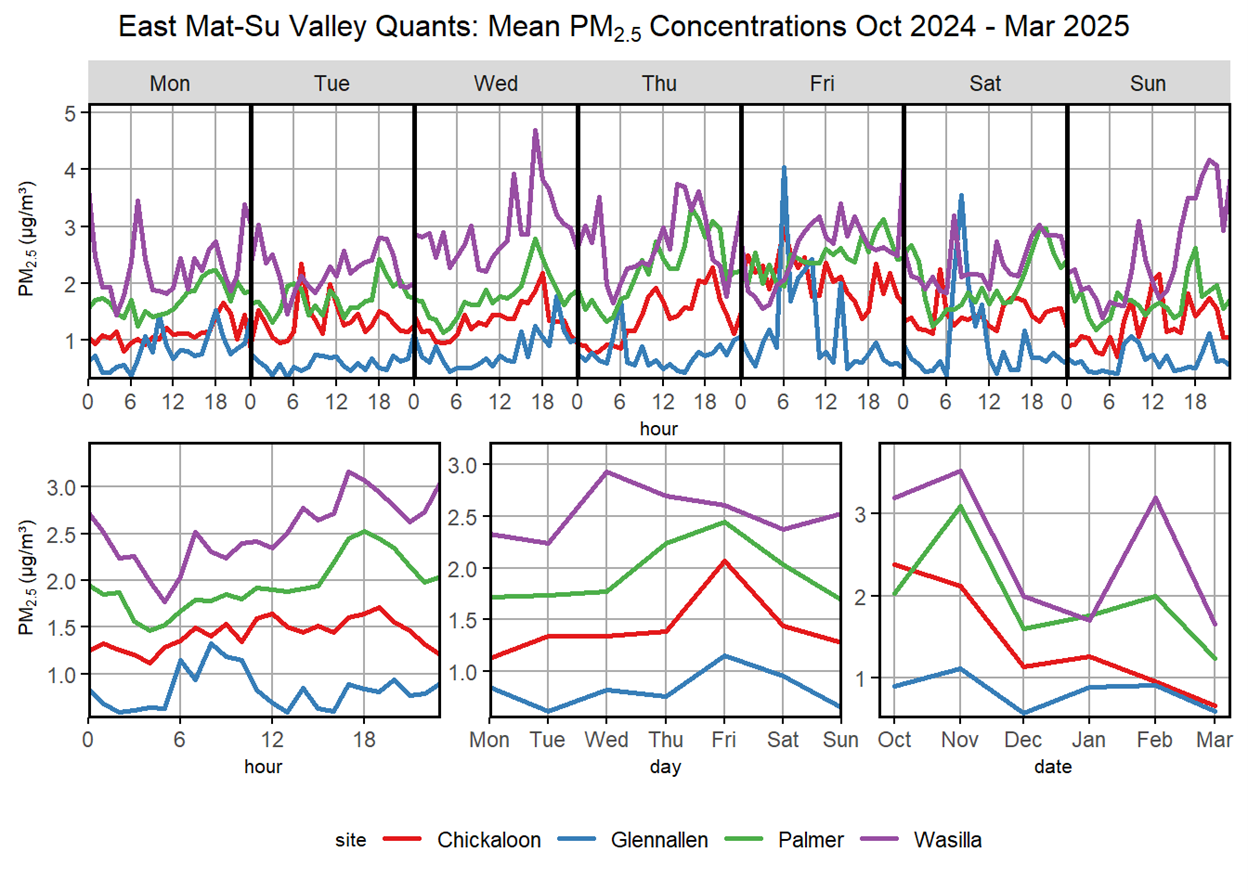
Figure 4 depicts the time series and diurnal graphs of PM2.5 concentrations for Chickaloon, Palmer, and Wasilla in the eastern Mat-Su Valley area and Glennallen in the Copper River Valley area. Generally, these communities have ‘Good’ (AQI) air quality and relatively little diurnal variation over an average day and week. Notable features of historical PM2.5 levels include concentration spikes on Friday and Saturday mornings in Glennallen, spikes on Wednesday and Sunday evenings in Wasilla, and spikes on Friday afternoon in Chickaloon and Palmer. Over the course of the reporting period, all communities maintained low average PM2.5 levels.
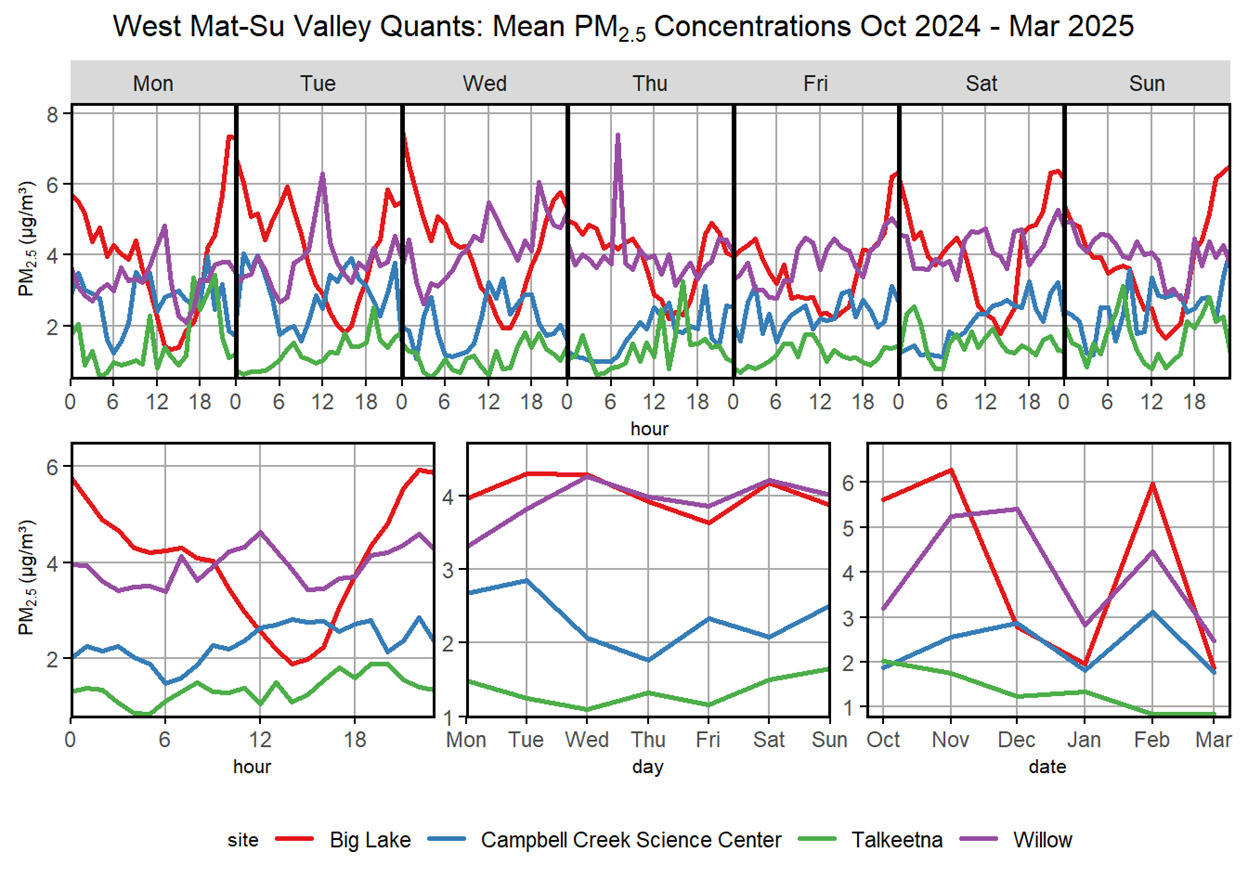
Figure 5 depicts the time series and diurnal graphs of PM2.5 concentrations for several southcentral communities in the western Mat-Su Valley area: Big Lake, Campbell Creek Science Center (CCSC ) in Anchorage, Talkeetna, and Willow. Generally, these communities have ‘Good’ (AQI) air quality. For all communities, there was little variation in PM2.5 levels over the course of an average week; moderate rises in PM2.5 were seen on the weekends, but overall variation was minimal. Over the interim reporting period, these communities experienced an initial rise in PM2.5 levels, potentially corresponding to colder temperatures and increasing use of home heating devices in the early winter.
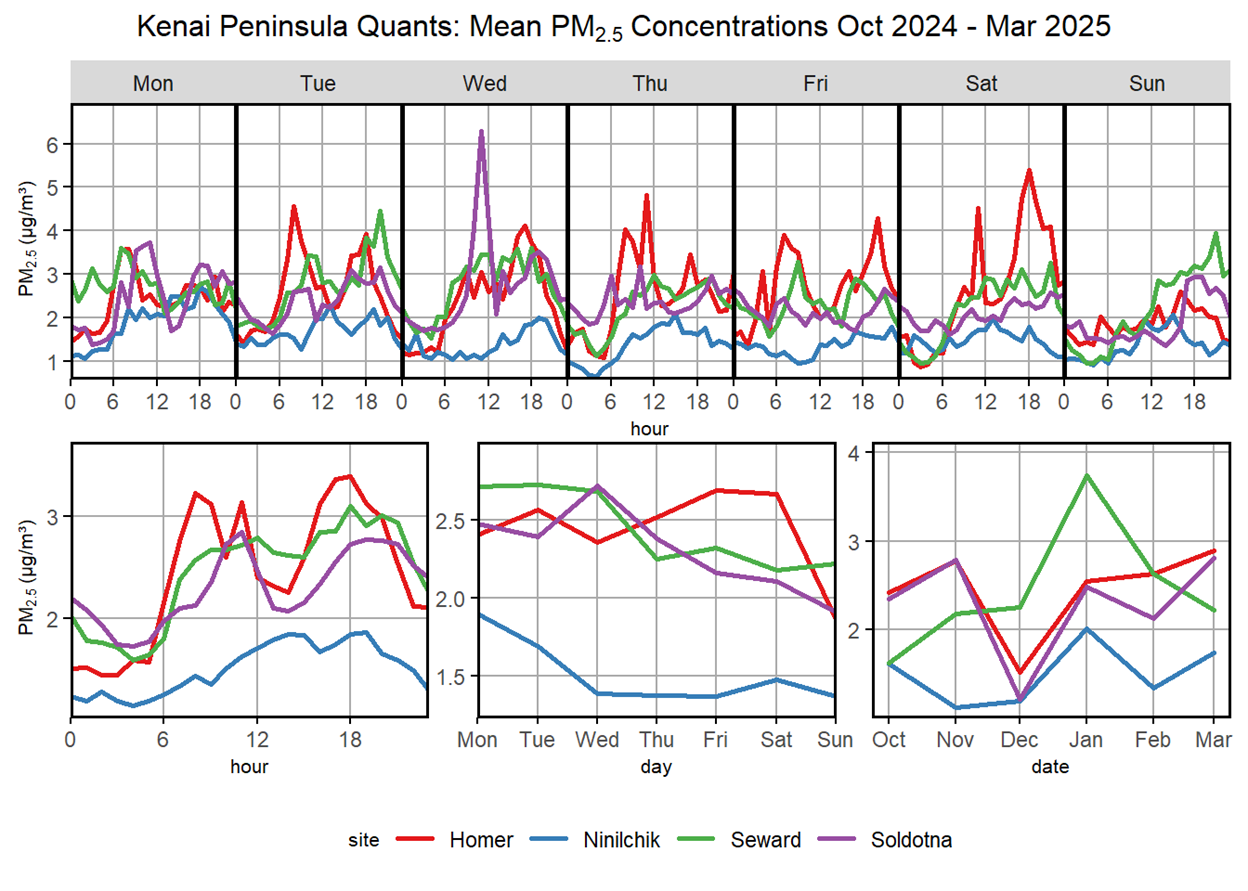
Figure 6 depicts the time series and diurnal graphs of PM2.5 concentrations for communities on the Kenai Peninsula. With the exception of Ninilchik, these communities show similar weekly trends in PM2.5 concentration, characterized by relatively steady levels for the first half of the week, which slowly decrease over the latter half of the week. In Homer, PM2.5 levels are consistently at their lowest on Sundays. Daily PM2.5 concentration shows more variation, with Homer, Seward, and Soldotna experiencing a typical pattern of higher levels in the mornings and evenings and lower levels during midday. Ninilchik experienced a muted daily and weekly pattern, with PM2.5 levels showing gradual increases in the evenings, and slightly higher average levels on Mondays, Tuesdays and Saturdays. Overall, PM2.5 levels in Ninilchik remained quite low, with hourly and daily averages never exceeding 2 µg/m3. All communities on the Kenai Peninsula recorded very low PM2.5 concentrations over the reporting period.
The Soldotna data for the month of February is not representative, as the pod’s PM2.5 sensor went offline from February 5-14th.
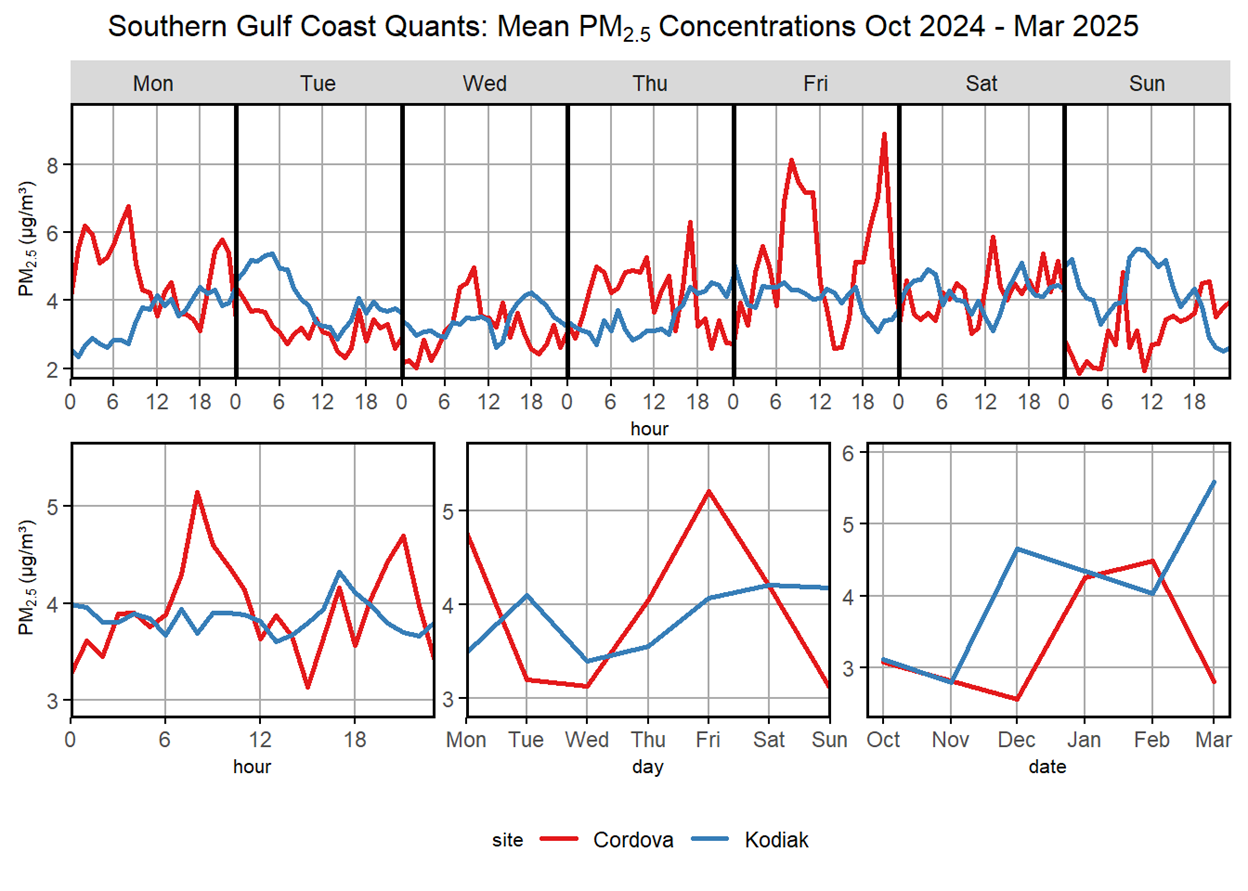
Figure 7 depicts the time series and diurnal graphs of PM2.5 concentrations for the southern gulf coast communities of Cordova and Kodiak. Both communities generally have ‘Good’ (AQI) air quality. Kodiak exhibits relatively low diurnal variation in PM2.5 levels across an average day and week, whereas Cordova demonstrates more variability, including PM2.5 spikes during the morning and afternoon hours, as well as a distinct rise in PM2.5 on Mondays and later in the work week. Kodiak saw an increase in PM2.5 levels over the course of the interim reporting period, though both communities maintained very low mean PM2.5 concentration levels over the reporting period.
Due to a roof leak and reconstruction at the host building, the Kodiak pod was taken offline on March 6, 2025, and moved to a secure location. The pod was not reconnected until April 8, after the end of the interim reporting period. As a result, the apparent increase in PM2.5 levels in March is not an accurate representation of the community air quality. The re-installed Kodiak pod was only active for the first week of March and detected elevated PM2.5 over two of those nights which produced a skewed monthly average.
Due to technical and performance issues, the original Cordova pod was taken down and replaced with a new pod on January 23, 2025.
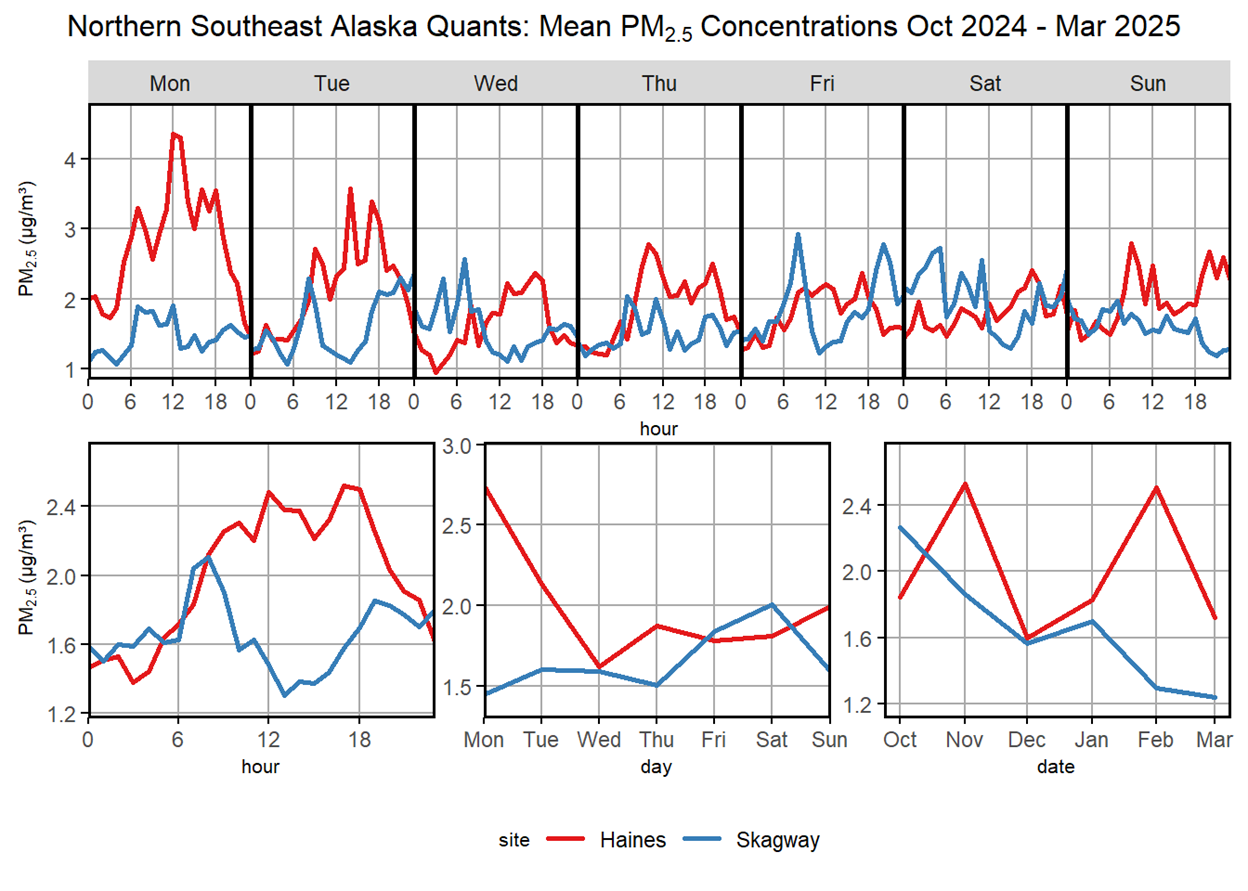
Figure 8 depicts the time series and diurnal graphs of PM2.5 concentrations for Haines and Skagway. Daily PM2.5 concentrations are generally similar in both communities, with baseline levels staying below 3 µg/m3, although the daily patterns appear to be different. Skagway exhibits a typical pattern of PM2.5 spikes at the start and end of the workday, and an increase in PM2.5 on Fridays and Saturdays. Haines appears to follow a similar but more pronounced pattern; PM2.5 levels rise in the morning hours but stay elevated during midday and spike higher in the evening before dropping down at night. Skagway observed decreasing PM2.5 levels over the reporting period, whereas Haines experienced an increase in average PM2.5 levels later in the reporting period, likely due to two days with moderately elevated midday PM2.5 in mid-February. Both communities experienced very low mean PM2.5 concentrations over the reporting period.
On October 5th, a structure fire occurred about 580 meters from the Haines sensor. Hourly PM2.5 averages approached 300 µg/m3. This event significantly skewed Haines’ PM2.5 data over the interim period so data from October 5th and 6th have been removed from Fig. 8 to show more representative ambient air quality in Haines during the reporting period.
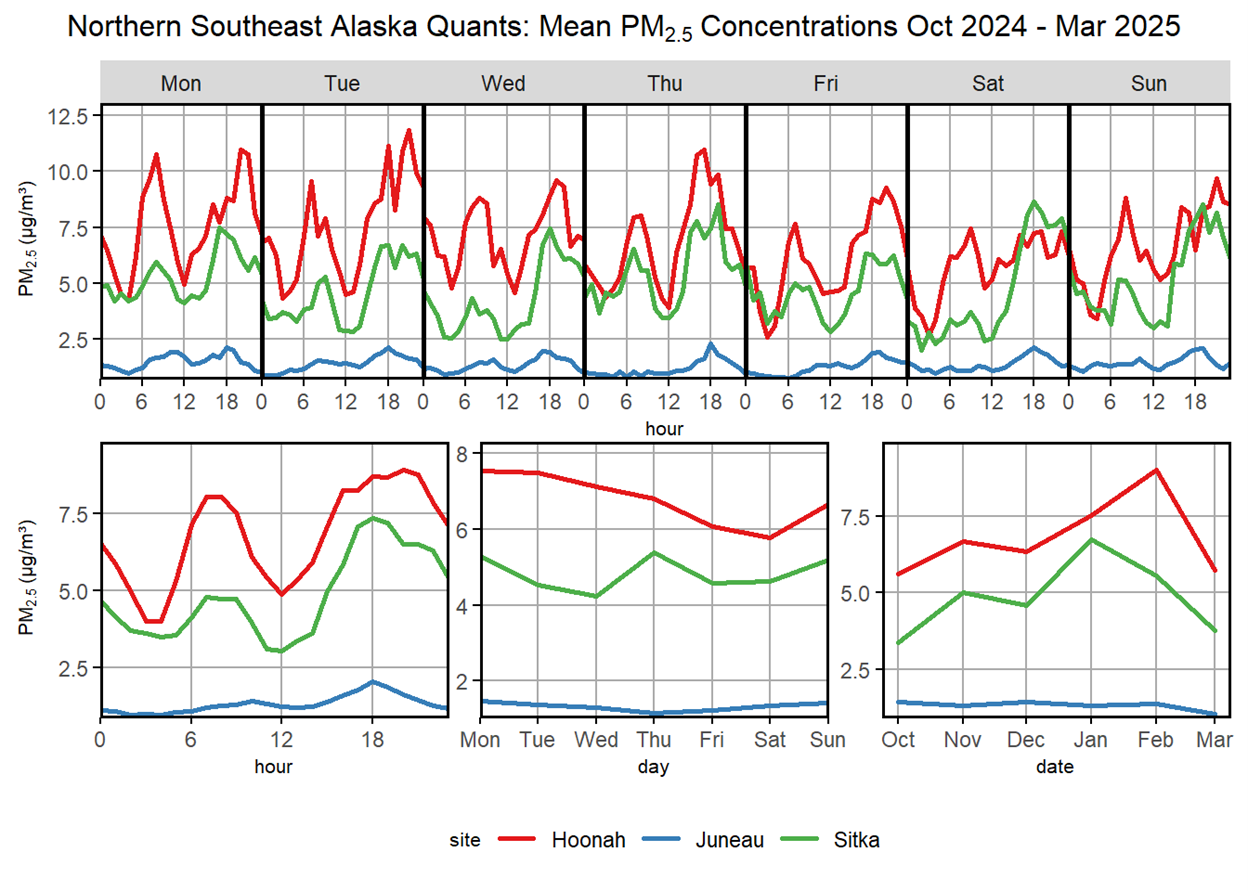
Figure 9 depicts the time series and diurnal graphs of PM2.5 concentrations for Hoonah, Juneau, and Sitka, three communities in the northern part of the Southeast ecoregion. Hoonah and Sitka exhibit similar patterns of PM2.5 concentration across different temporal scales, while Juneau maintains both a low concentration and low diurnal variation of PM2.5. Juneau experiences small increases in PM2.5 concentration during the morning and evening hours during the first half of the week, but only evening surges in the latter half of the week. Overall levels in Juneau were remarkably low, with hourly PM2.5 averages typically below 2.5 µg/m3. PM2.5 variation across the week is minimal, with Sitka seeing an average increase on Thursdays, while Hoonah reaches a PM2.5 concentration low on Saturdays. Both communities experienced increasing PM2.5 levels as the winter progressed, with Sitka experiencing a monthly average peak in January, and Hoonah in February.
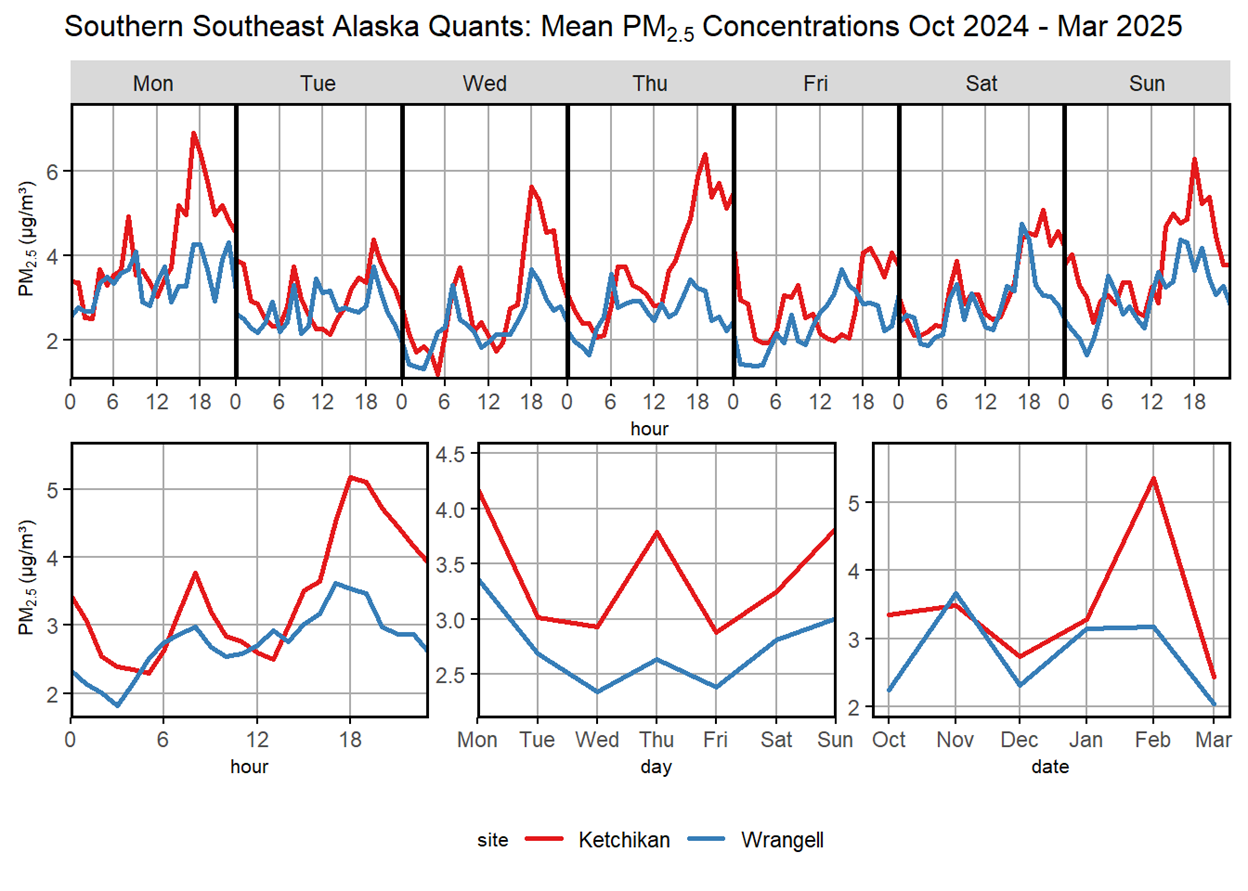
Figure 10 depicts the time series and diurnal graphs of PM2.5 concentrations for Ketchikan and Wrangell, two communities near the southern tip of the Southeast ecoregion. Both communities demonstrate similar patterns in PM2.5 concentration trends, with spikes seen in the morning and evening. Ketchikan has slightly higher (0.5-1.0 µg/m3) average PM2.5 levels over the week, and experienced higher peak PM2.5 levels, particularly in the evenings. Both communities demonstrate a trend of higher PM2.5 levels on Sunday and Monday than most weekdays. PM2.5 levels in Ketchikan were elevated in February, potentially due to increased home heating emissions due to the cold weather.
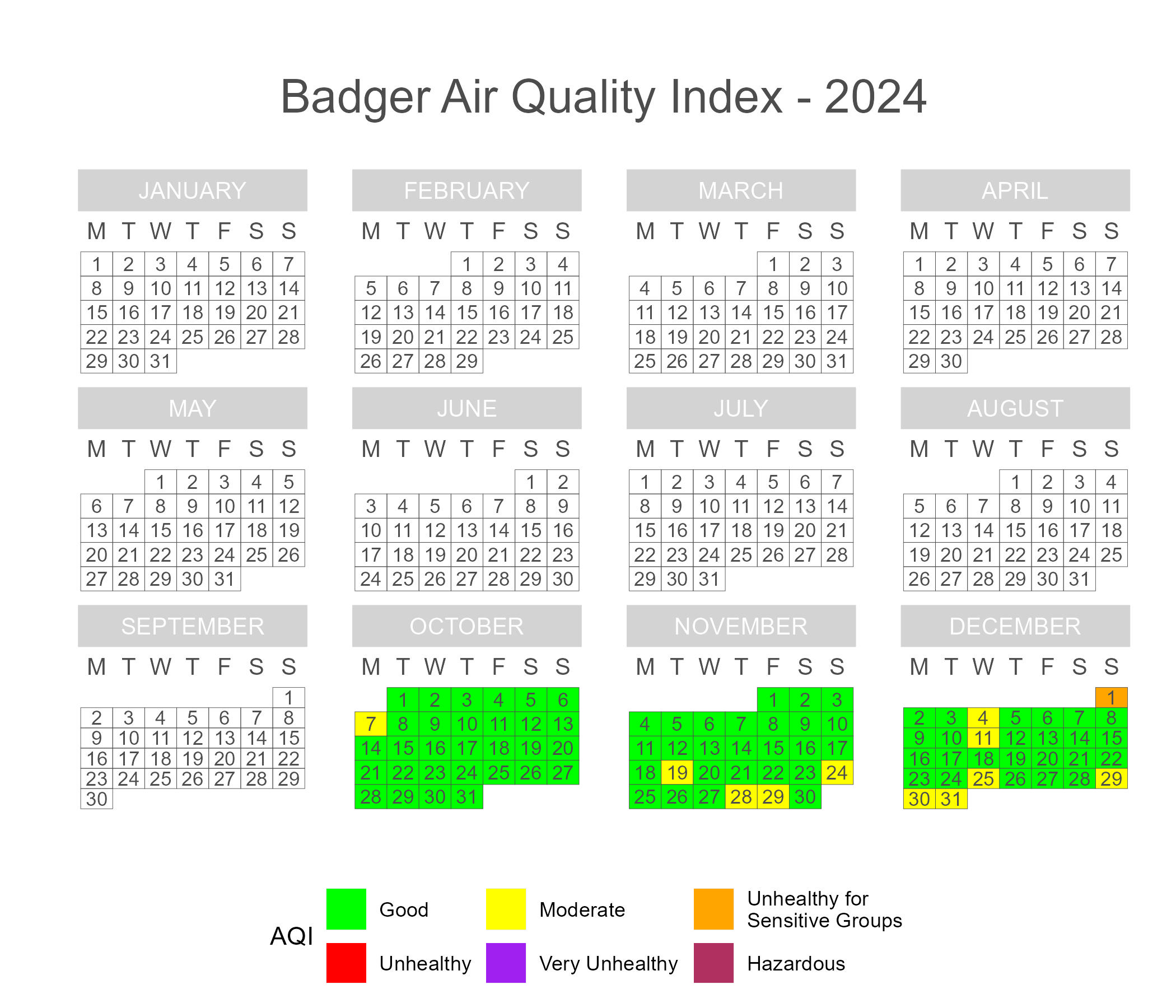
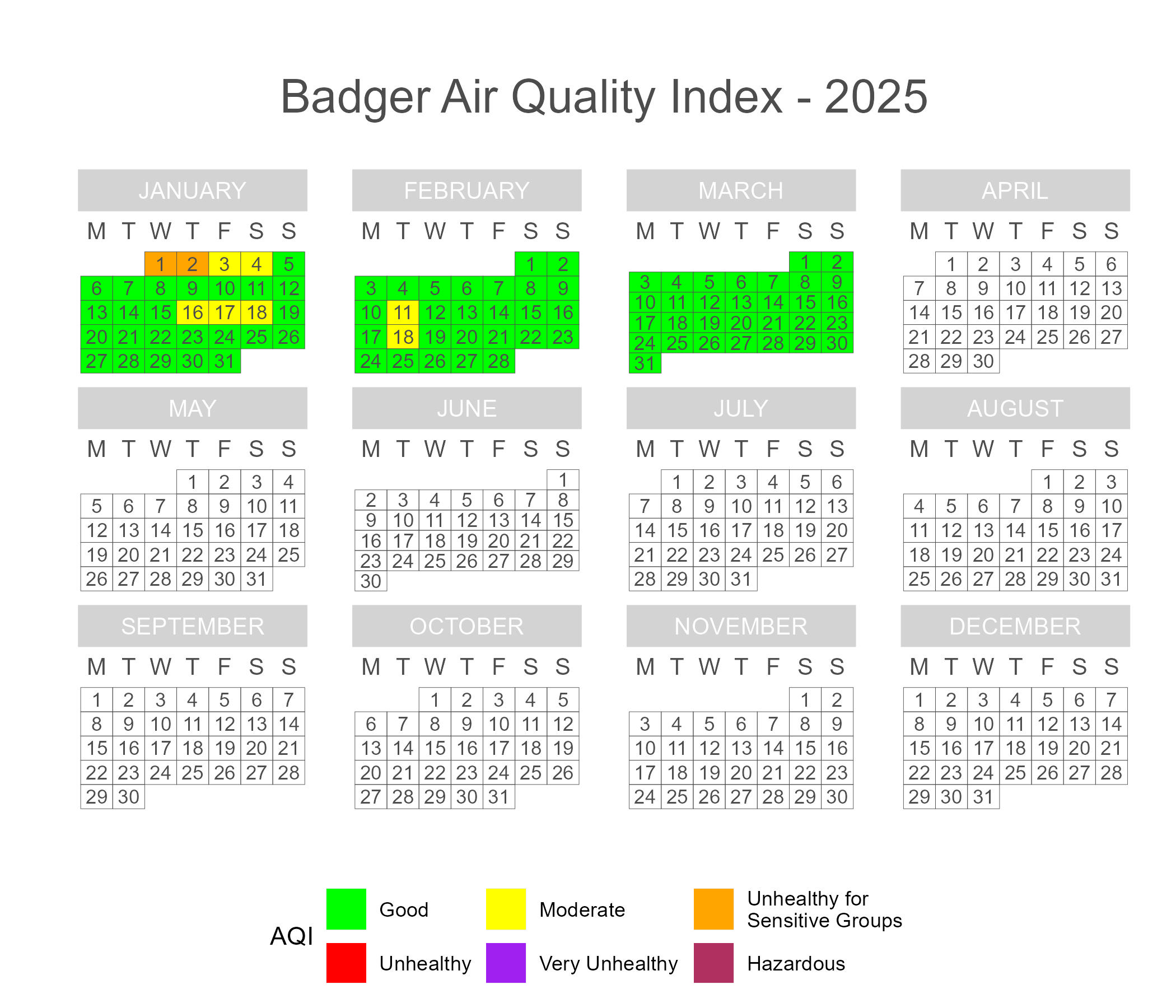
Figure 11 and Figure 12 depict calendar plots for the Badger Road area during the reporting period. For much of the period, air quality in the Badger Road area remained in the ‘Good’ AQI range. However, the Badger Road area experienced poorer air quality on several occasions, potentially due to extreme cold temperatures throughout the winter that created inversion conditions that trapped particulates at the ground level, leading to daily averages that reached the ‘Moderate’ AQI range. The most severe cold weather incidents occurred at the end of November going into December, and again at the end of December going into January, where AQI levels reached ‘Unhealthy for Sensitive Groups’.
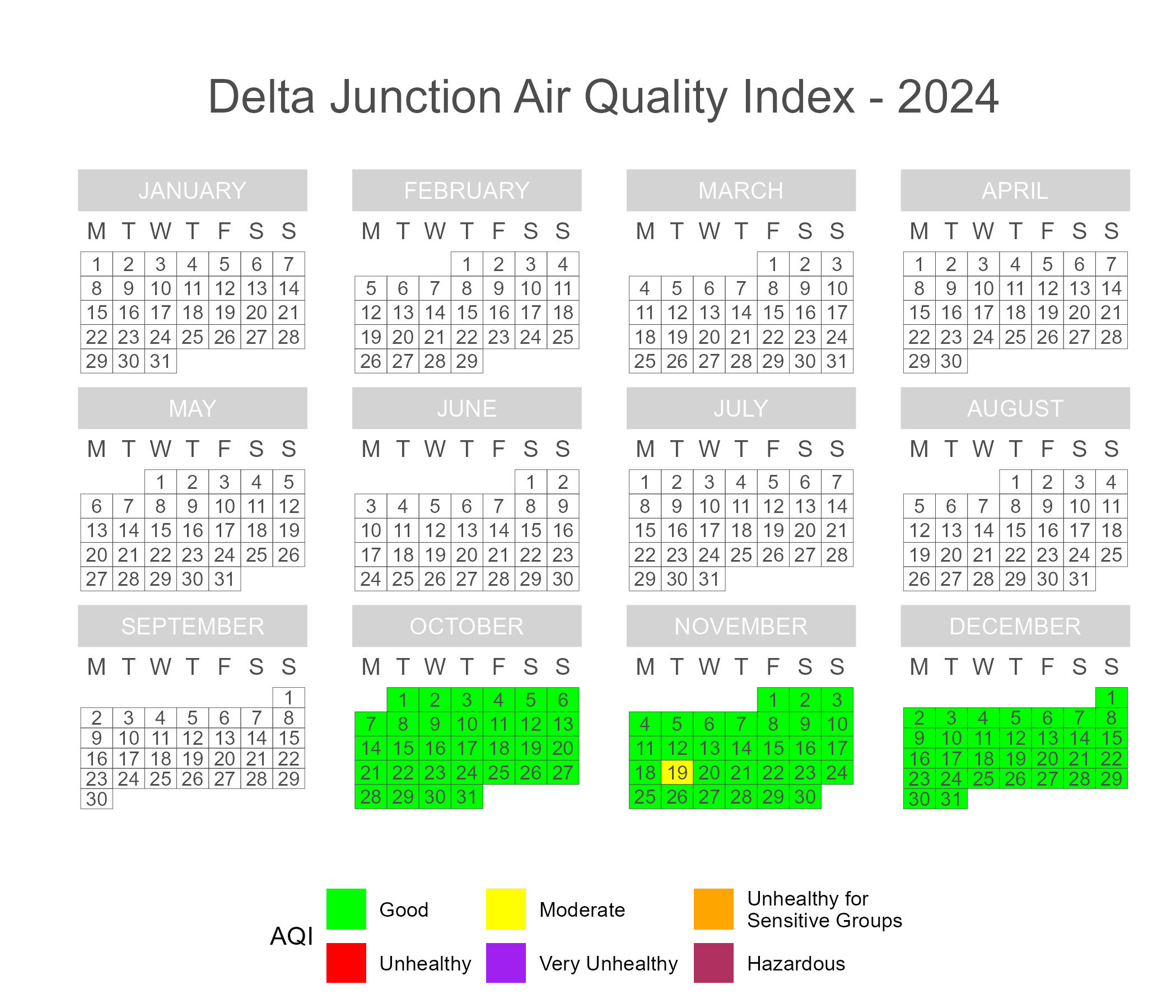
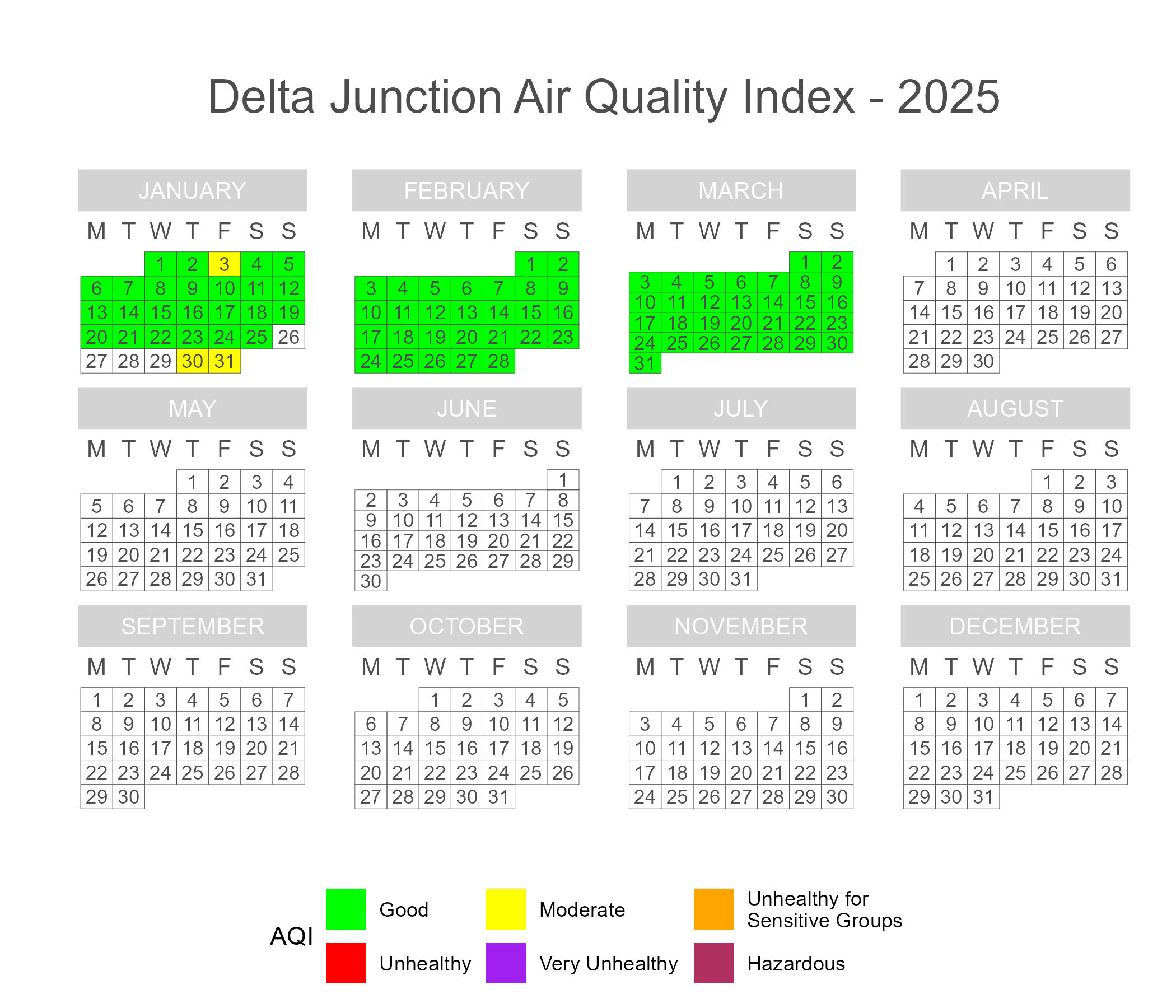
Figure 13 and Figure 14 depict calendar plots for the community of Delta Junction during the reporting period. For much of the reporting period, air quality in Delta Junction remained in the ‘Good’ AQI range. Across the reporting period, only four days reached the ‘Moderate’ AQI level; each incident corresponds to extreme cold weather events and inversion conditions in Delta Junction, where emissions from vehicles and home heating equipment cannot easily disperse in the atmosphere and instead accumulate in the community air space at ground level. The multi-day outage in late January was due to strong winds that may have knocked over trees, leading to power outages in the region.
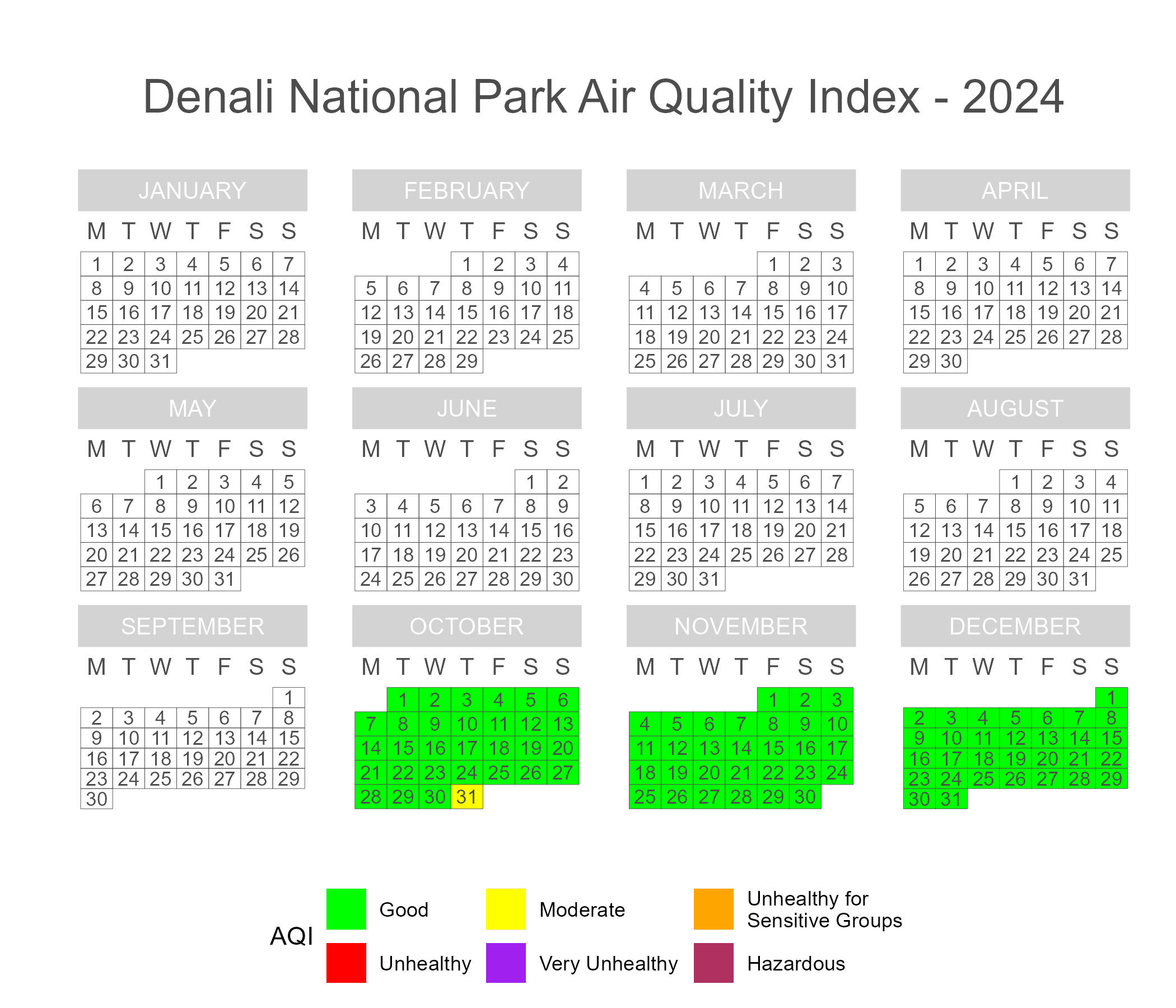
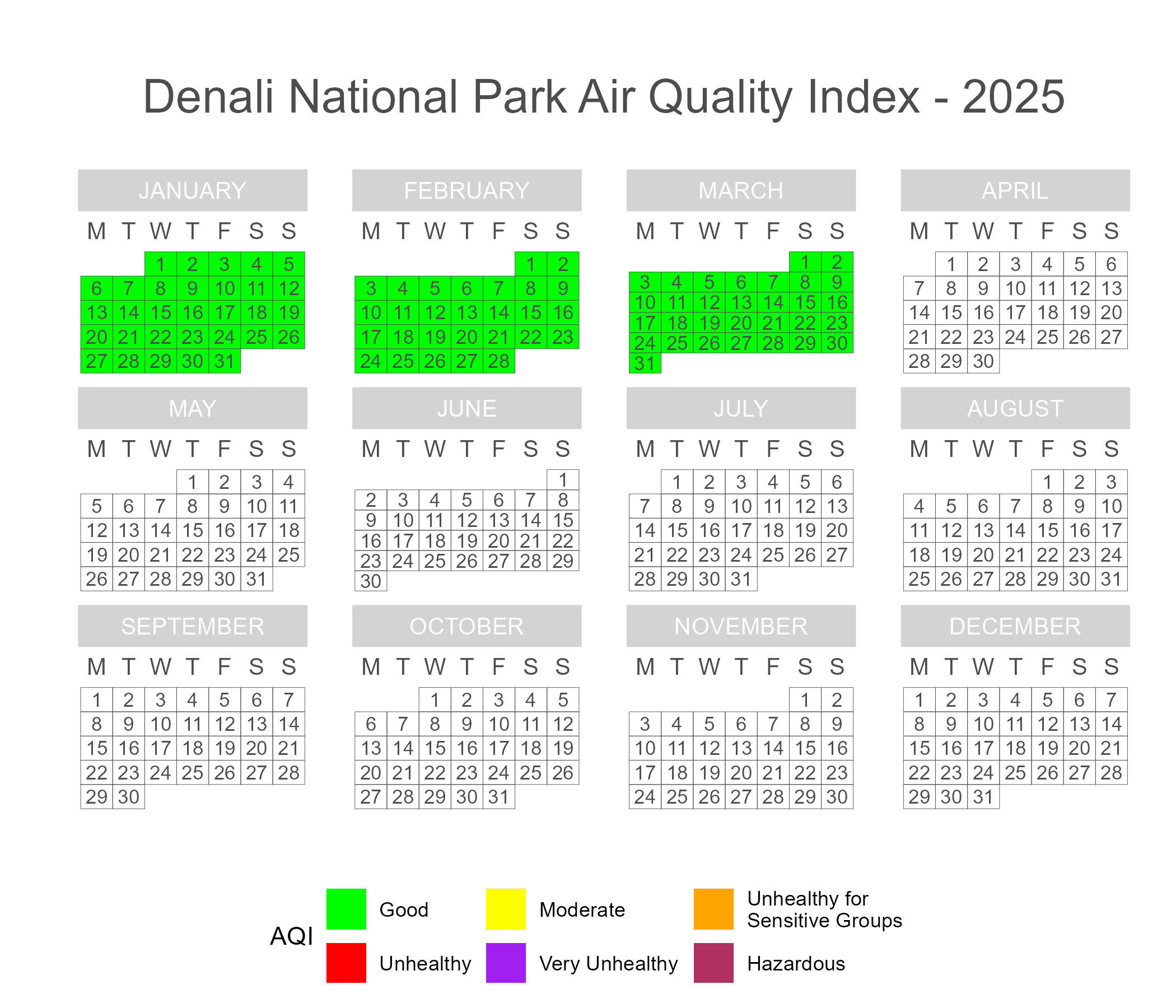
Figure 15 and Figure 16 depict calendar plots for the Denali NP pod during the reporting period. Denali NP enjoyed air quality in the ‘Good’ AQI range for nearly the entire reporting period, with only a single day at the ‘Moderate’ AQI level. On October 31st, 2024, the Denali NP Fire Crew executed a study on slash pile burn techniques. This involved burning multiple large piles of plant debris at several locations near the Denali NP Headquarters and the air sensor. The pod detected a temporary spike in PM2.5 levels above 600 µg/m3, which raised the daily average into the ‘Moderate’ AQI range. The slash pile burn study was an isolated event; it is not regularly occurring and does not have seasonal or recurrent effects on air quality in Denali NP.
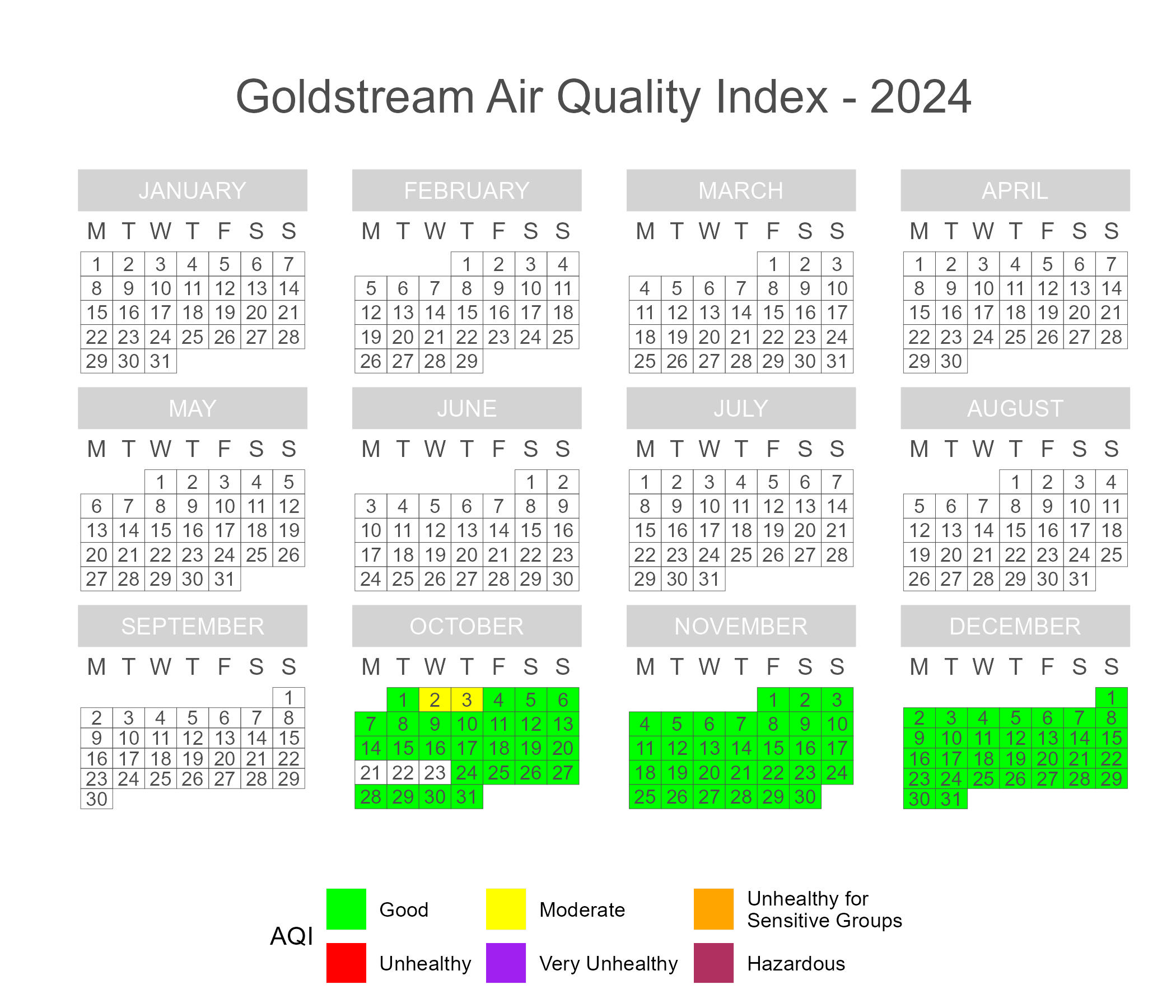
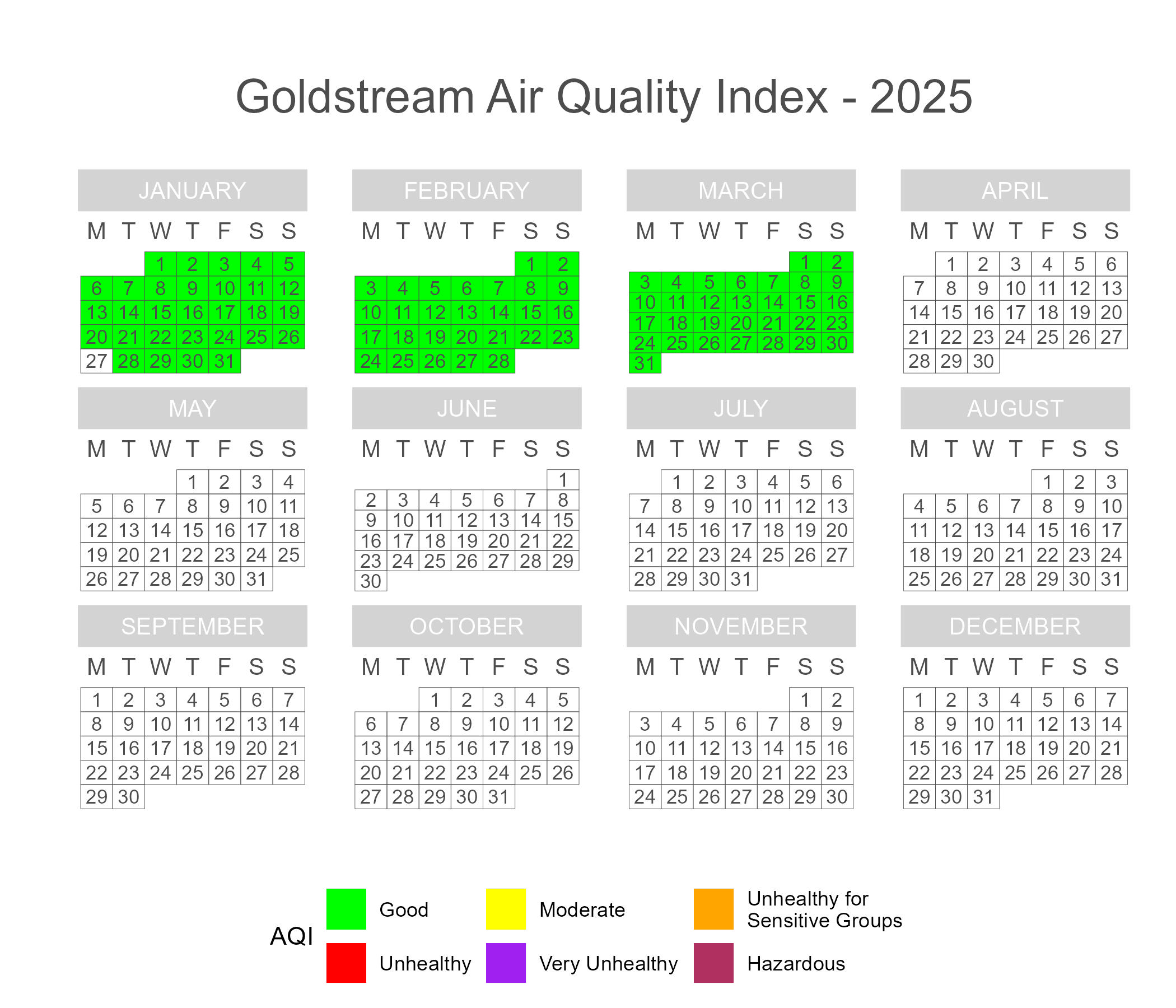
Figure 17 and Figure 18 depict calendar plots for the Goldstream area during the reporting period. For much of the period, air quality in Goldstream remained in the ‘Good’ AQI range. The air monitor is installed at a recreational sports store, which sometimes has large crowds and idling vehicles in its parking lot for athletic events or equipment sales. On October 2nd-3rd, the sports store hosted the bib pick-up for a popular community race; heavy vehicle and pedestrian traffic kicked up a lot of dust, leading to daily averages in the ‘Moderate’ AQI range. The Goldstream pod experiences occasional outages due to the air monitor sharing a popular electrical outlet. During the occasional outages, DEC reached out to contacts at the sports store to request a power cycle or outlet reset, which was typically sufficient to get the pod back online.
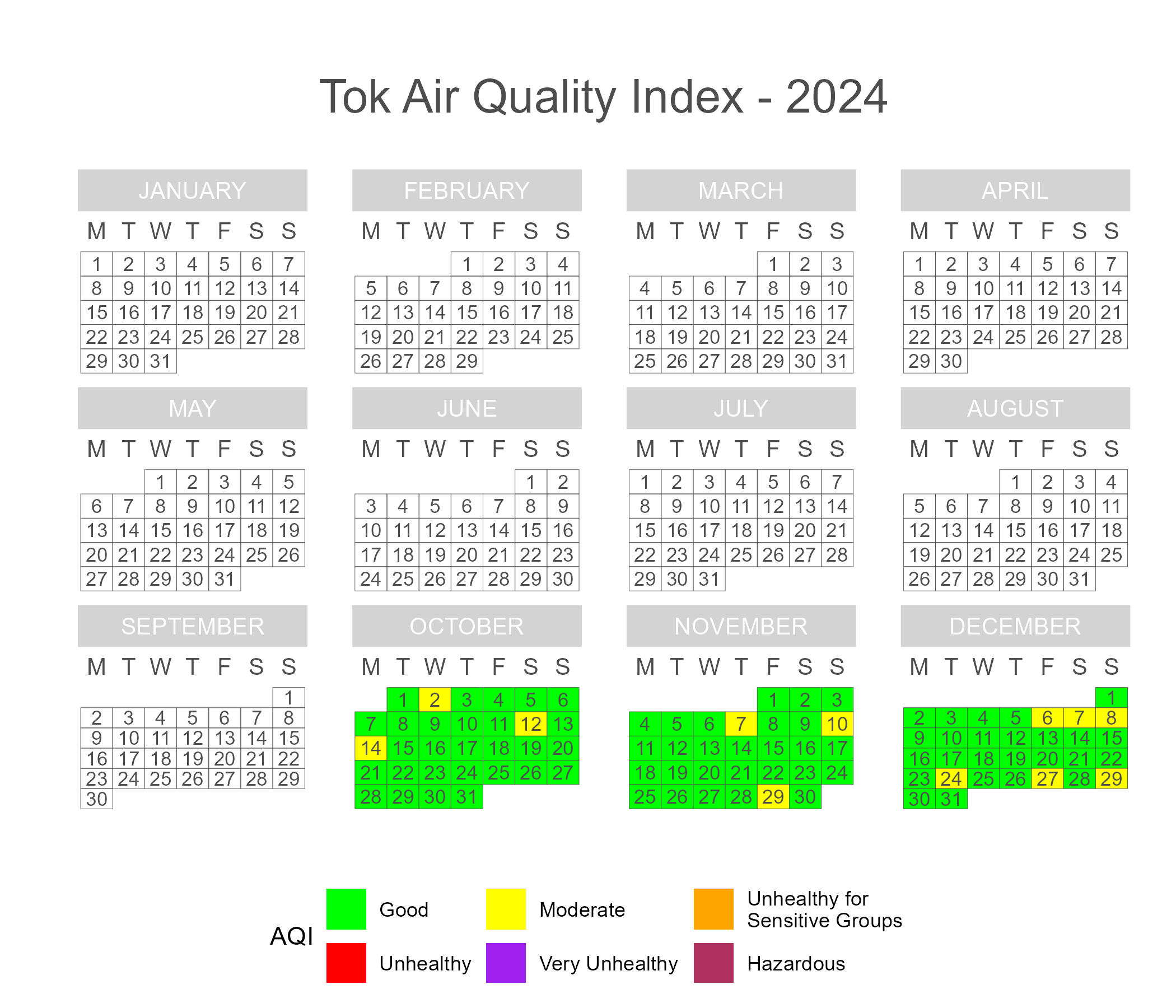
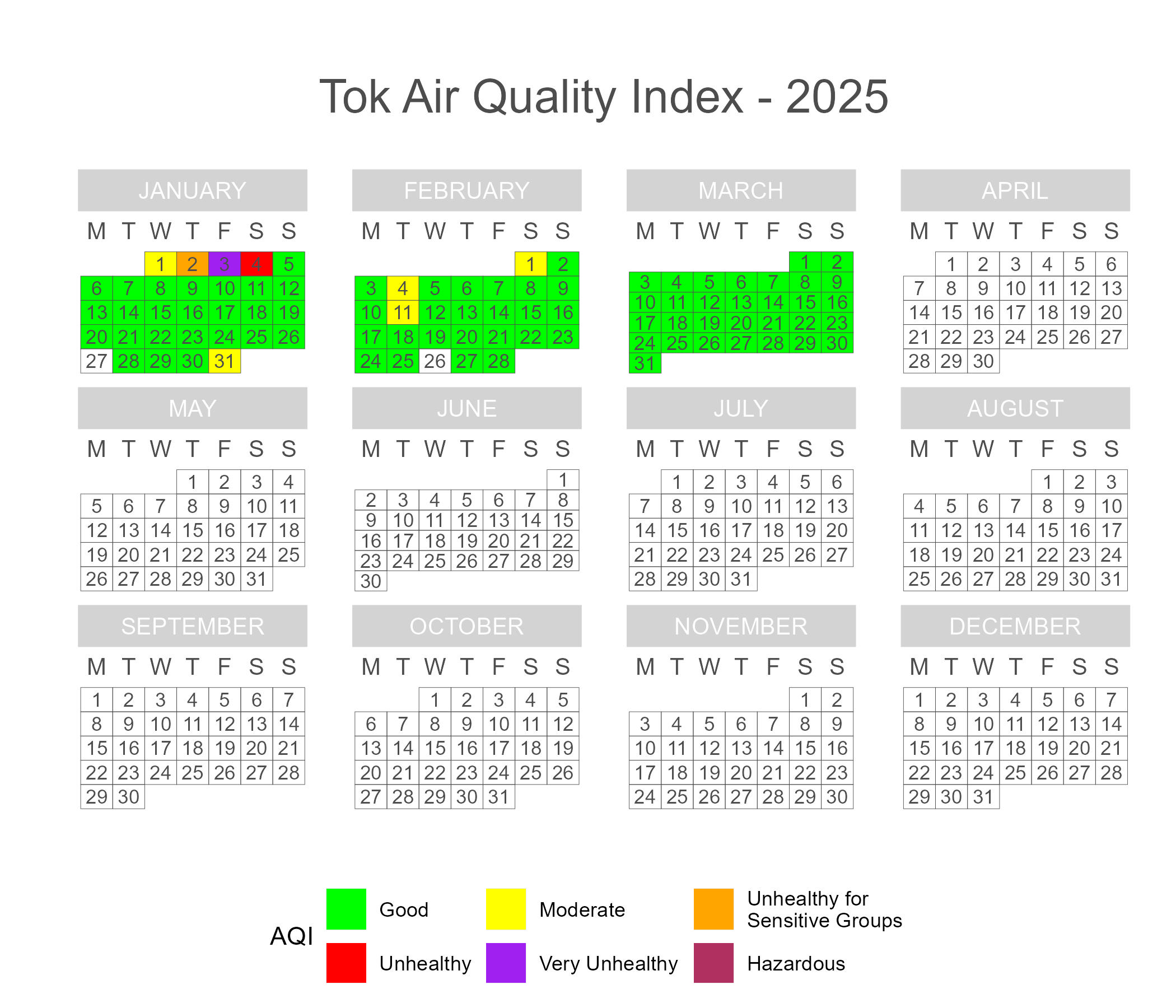
Figure 19 and Figure 20 depict calendar plots for the community of Tok during the reporting period. For much of the period, air quality in Tok remained in the ‘Good’ AQI range, although the community’s geographic location makes it susceptible to inversion events. A period of extremely cold weather at the end of December and beginning of January lead to a strong inversion event, which trapped air pollution at ground level resulting in drastically elevated PM2.5 levels in Tok for four days. The event peaked on January 3rd when PM2.5 levels reached the Very Unhealthy’ AQI range. January 4th reported ‘Unhealthy’ AQI levels, and air quality had returned to ‘Normal’ AQI by January 5th. The single-day outage in late January was due to strong winds that may have knocked over trees, leading to power outages in the region. On February 26th, the pod experienced operational issues and failed to generate sufficient data to calculate a daily PM2.5 average.
Due to performance issues, the original pod at Tok (MOD 444) was replaced (by MOD 653) on December 2nd, 2024; the replacement pod came online quickly, so the pod swap did not significantly disrupt data collection.
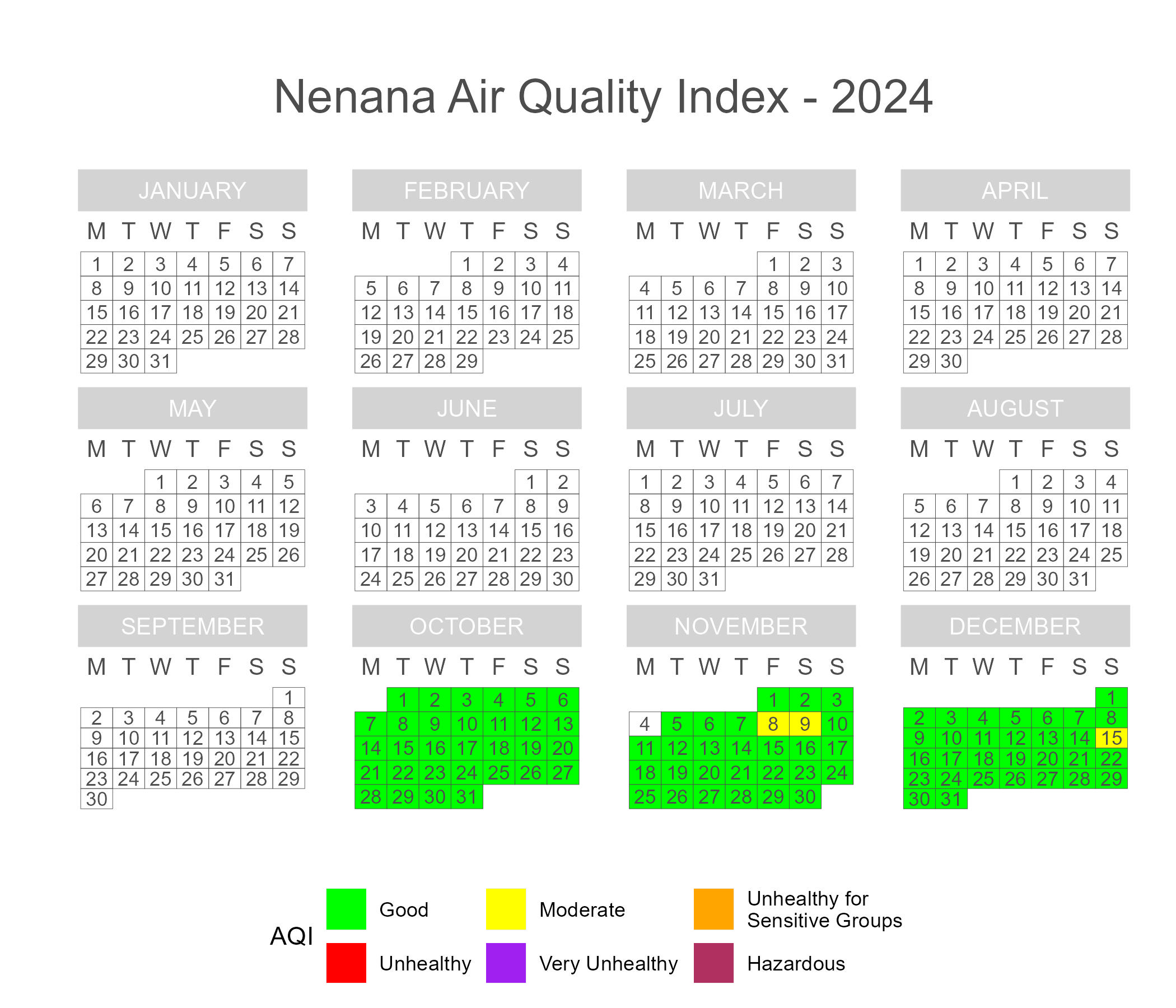

Figure 21 and Figure 22 depict calendar plots for the community of Nenana during the reporting period. Nenana generally has air quality in the ‘Good’ AQI range. December 15th and January 1st and 15th saw very cold temperatures leading to increases in PM2.5 levels into the ‘Moderate’ AQI range. On March 1st, Nenana hosted the Tripod Days event, which is a special event celebrating warming temperatures and the onset of spring. This event involved an influx of visitors to Nenana, several outdoor community activities, and increased vehicle and pedestrian traffic, which contributed to pushing local air quality into the ‘Moderate’ AQI range. On November 4th, the pod experienced operational issues and failed to generate sufficient data to calculate a daily PM2.5 average.
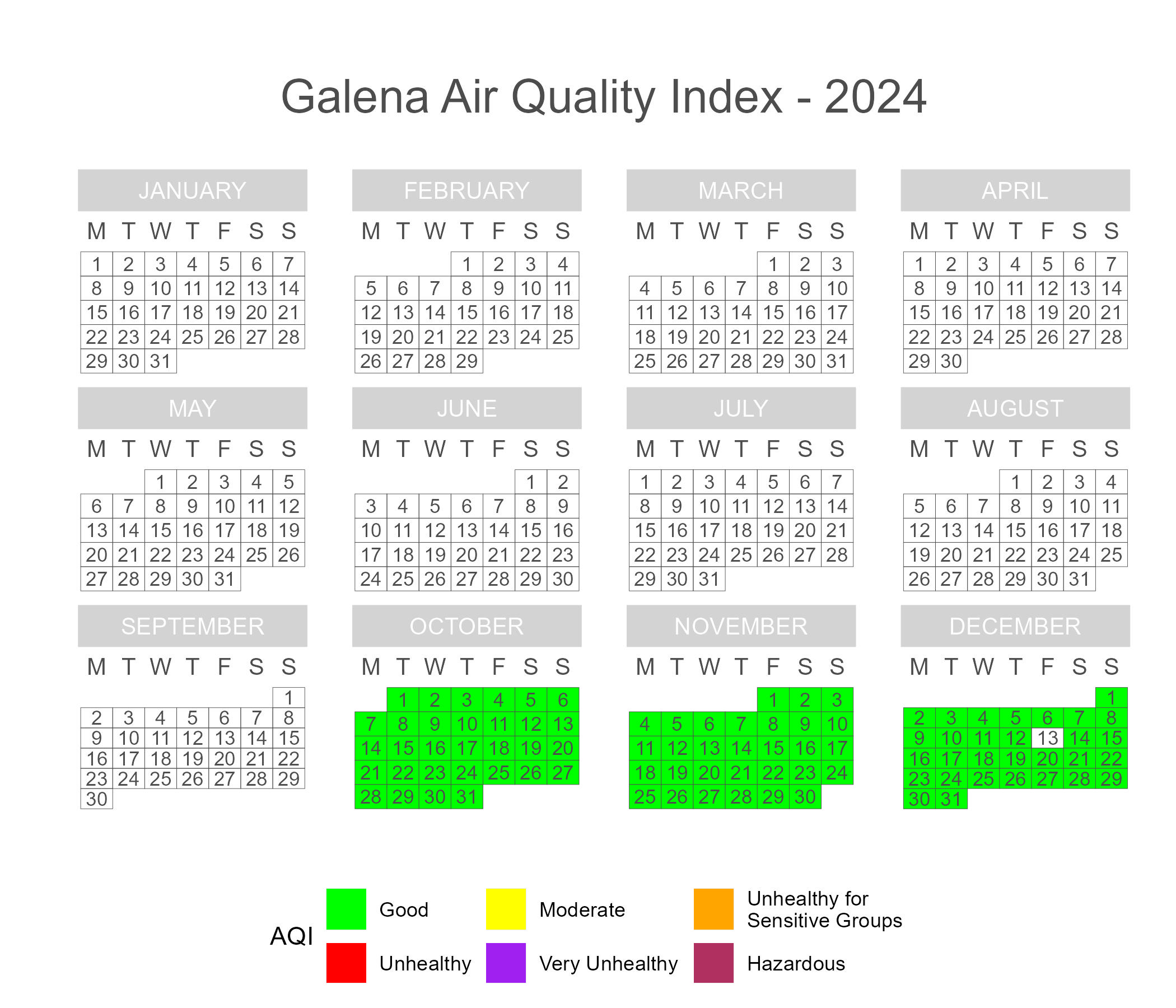
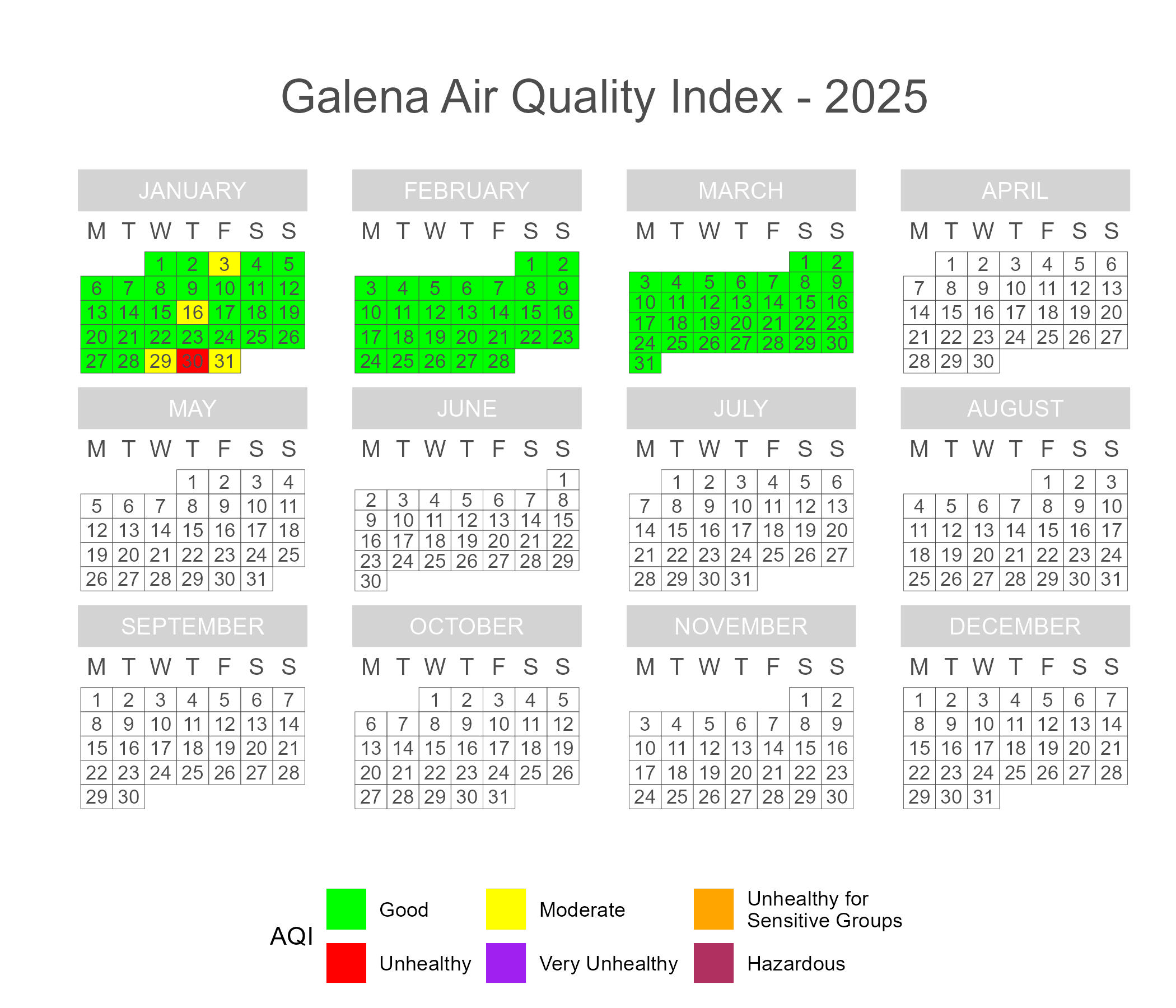
Figure 23 and Figure 24 depict calendar plots for the community of Galena during the reporting period. Generally, Galena experiences good air quality with daily averages in the ‘Good’ AQI range. In January, Galena experienced several days with air quality in the ‘Moderate’ AQI range, and a day with average air quality in the ‘Unhealthy’ AQI range. On each of these dates, Galena was experiencing very cold weather and inversion conditions, which trapped pollutants at ground level and raised local PM2.5 levels. January 30th saw the most extreme cold temperatures, the strongest inversion conditions, and the highest PM2.5 levels of any day in the month. On December 13th, the pod experienced operational issues and failed to generate sufficient data to calculate a daily PM2.5 average.
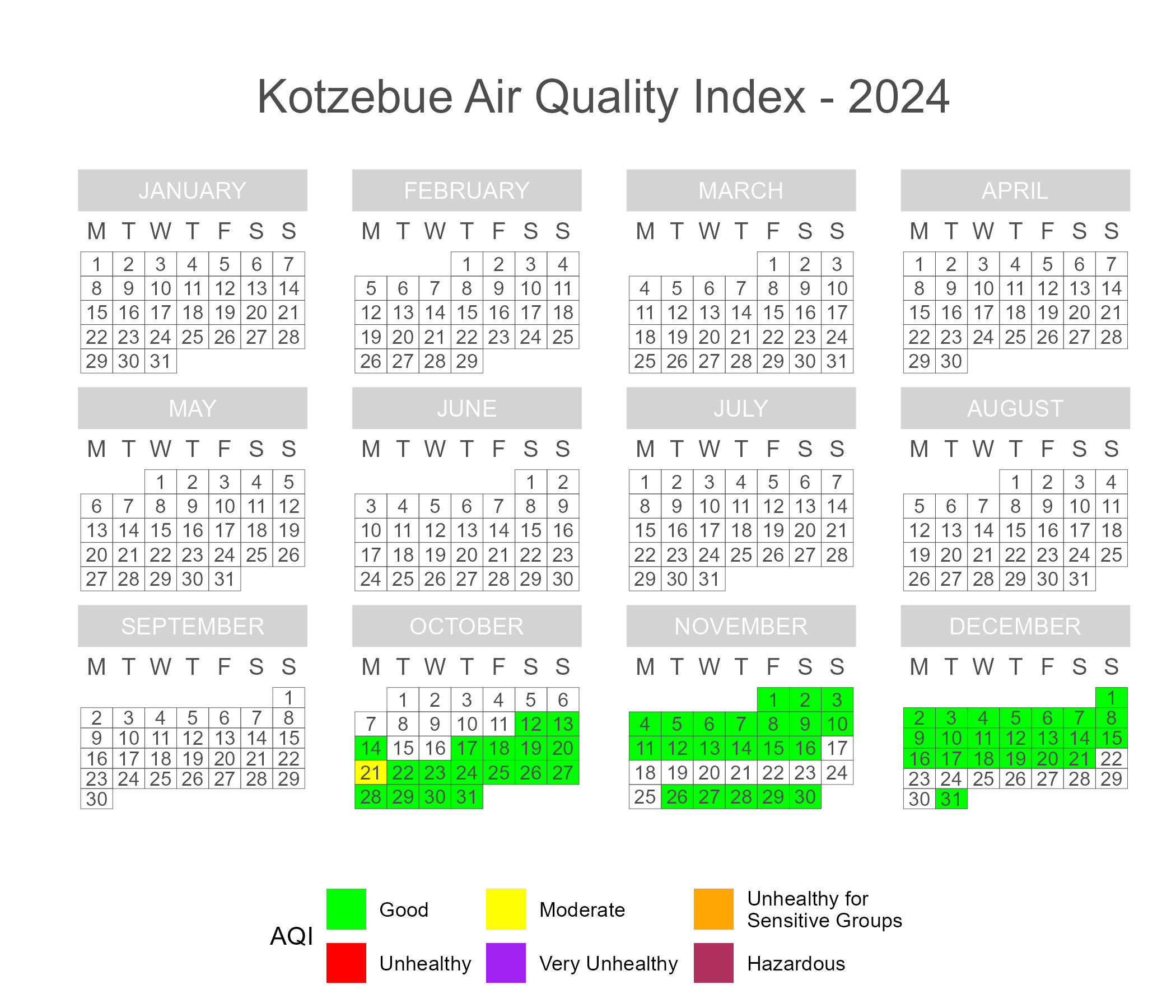
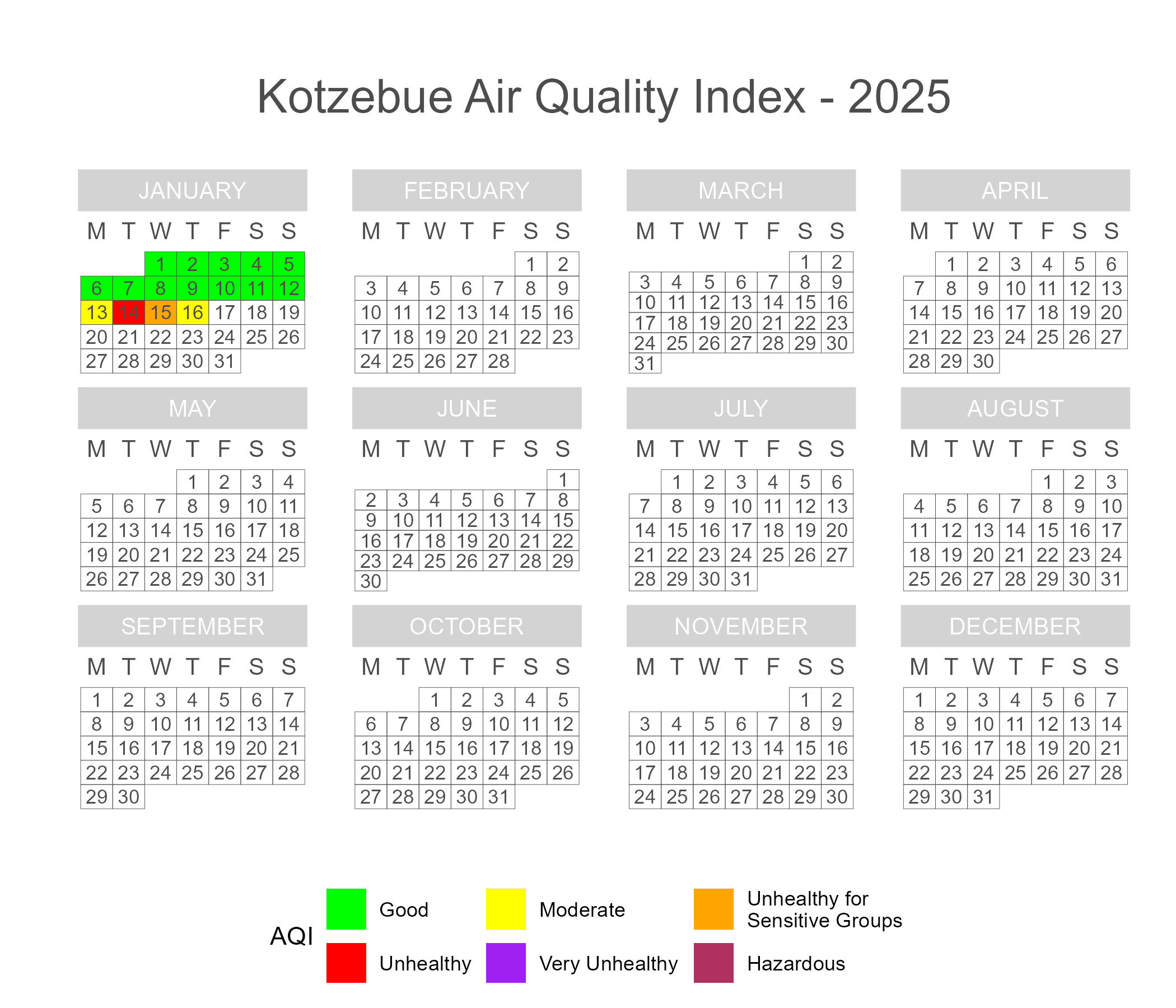
Figure 25 and Figure 26 depict calendar plots for the community of Kotzebue during the reporting period. On August 14th, near the end of the previous interim reporting period, the QuantAQ ModulairTM pod was taken down and reinstalled in a new location due to construction activities. The pod was re-activated on October 11th and generated enough data to begin calculating daily averages on October 12th. The pod experienced an outage from November 17th-25th due to a large blizzard in the area that disrupted power lines. The pod experienced another outage from December 22nd-30th, likely due to the power cable being accidentally unplugged. The second week of January saw a drop in temperature which was simultaneous with an increase in PM2.5 levels that peaked on January 14th in the ‘Unhealthy’ AQI range.
The pod suddenly went offline on the morning of January 17th due to a severed subsea cable off the western coast of Alaska. Quintillion’s network hosts several internet and cellular providers, including AT&T (which the QuantAQ ModulairTM pods use to transmit data), which all saw disruptions to their service due to the cable break. At the time of this report, the cable has not been repaired and cellular service has not been restored.
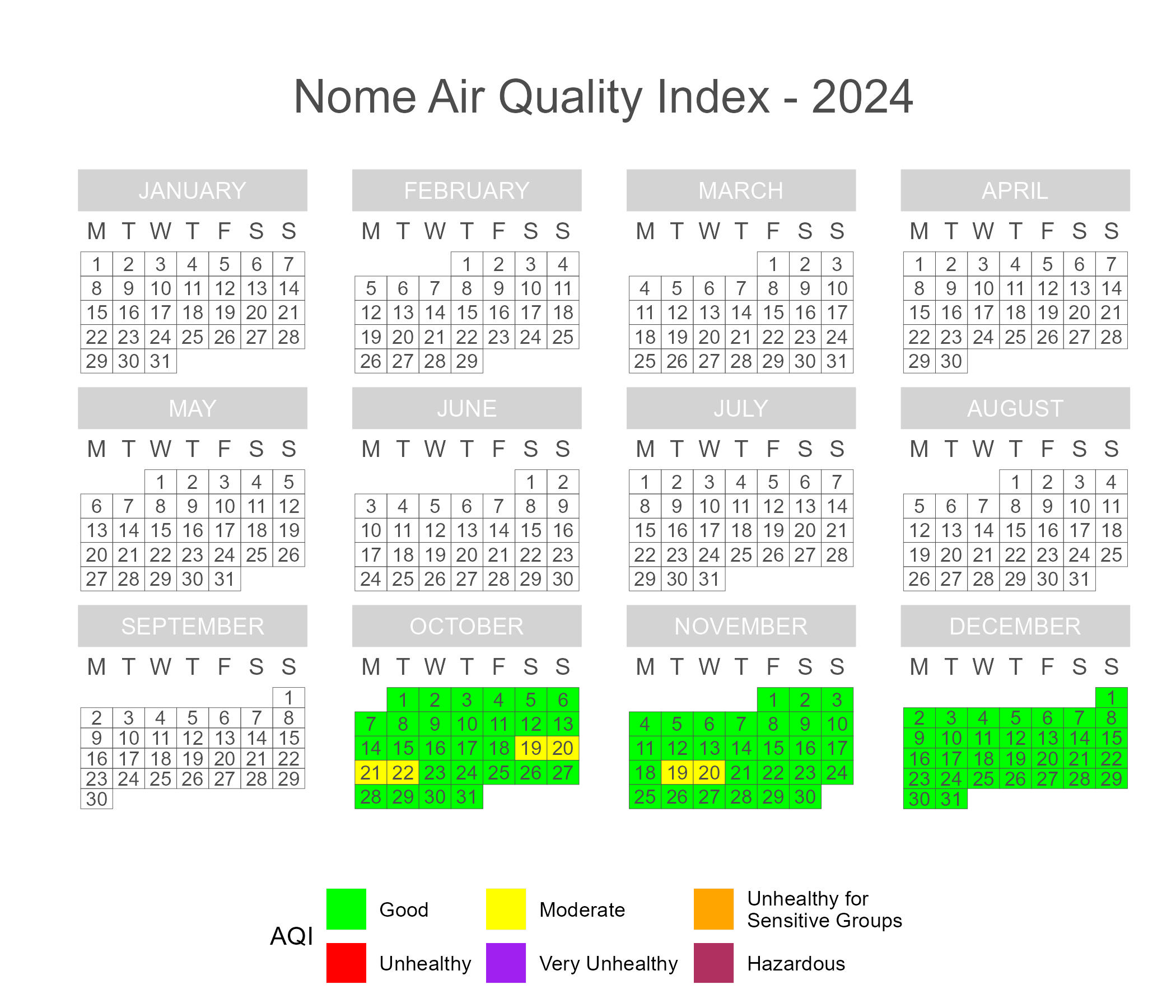
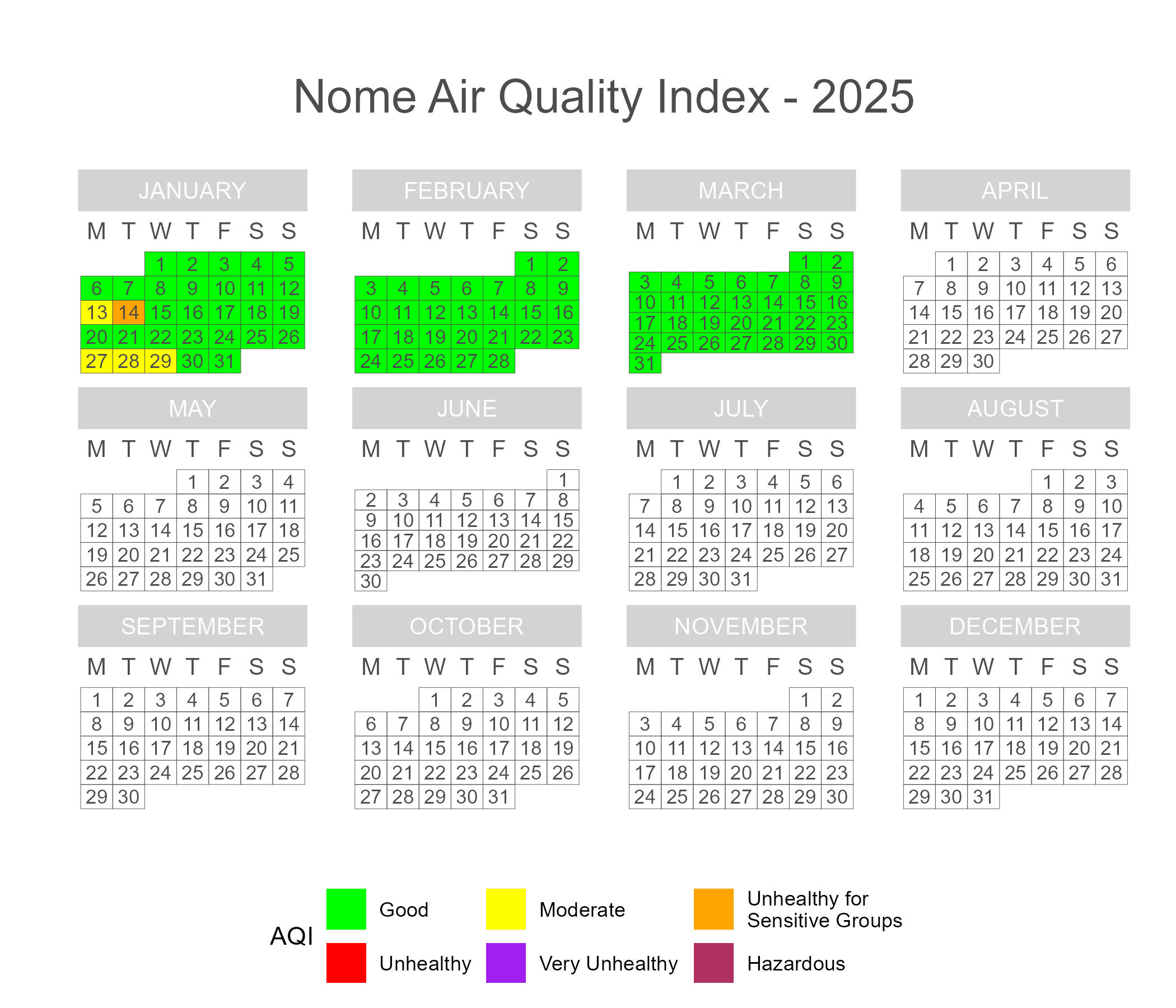
Figure 27 and Figure 28 depict calendar plots for the community of Nome during the reporting period. For the most part, Nome enjoyed air quality in the ‘Good’ AQI range. In late January, Nome experienced a multi-day cold spell with inversion conditions that peaked on January 29th before returning to normal, which was paired with a simultaneous increase in PM2.5 levels into the ‘Moderate’ AQI range.
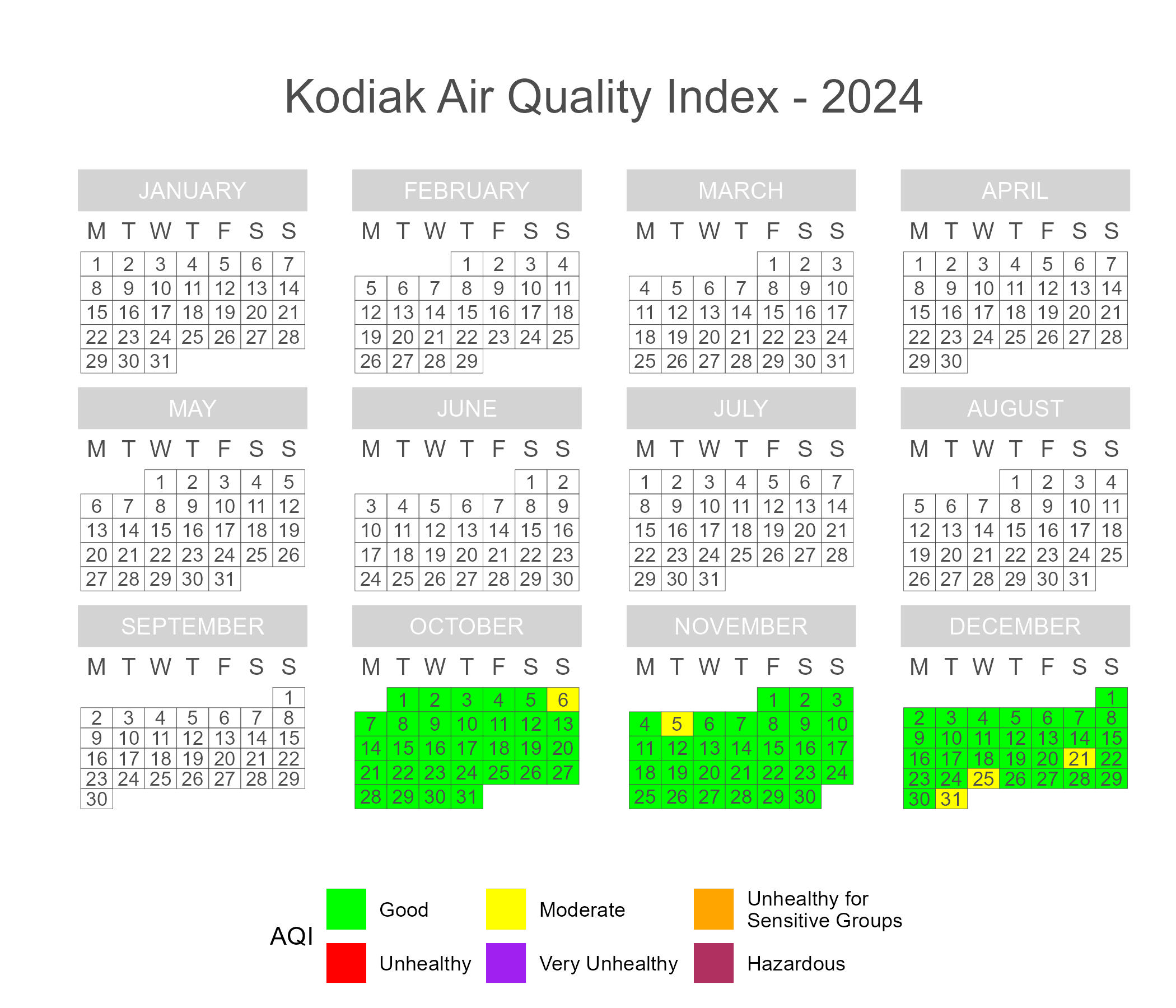
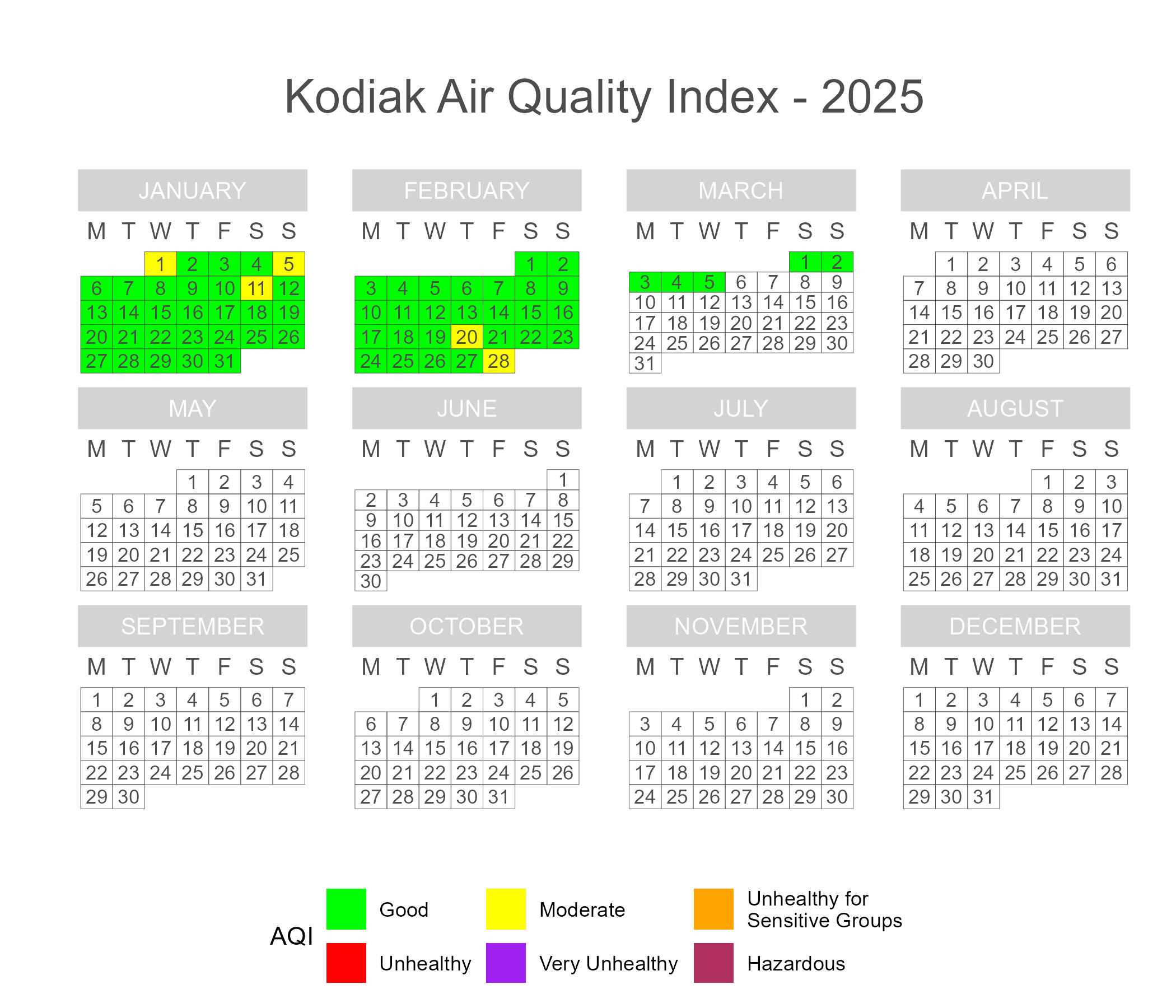
Figure 29 and Figure 30 depict calendar plots for the island-based community of Kodiak during the reporting period. Kodiak generally enjoys air quality in the ‘Good’ AQI range, although several days had air quality in the ‘Moderate’ AQI range.
Due to a roof leak and construction at the host building, the Kodiak pod was taken offline on March 6th, 2025, and moved to a secure location. The pod was not reconnected until April 8th, after the end of the interim reporting period.
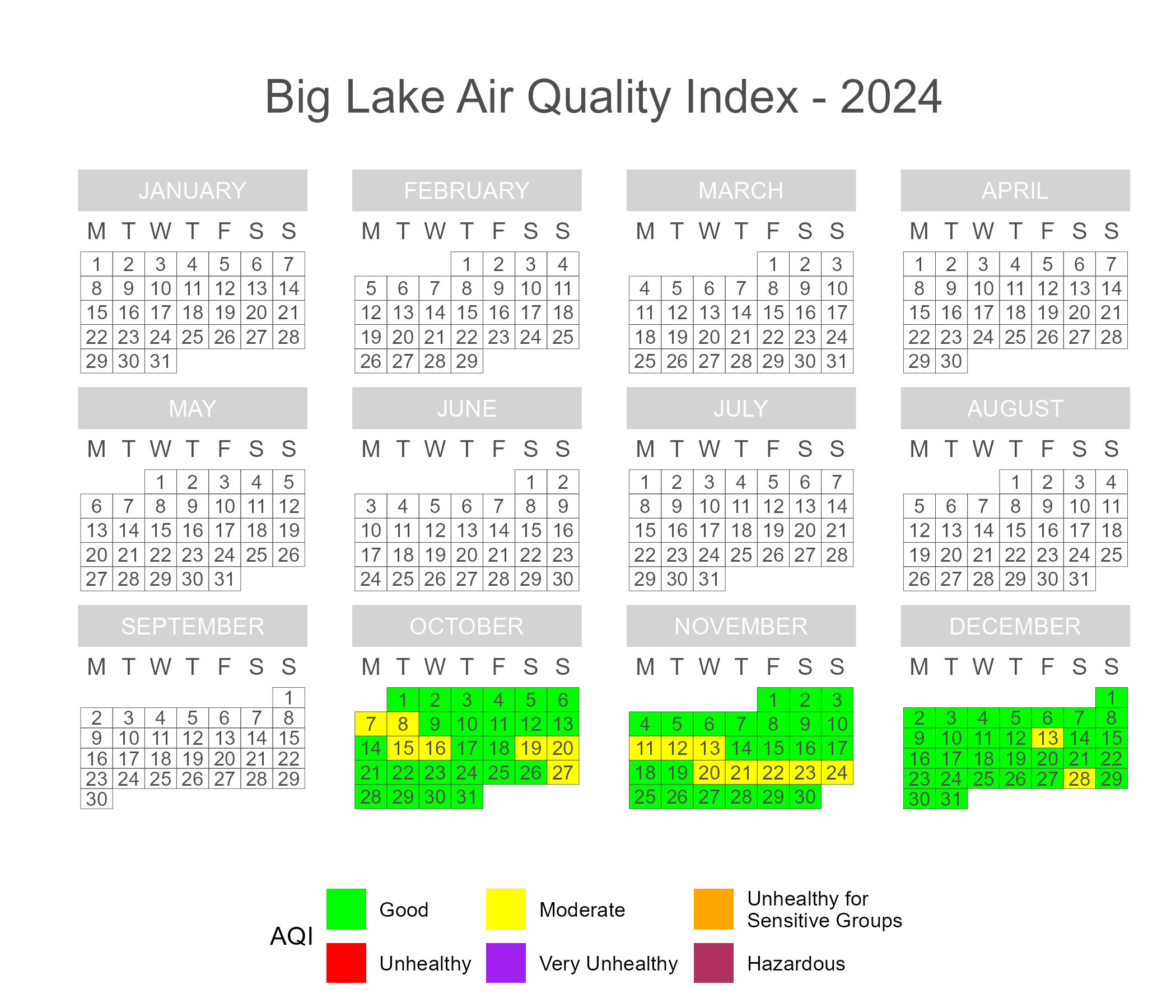
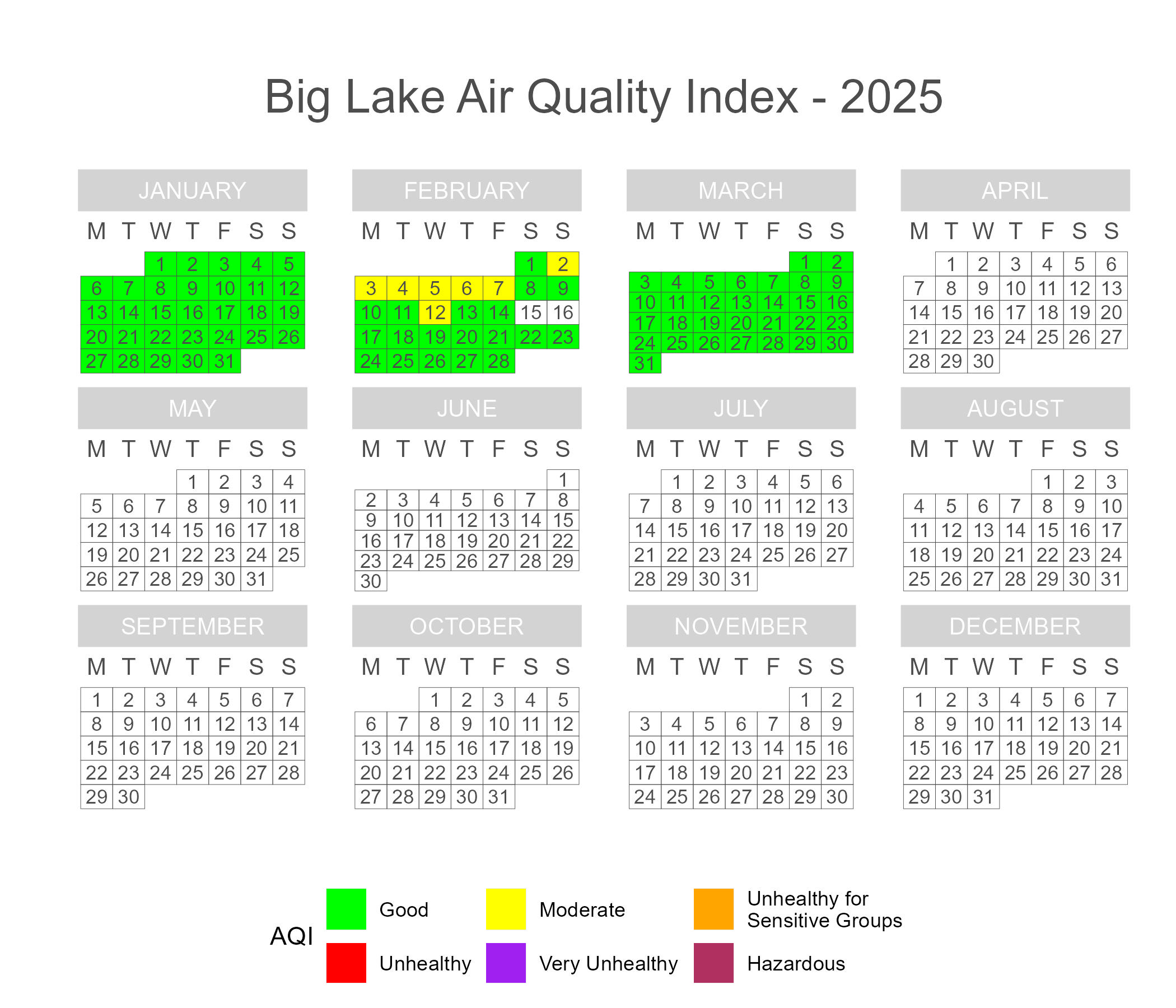
Figure 31 and Figure 32 depict calendar plots for the community of Big Lake during the reporting period. Big Lake enjoyed ‘Good’ (AQI) air quality for most of the reporting period, although there were several days and multi-day periods with air quality in the ‘Moderate’ AQI range. In November, December, and February, all the ‘Moderate’ AQI days occurred during below-freezing temperatures and were characterized by thick mist and ice fog. A community contact reported that ice fog in November was so thick, it impaired visibility and posed safety risks for drivers and pedestrians. On February 15th-16th, the pod experienced operational issues and failed to generate sufficient data to calculate daily PM2.5 averages.
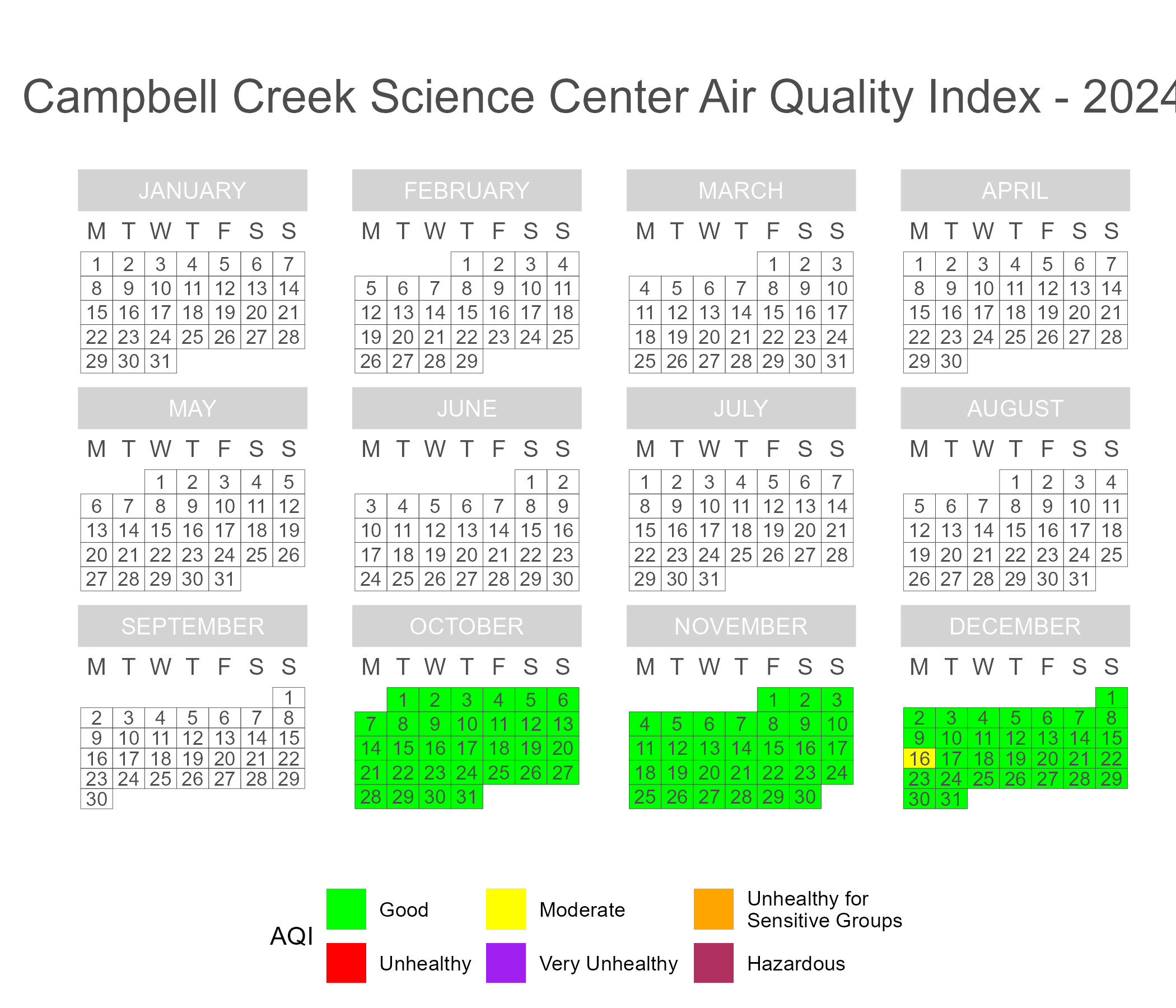
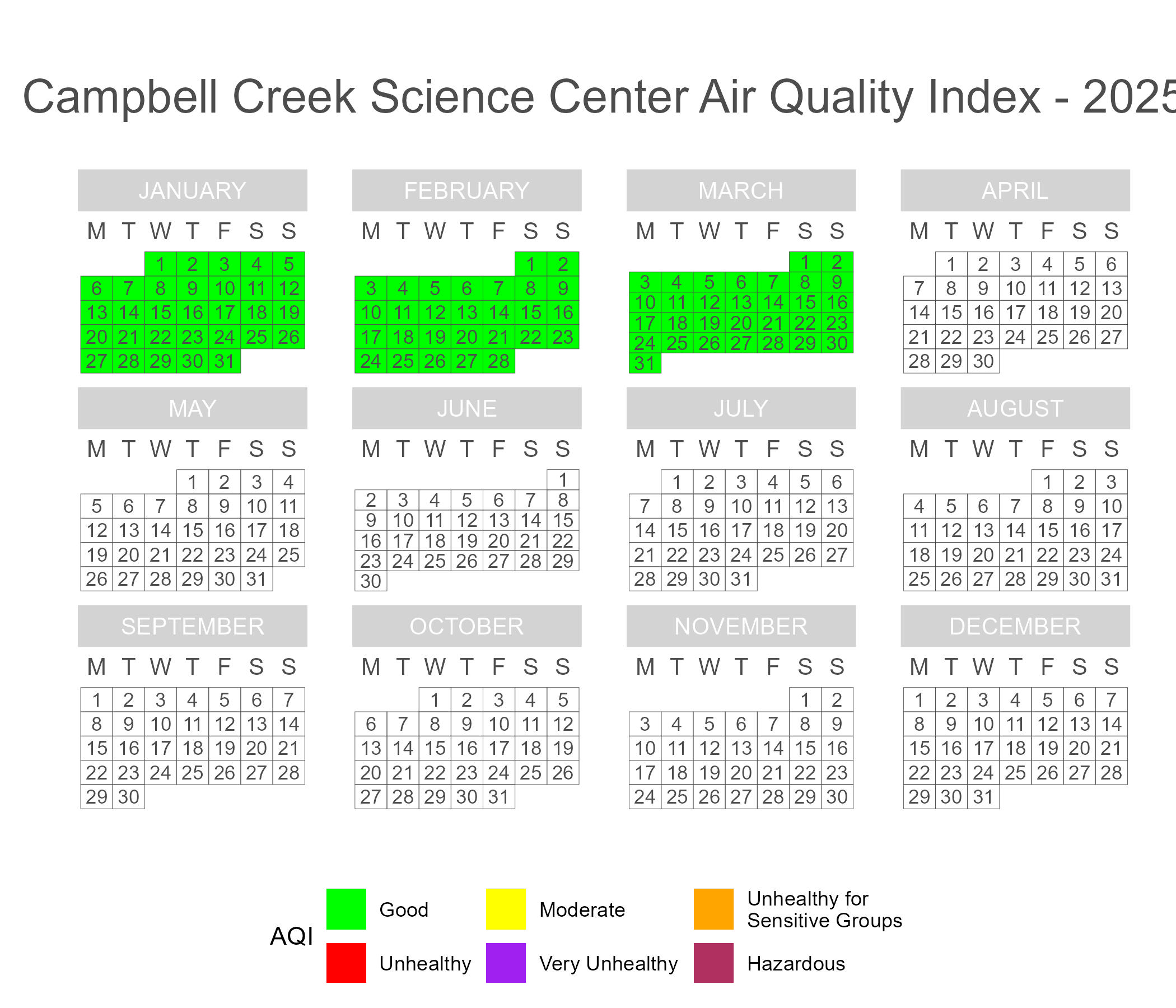
Figure 33 and Figure 34 depict calendar plots for the Campbell Creek Science Center located in east Anchorage during the reporting period. The Campbell Creek Science Center pod experienced air quality in the ‘Good’ AQI range for almost the entire reporting period, except for December 16th, where the air quality reached the ‘Moderate’ AQI range.
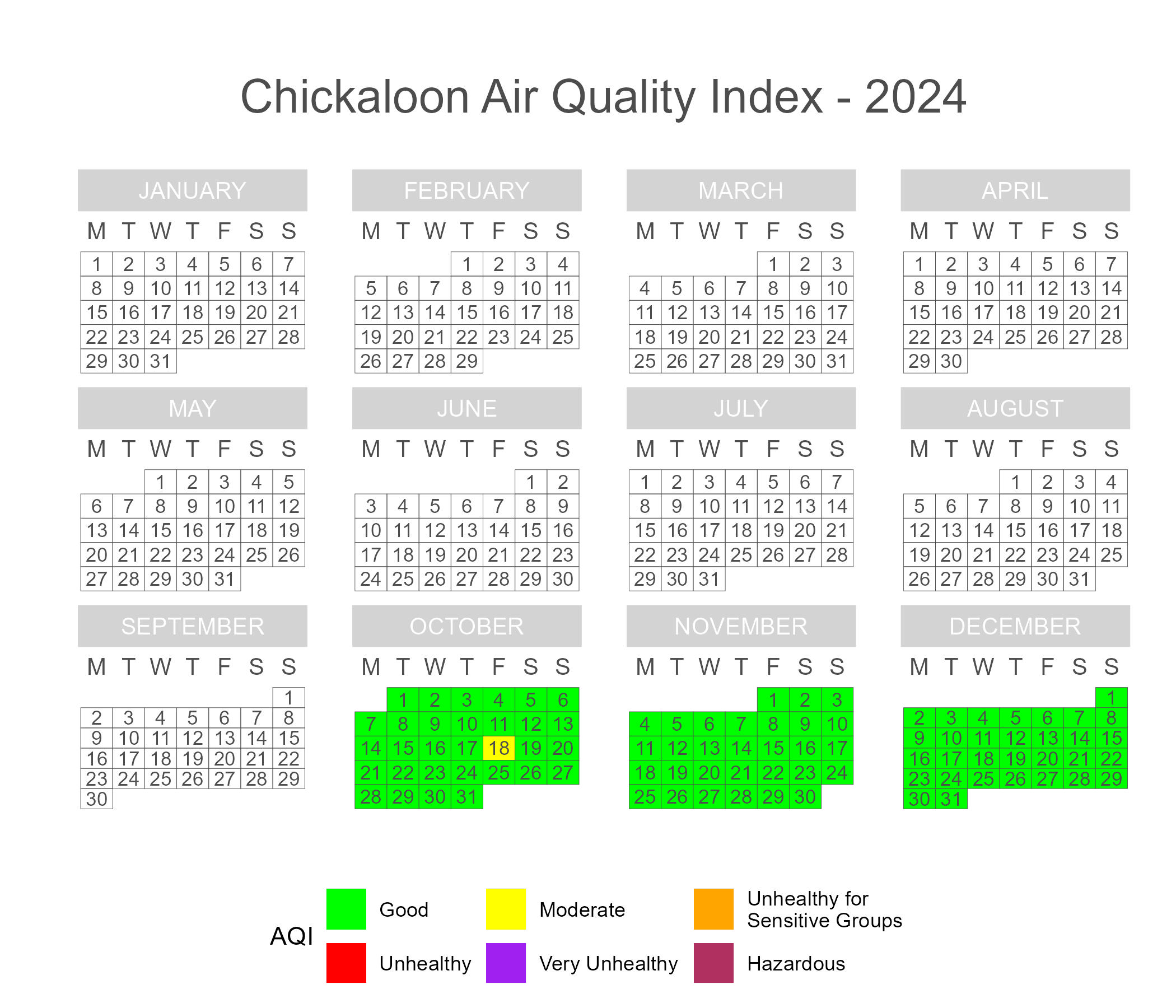
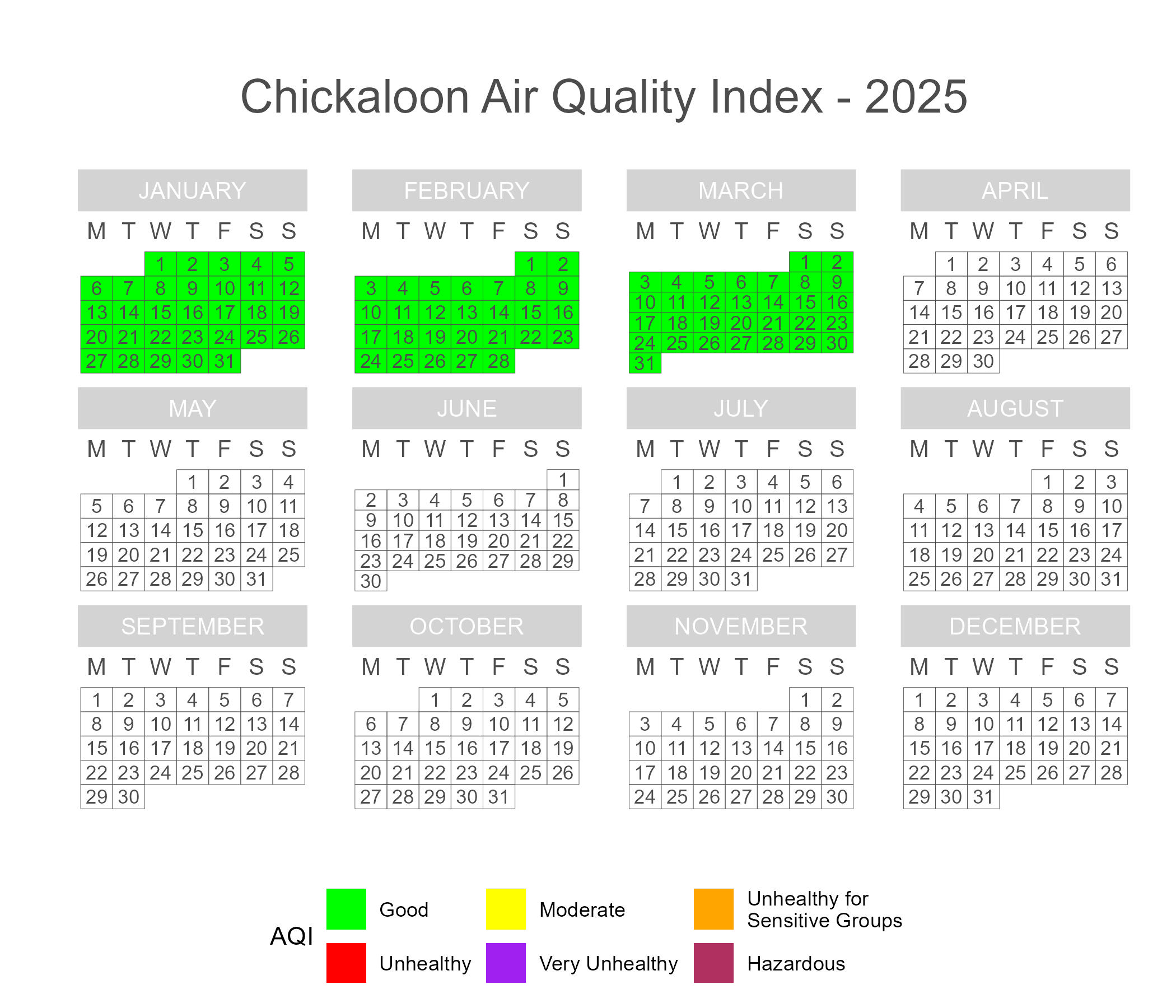
Figure 35 and Figure 36 depict calendar plots for the community of Chickaloon/Sutton-Alpine during the reporting period. The air sensor is located closer to the community of Sutton-Alpine but is located at a building whose mailing address corresponds to the community of Chickaloon. Chickaloon/Sutton-Alpine enjoyed air quality in the ‘Good’ AQI range for almost the entire reporting period, except for a single day in October. In the autumn before snowfall, communities in the region were affected by widespread wind-blown dust which worsened local air quality. On October 18th, this wind-blown dust degraded Chickaloon/Sutton-Alpine’s air quality into the ‘Moderate’ AQI range.
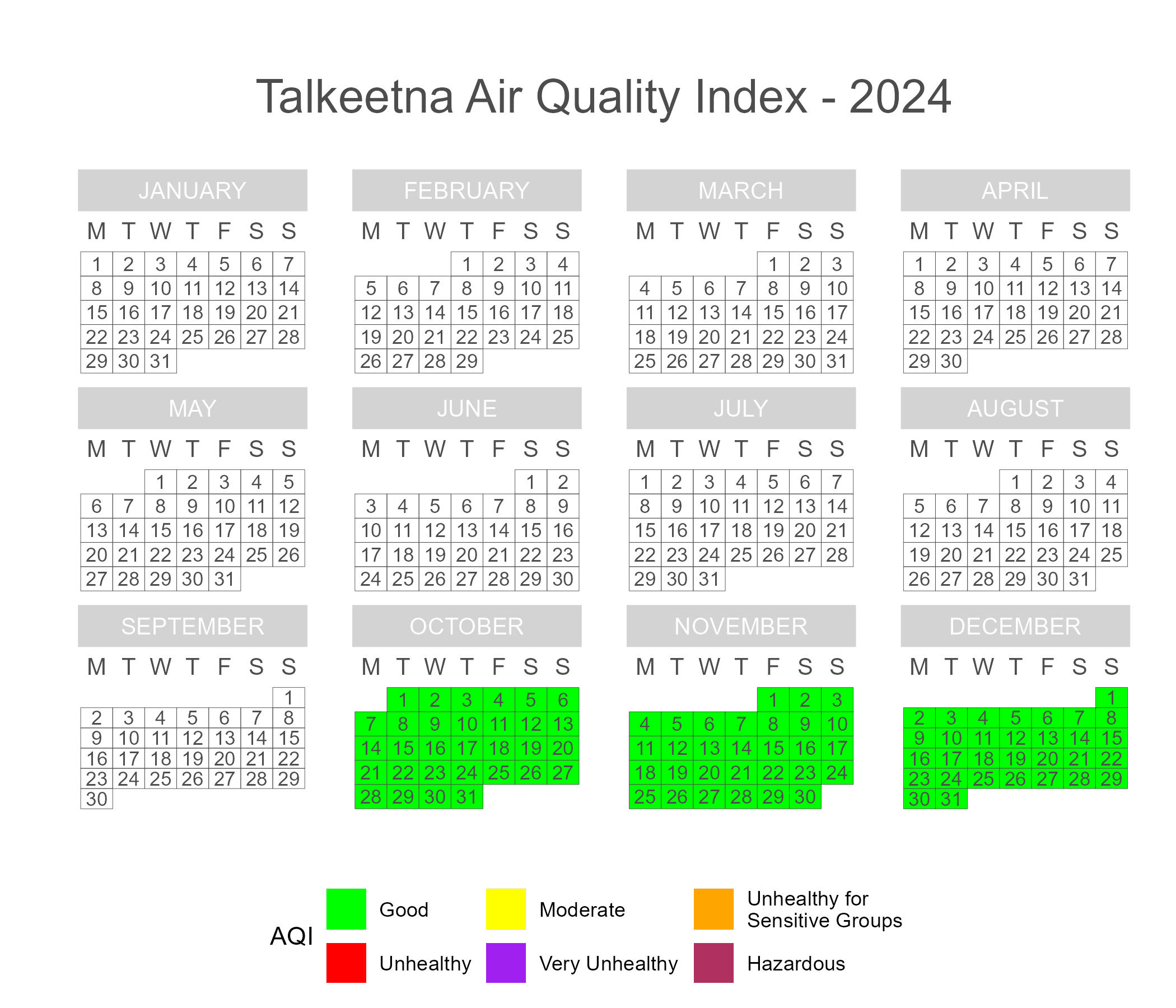
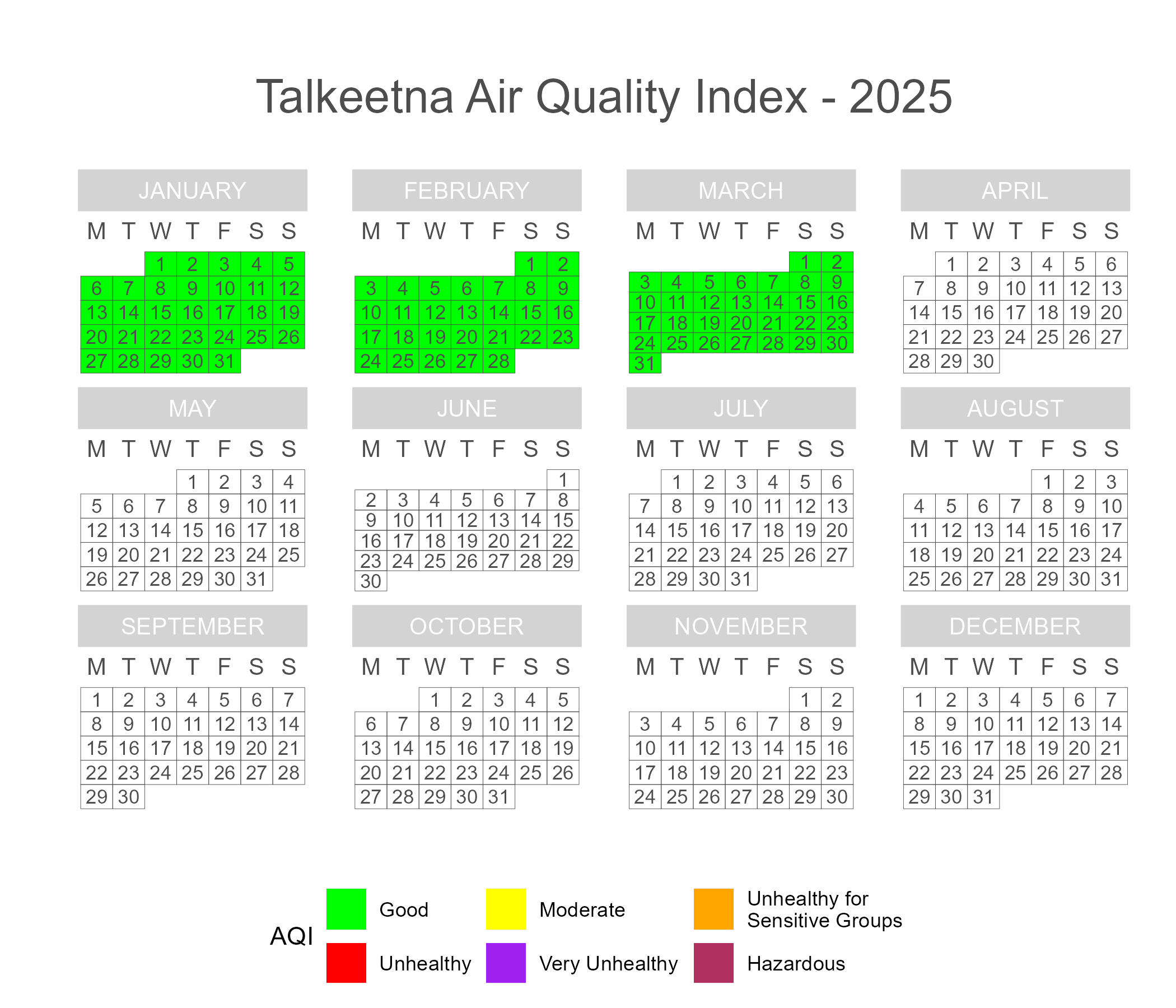
Figure 37 and Figure 38 depict calendar plots for the community of Talkeetna during the reporting period. The Talkeetna pod measured air quality in the ‘Good’ AQI range for the entire duration of the reporting period.
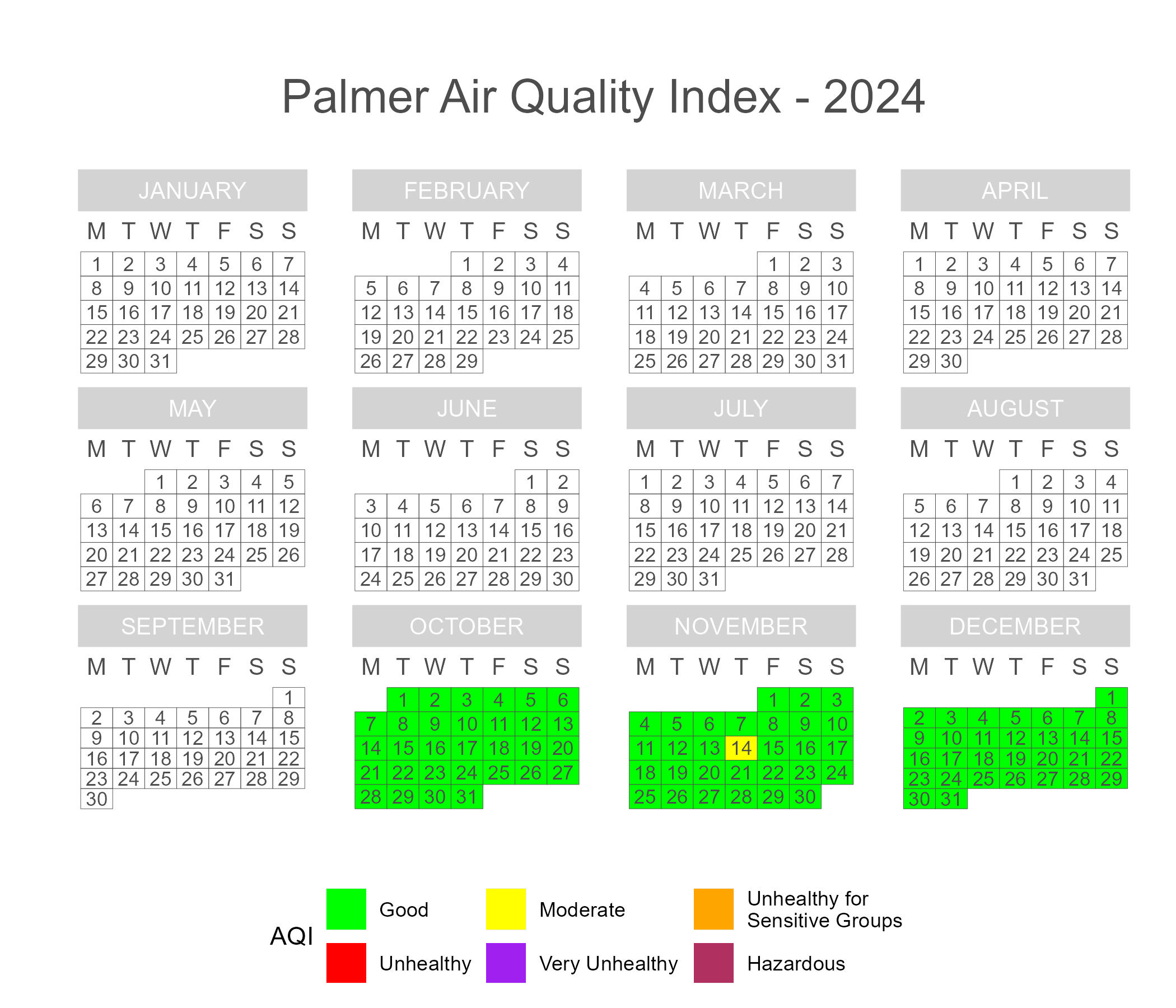
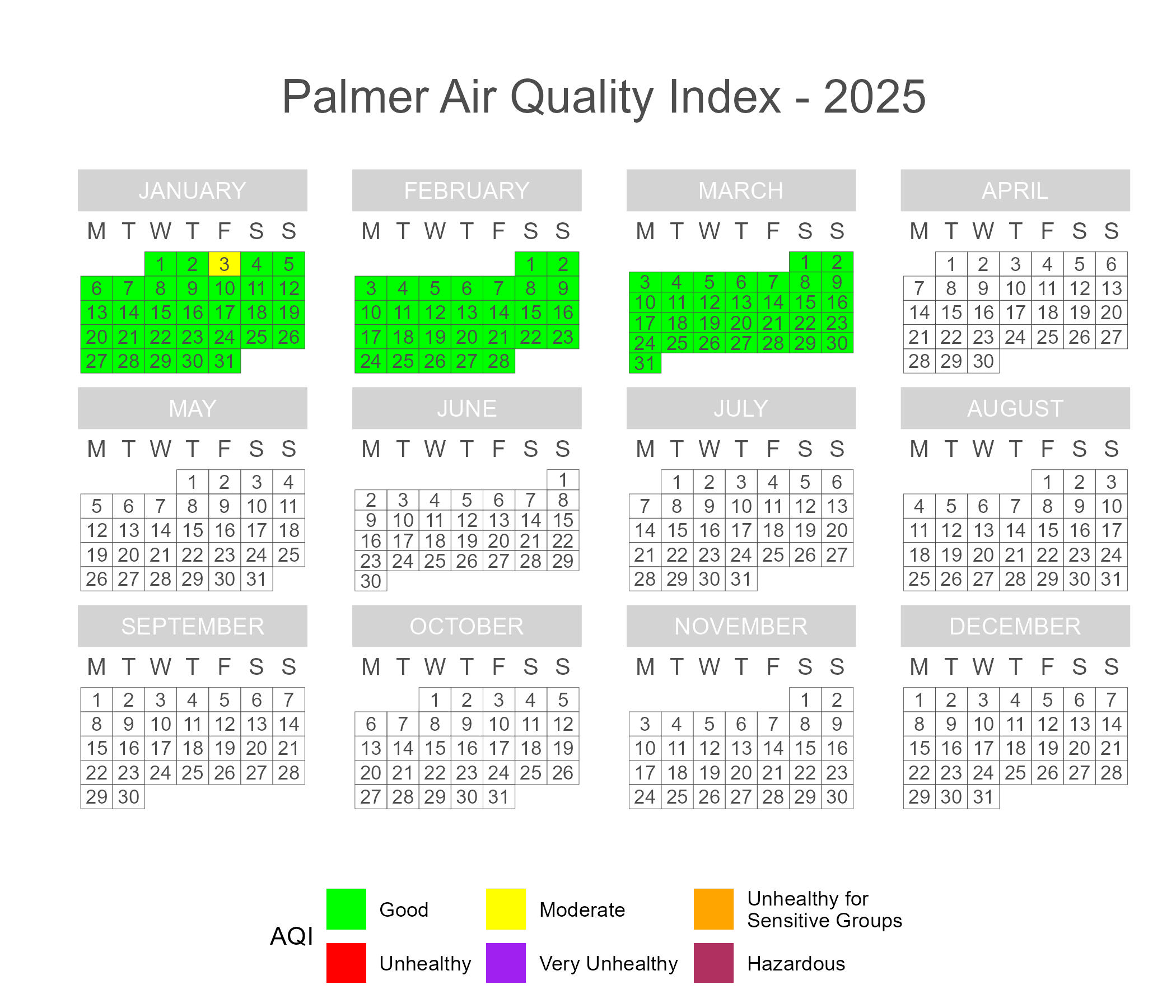
Figure 39 and Figure 40 depict calendar plots for the community of Palmer during the reporting period. Palmer generally had air quality in the ‘Good’ AQI range for almost the entirety of the reporting period, except for a single day each in November and January that had ‘Moderate’ (AQI) air quality.
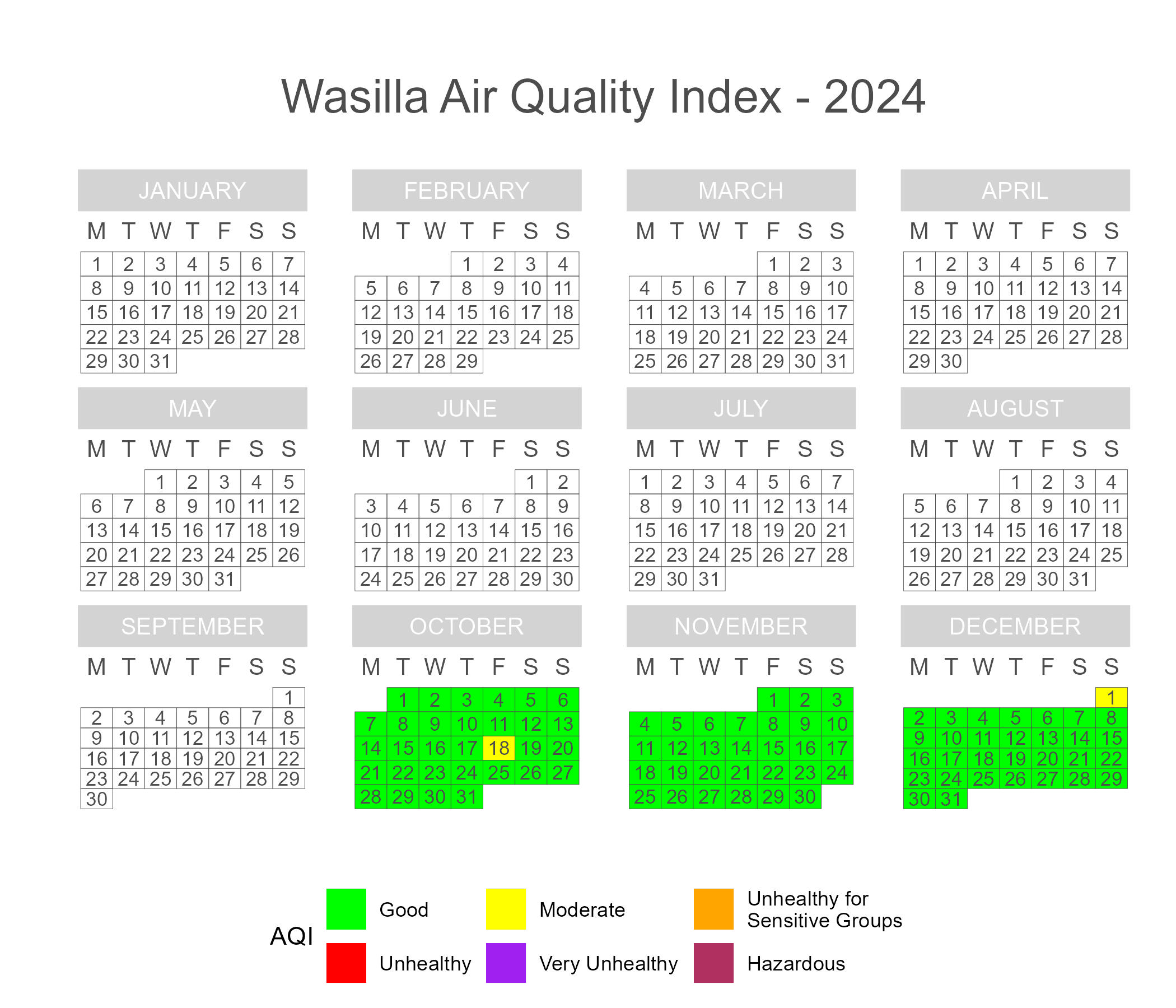
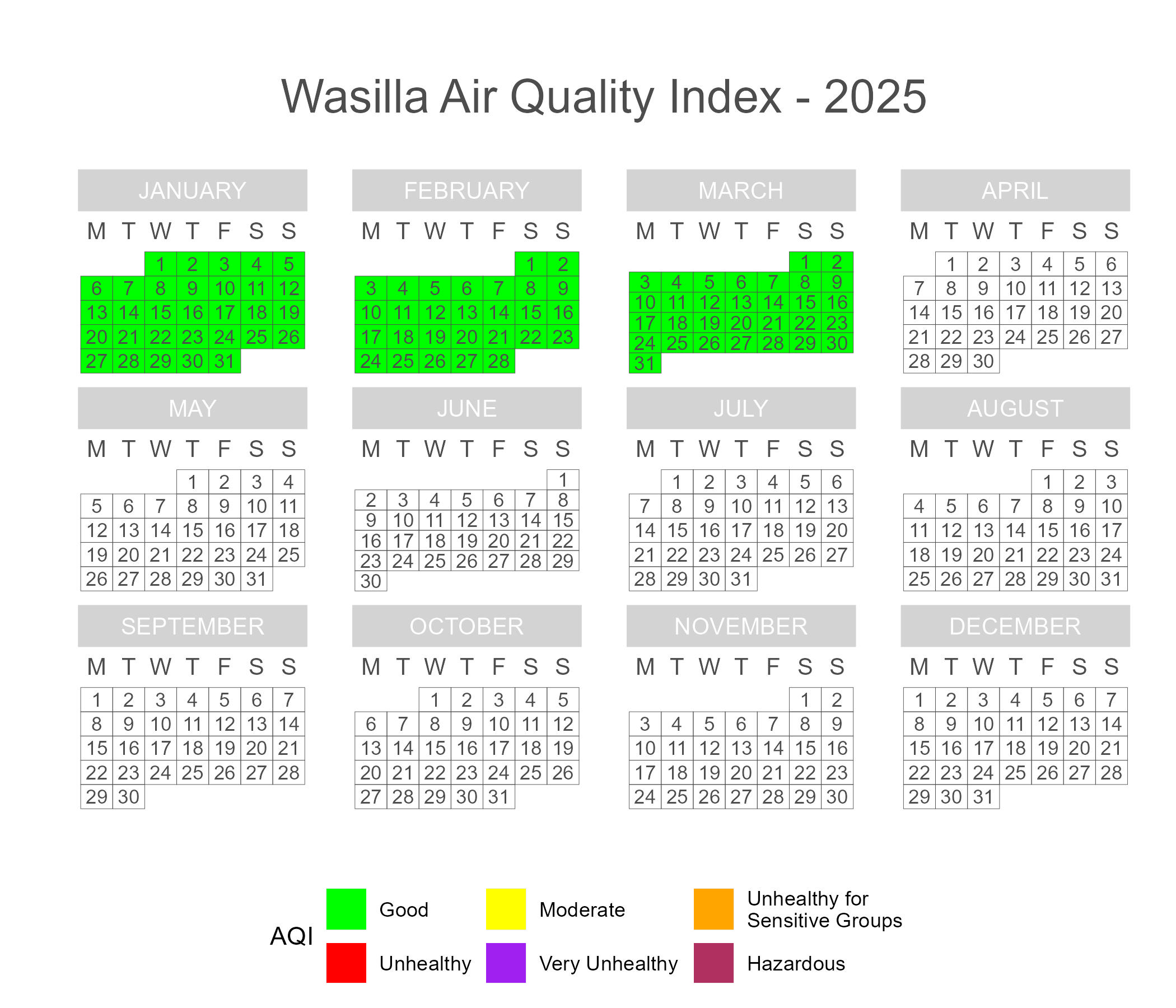
Figure 41 and Figure 42 depict calendar plots for the community of Wasilla during the reporting period. In the autumn before snowfall, communities in the region were affected by widespread wind-blown dust which worsened local air quality. On October 18th, this wind-blown dust degraded Wasilla’s air quality into the ‘Moderate’ AQI range. Wasilla enjoyed ‘Good’ (AQI) air quality for the rest of the reporting period.
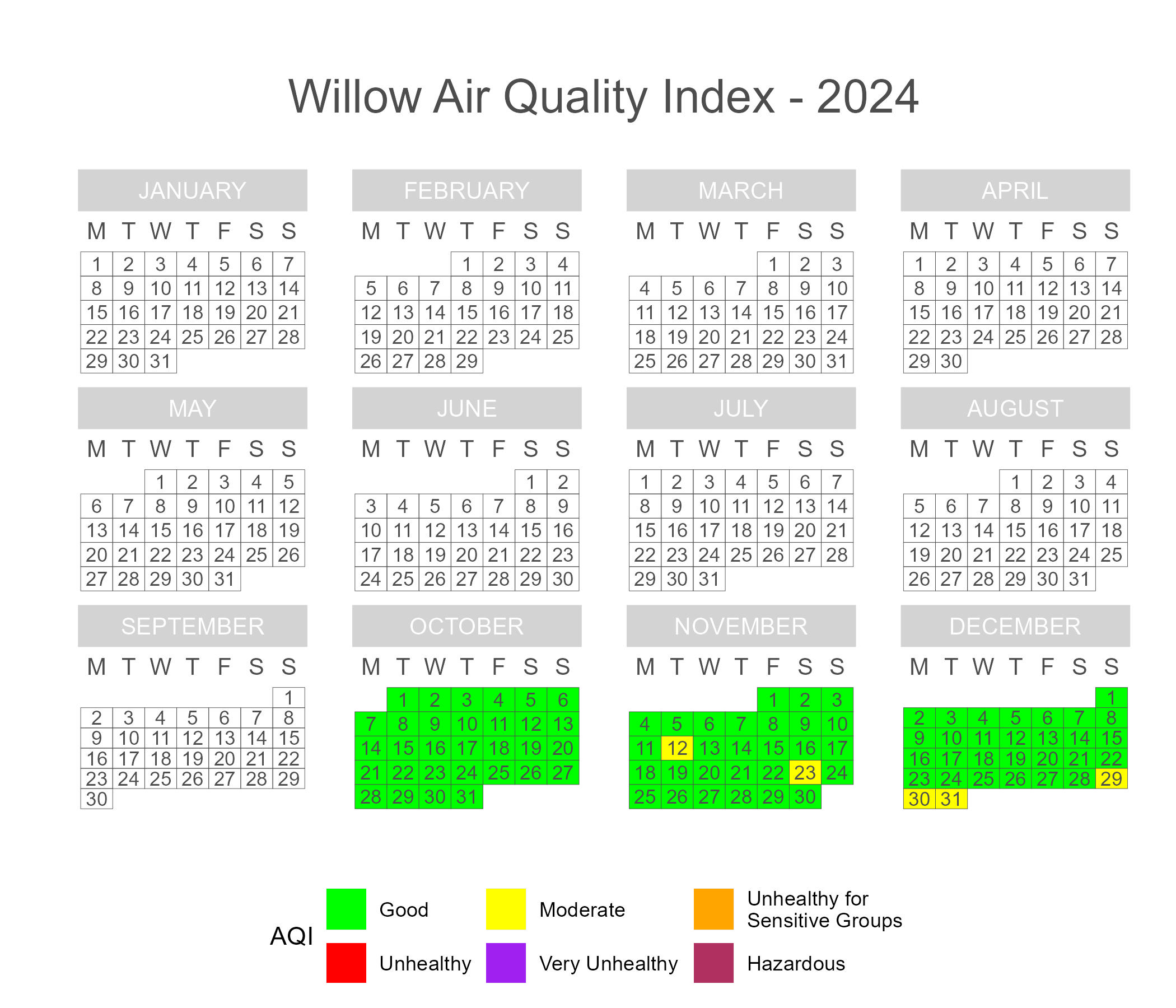
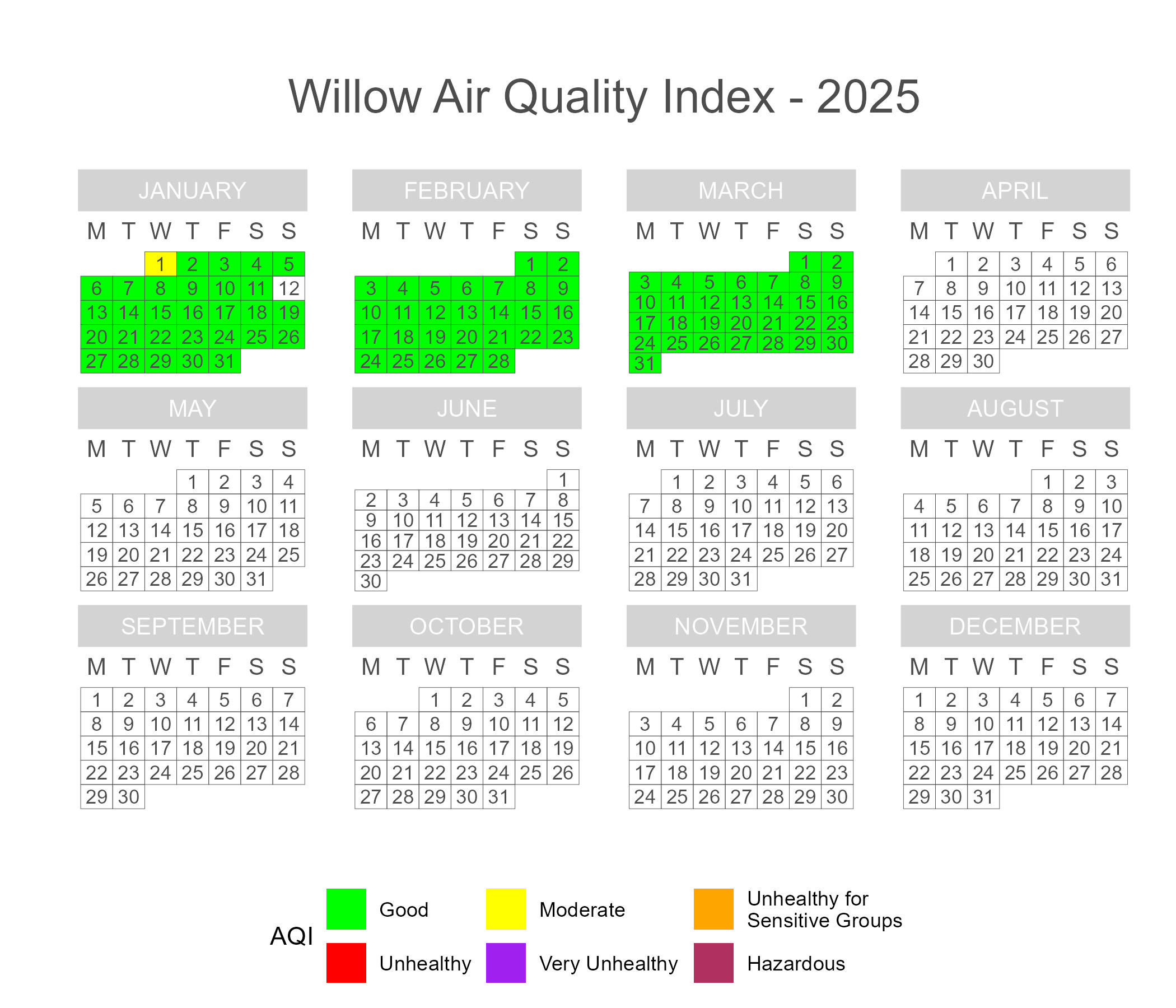
Figure 43 and Figure 44 depict calendar plots for the community of Willow during the reporting period. Willow generally enjoyed ‘Good’ (AQI) air quality through the reporting period, with occasional days in the ‘Moderate’ AQI range. November 12th was a cool day heading into a cold spell, characterized by mist and freezing fog. PM2.5 levels peaked at midday, raising the daily average to ‘Moderate’, but air quality was otherwise in the ‘Good’ AQI range. Over several days before and after New Year’s Eve, Willow experienced a cold spell that brought more mist and freezing fog. Elevated PM2.5 levels were likely due to increased home heating during the cold snap.
On January 12th, the pod experienced three power outages that interrupted data collection for slightly over half the day, meaning a daily average could not be calculated.
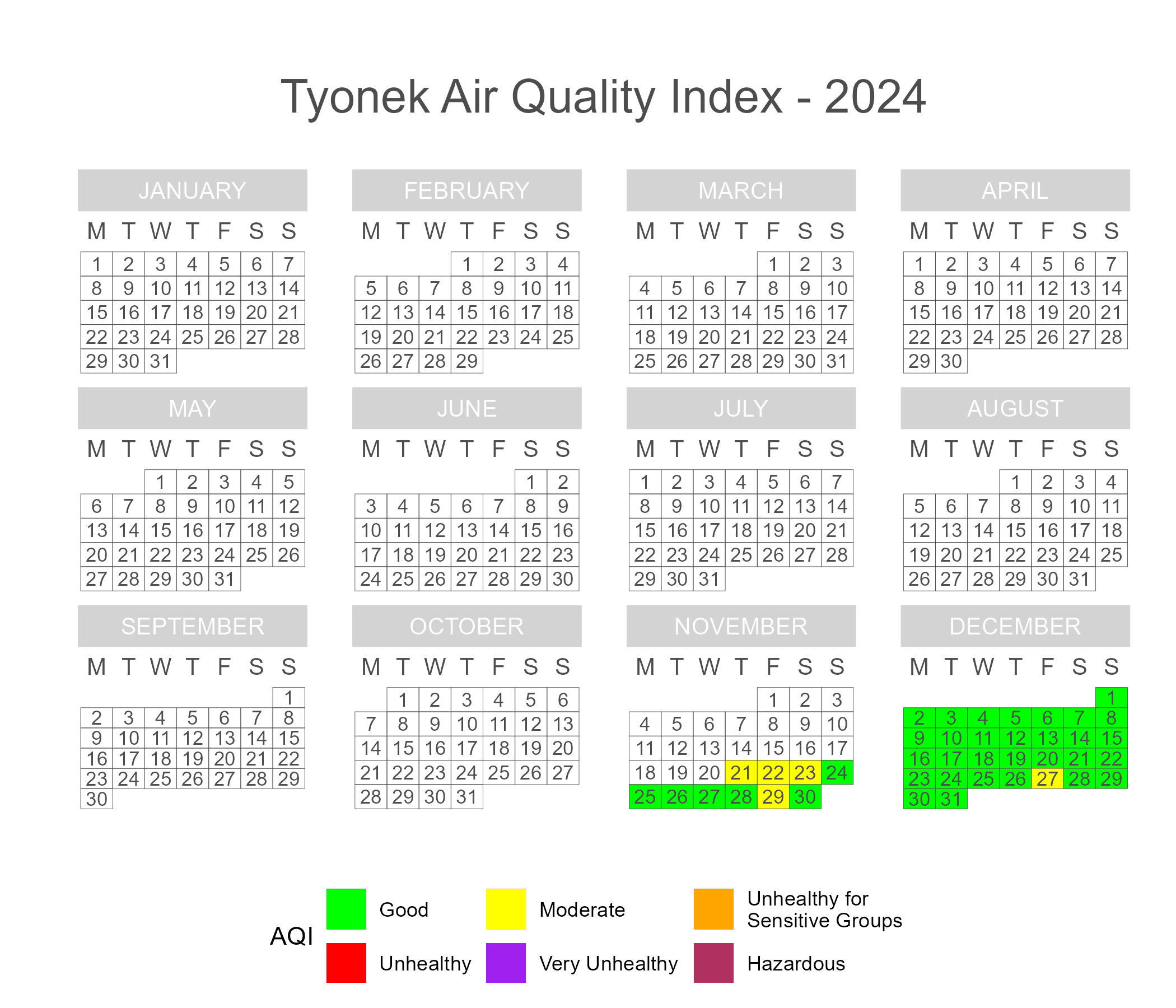
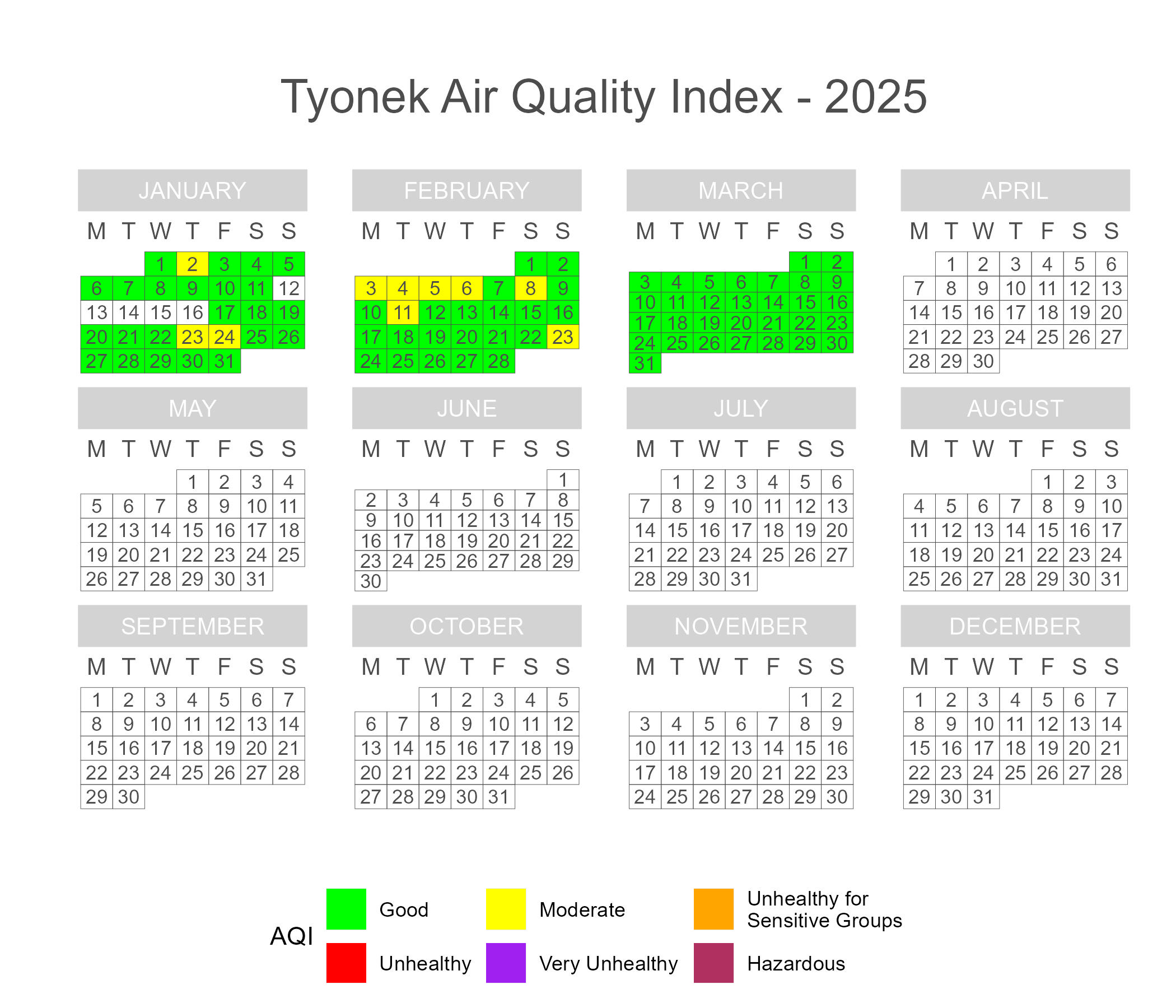
Figure 45 and Figure 46 depict calendar plots for the community of Tyonek during the reporting period. The pod was installed on November 20th and began calculating daily averages by the 21st. Tyonek generally has ‘Good’ (AQI) air quality, with occasional escalations into the ‘Moderate’ AQI range, particularly during cold weather. The installation took place in the middle of a cold spell; the first three days after installation had ‘Moderate’ (AQI) air quality. After a warm weekend, another cold spell hit at the end of the month, producing ‘Moderate’ (AQI) air quality on November 29th. In December and January, relative increases in PM2.5 levels corresponded to dips in temperature. These temperature-related spikes in PM2.5 were likely due to increased home heating use in response to the cold. After the last cold day with ‘Moderate’ (AQI) air quality in February, the pod measured ‘Good’ (AQI) air quality for the remainder of the reporting period.
The outage in mid-January was due to a power disruption, when the pod’s power cord was unplugged by a community resident performing snow clearing. The pod was offline from January 12th to January 16th.
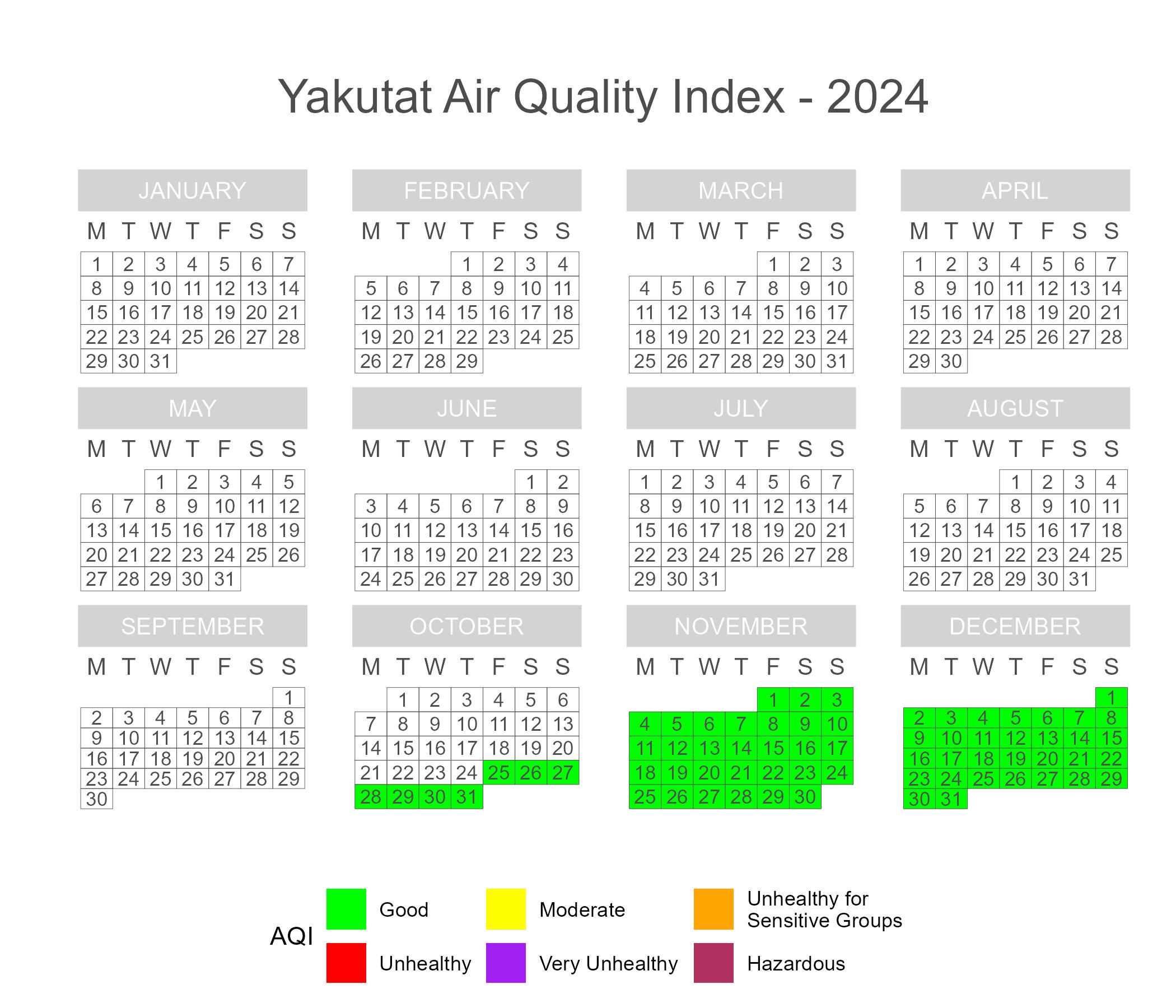
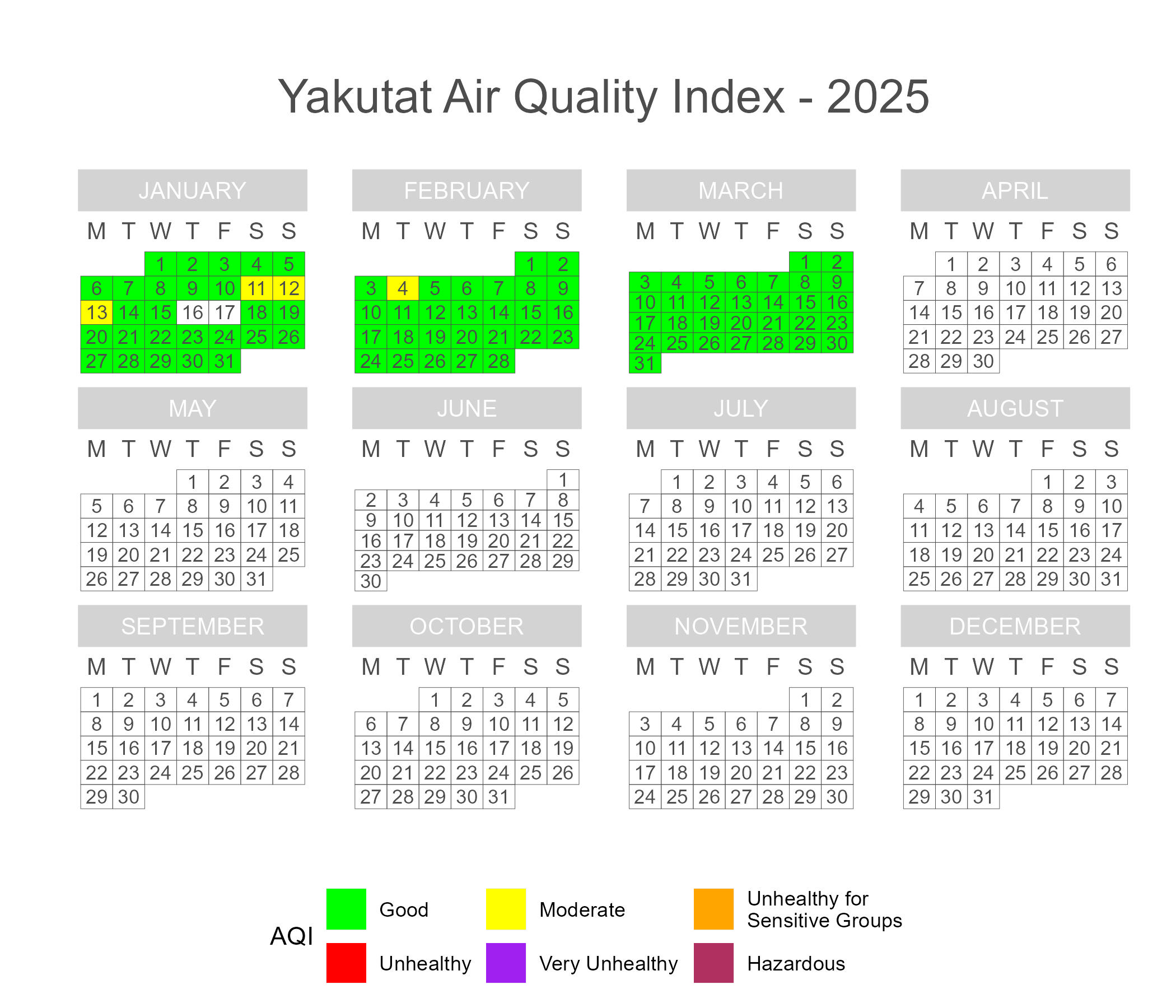
Figure 47 and Figure 48 depict calendar plots for the community of Yakutat during the reporting period. The pod was installed on October 24th and began calculating daily averages by the 25th. Yakutat enjoyed air quality in the ‘Good’ AQI range the entire time the pod was operational in 2024.
The outage on January 16th and 17th may have been caused by trees falling on power lines, as there were strong winds in the area around this time, and many regional power outages were reported.
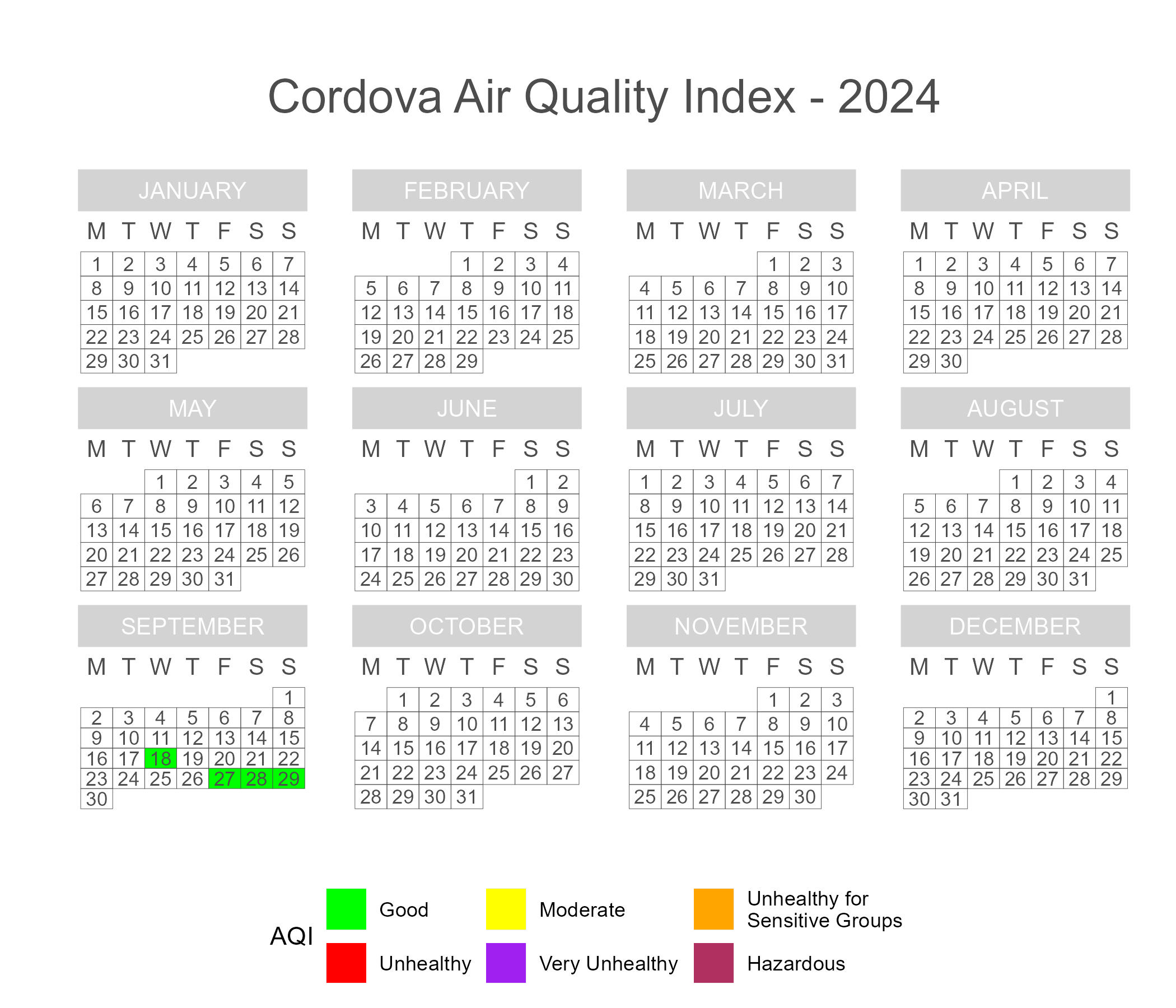
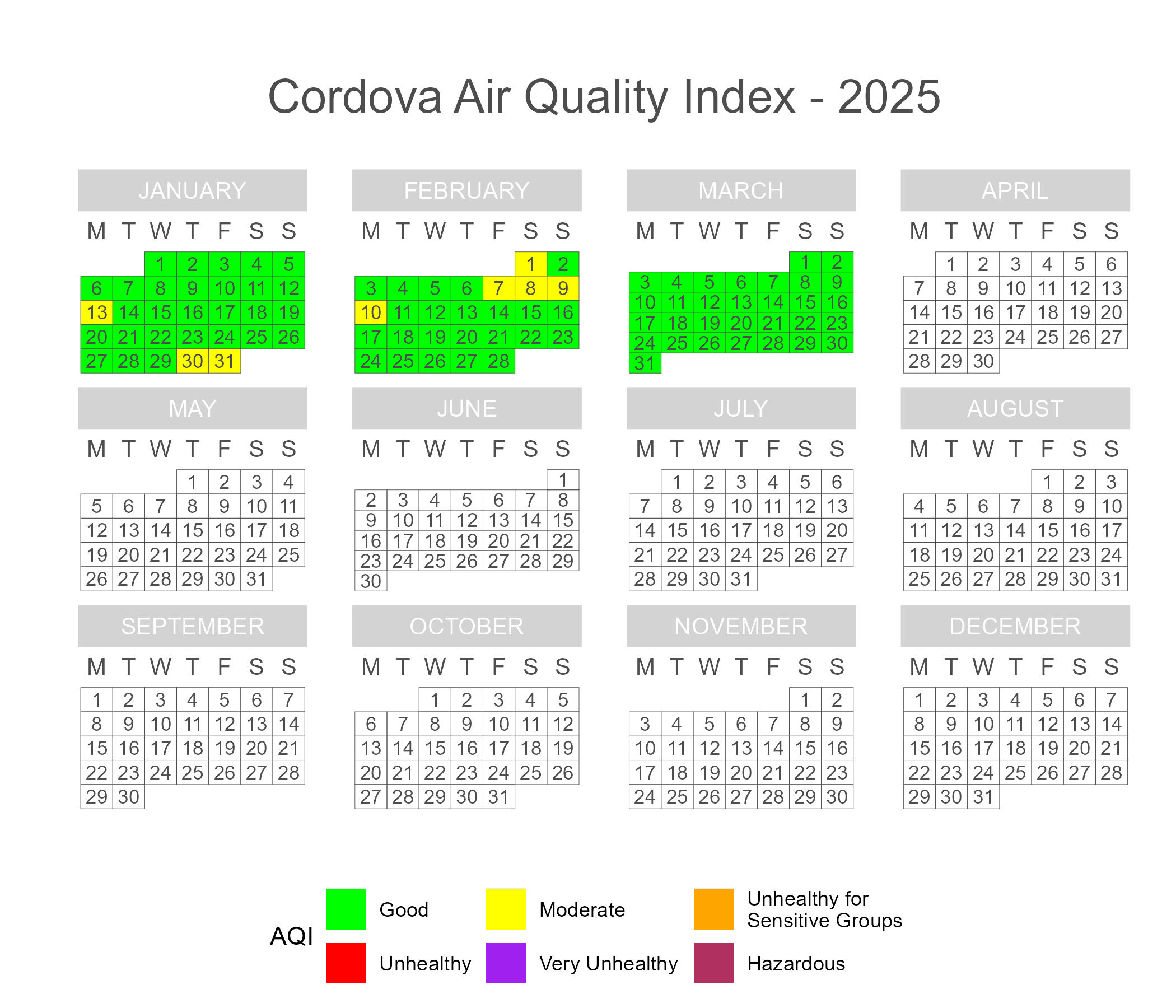
Figure 49 and Figure 50 depicts a calendar plot for the community of Cordova during the reporting period. The initial pod installation site did not have a reliable power supply; the pod was connected to an outlet regulated by a power switch that was often turned off, leading to frequent disruptions to pod operation. DEC worked with the community contact to find a more reliable power supply option, and the pod was reconnected at the start of 2025. Unfortunately, the pod experienced recurrent issues with its SD card and port that required it to be taken down and replaced (by MOD 667) on January 23rd. The original pod, MOD 664, was subsequently sent back to the manufacturer for repairs. There was a prolonged cold spell in late January and early February that brought mist, snow and hail, and corresponded with higher levels of PM2.5, pushing air quality into the ‘Moderate’ AQI range for several days potentially due to increased home heating activities. Cordova enjoyed ‘Good’ (AQI) air quality for the remainder of the reporting period.
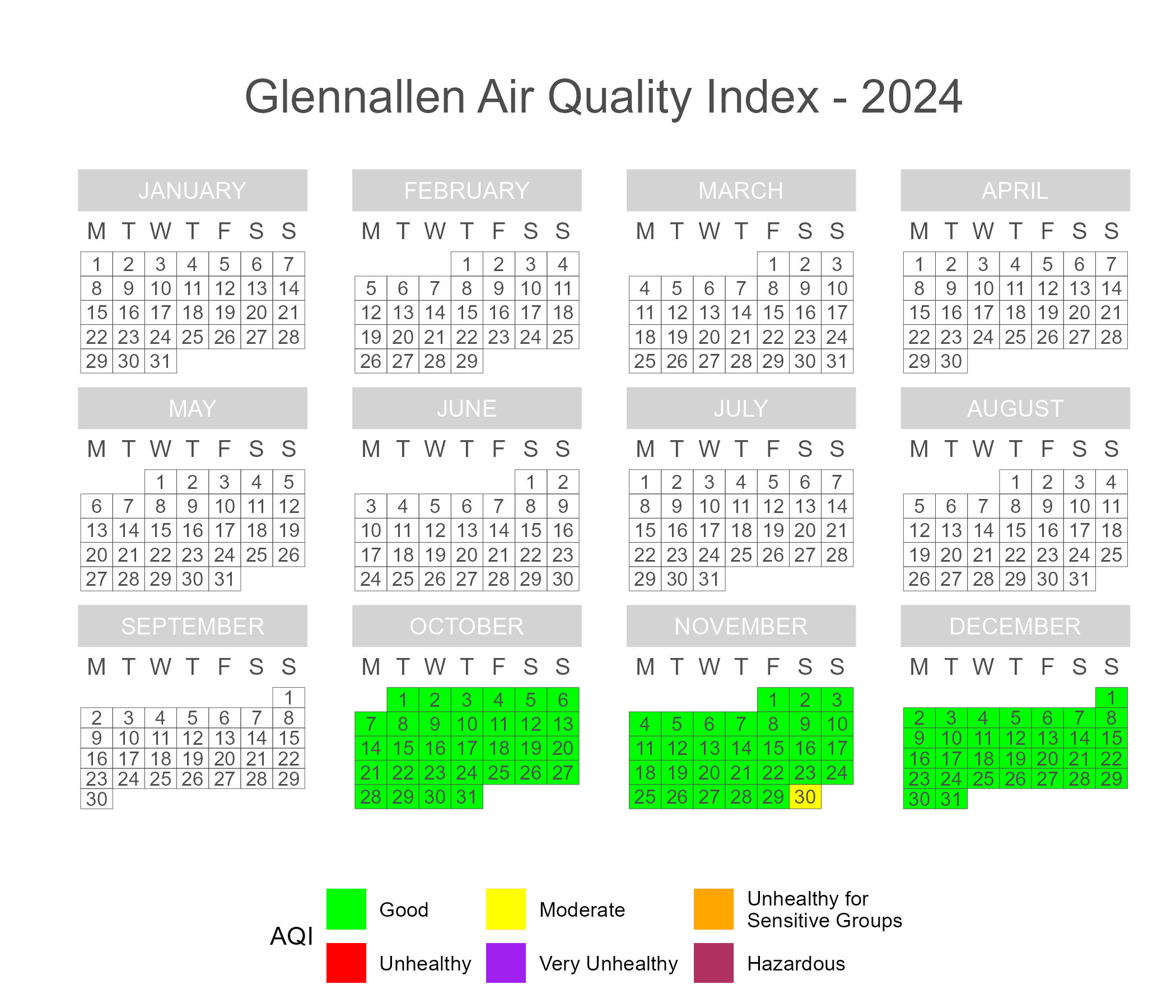
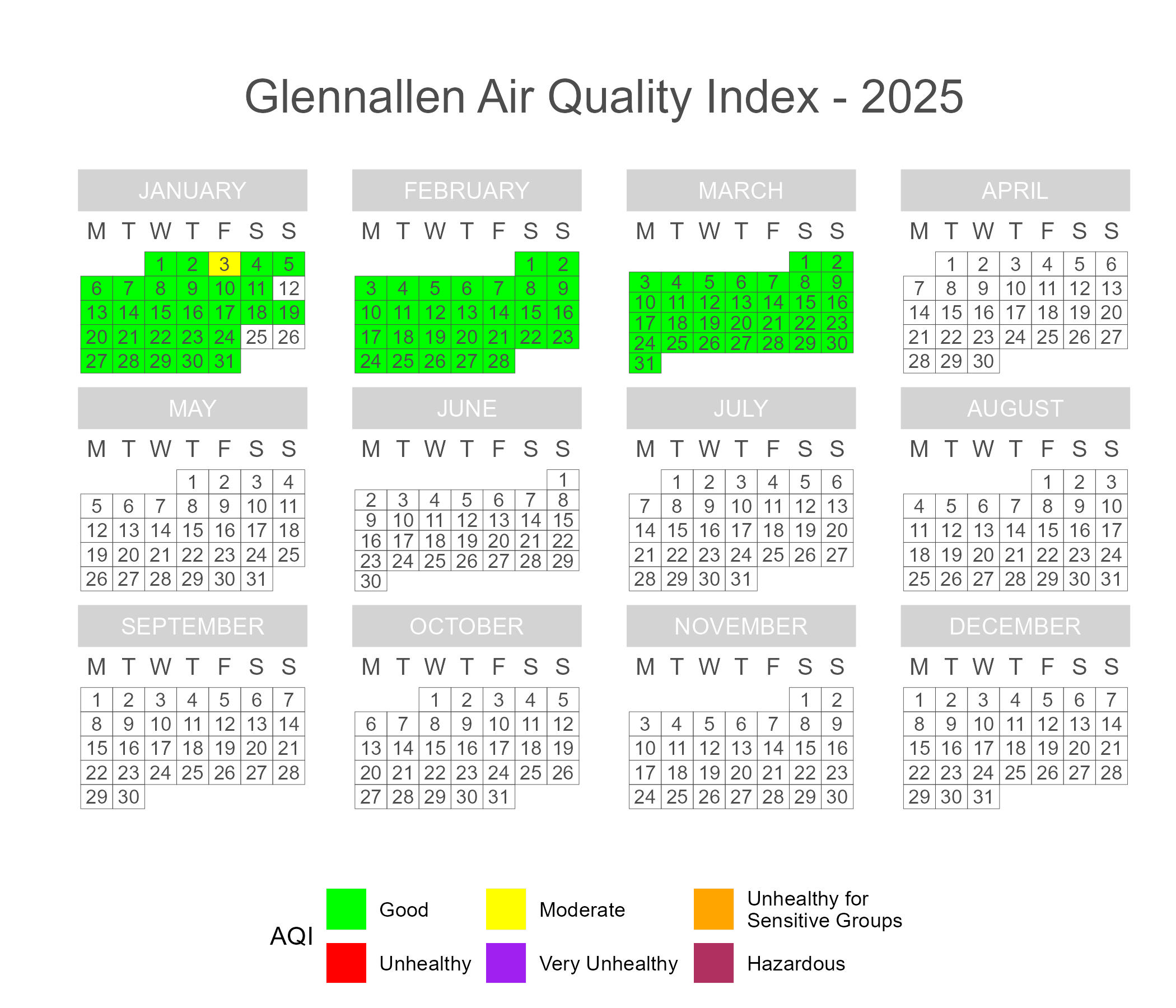
Figure 51 and Figure 52 depict calendar plots for the community of Glennallen during the reporting period. Near the end of 2025 and beginning of 2025, Glennallen experienced multiple extreme cold spells that exceeded -30 F and occasionally created inversion conditions. November 30th and January 3rd were both extremely cold days characterized by a morning surge in PM2.5 levels. The morning PM2.5 surge quickly subsided and PM2.5 levels returned to baseline by midday, but the surge pushed the daily average into the ‘Moderate’ AQI range. The pod’s PM2.5 and PM10 sensors experienced technical difficulties in mid-January during a bout of warmer weather; as a result, the pod was unable to calculate daily averages on January 12th, 25th, and 26th.
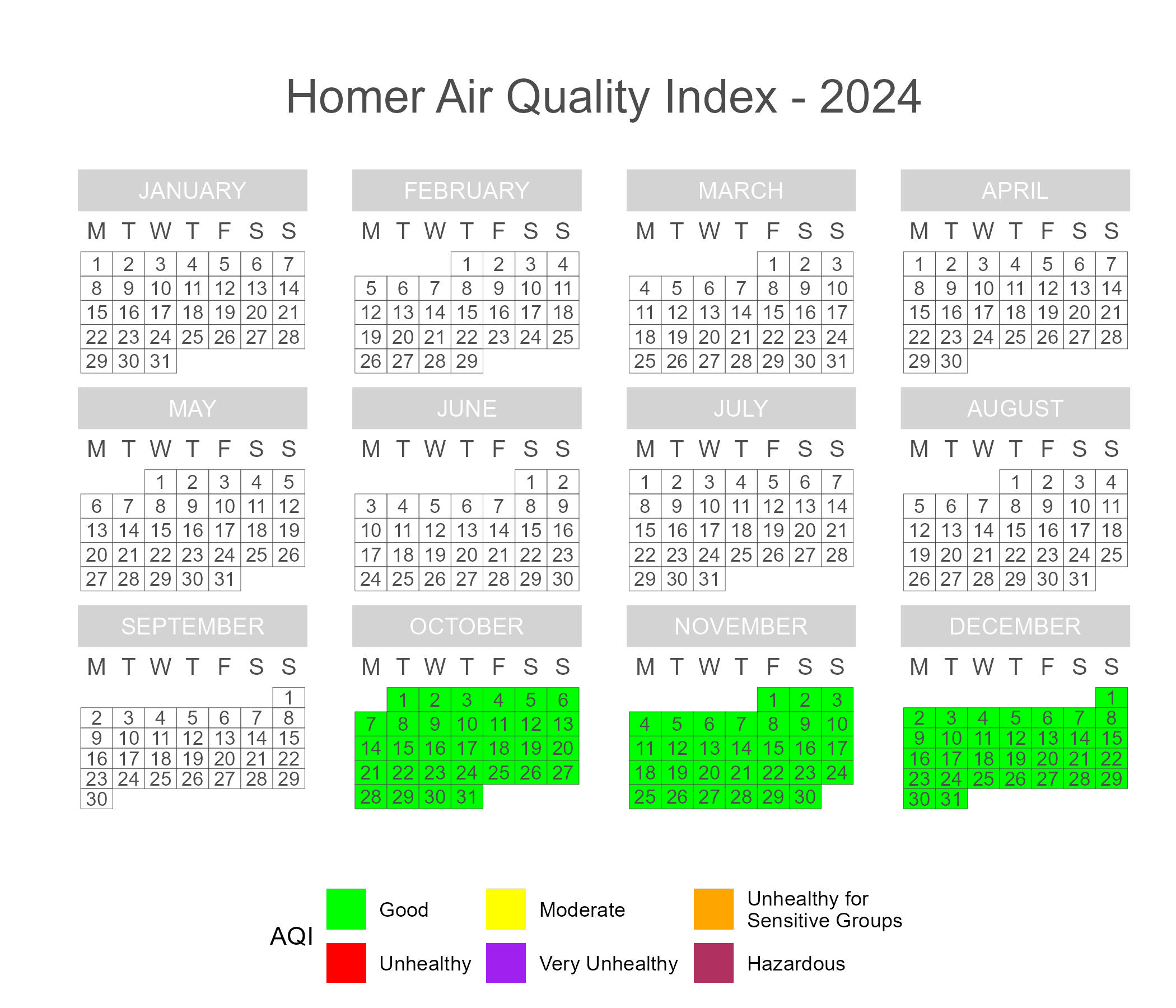
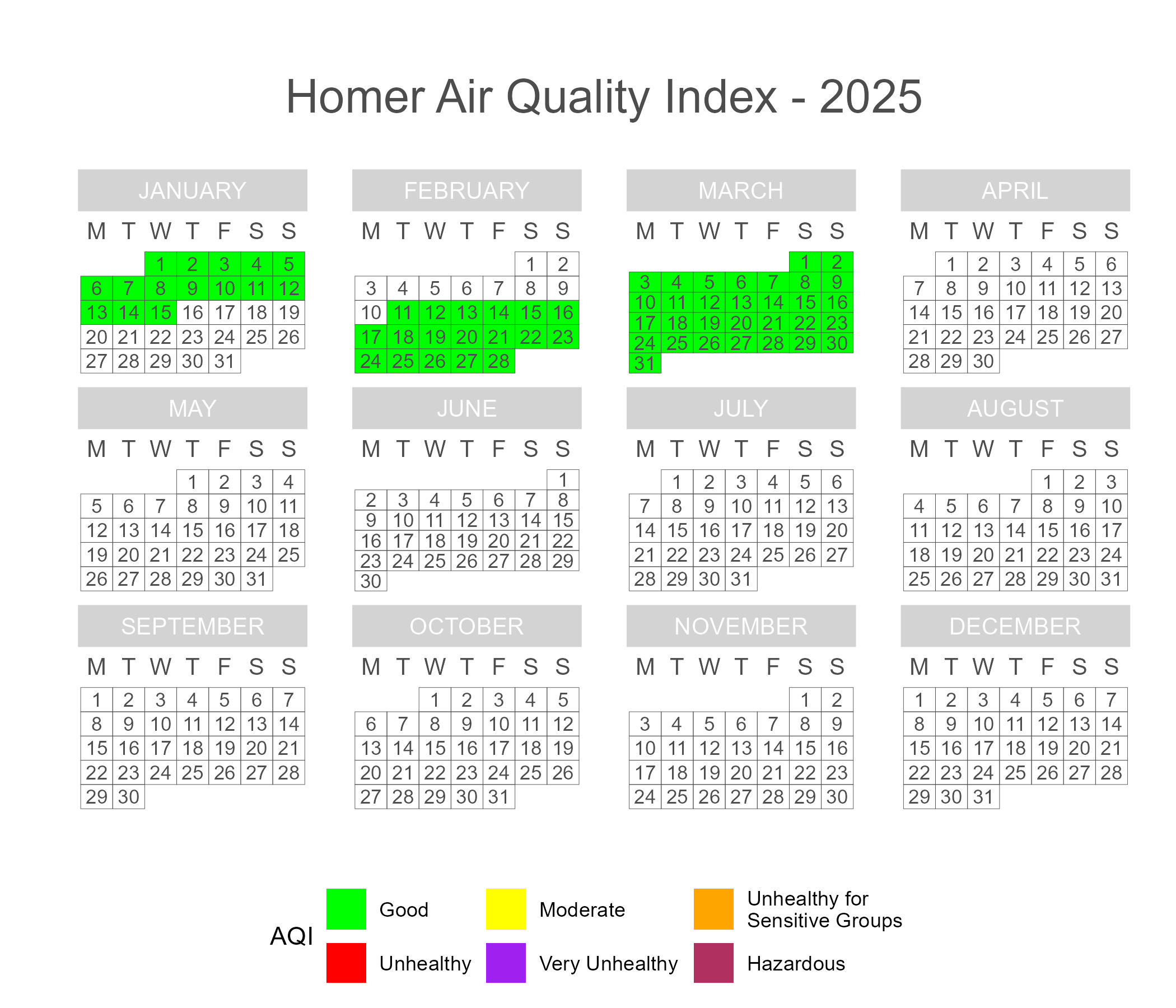
Figure 53 and Figure 54 depict calendar plots for the community of Homer during the reporting period. Homer experienced air quality in the ‘Good’ AQI range for the entire duration of the reporting period.
The pod’s power outlet shut off for an unknown reason on January 16, and was not turned back on until February 10, when the pod re-connected and resumed normal operation.
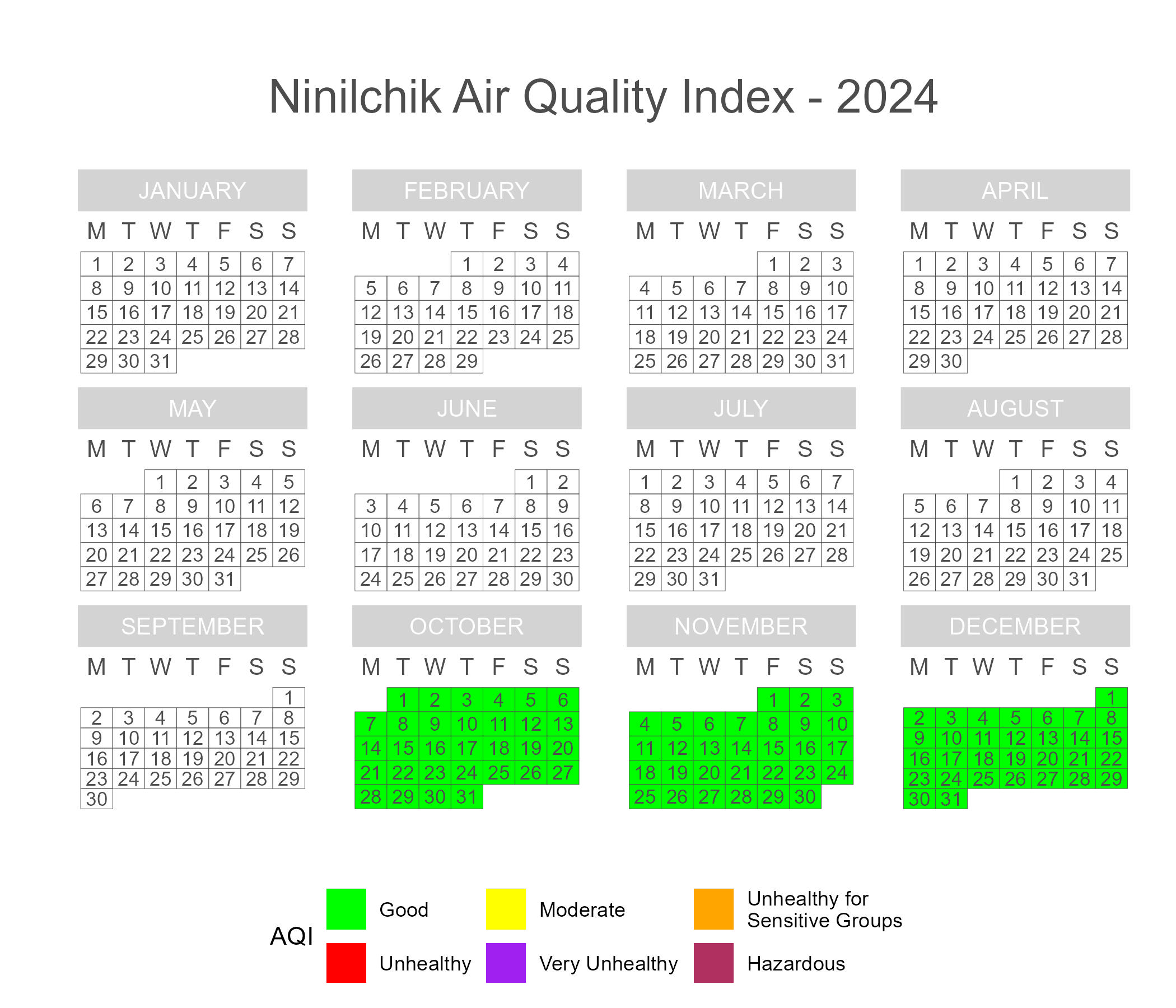
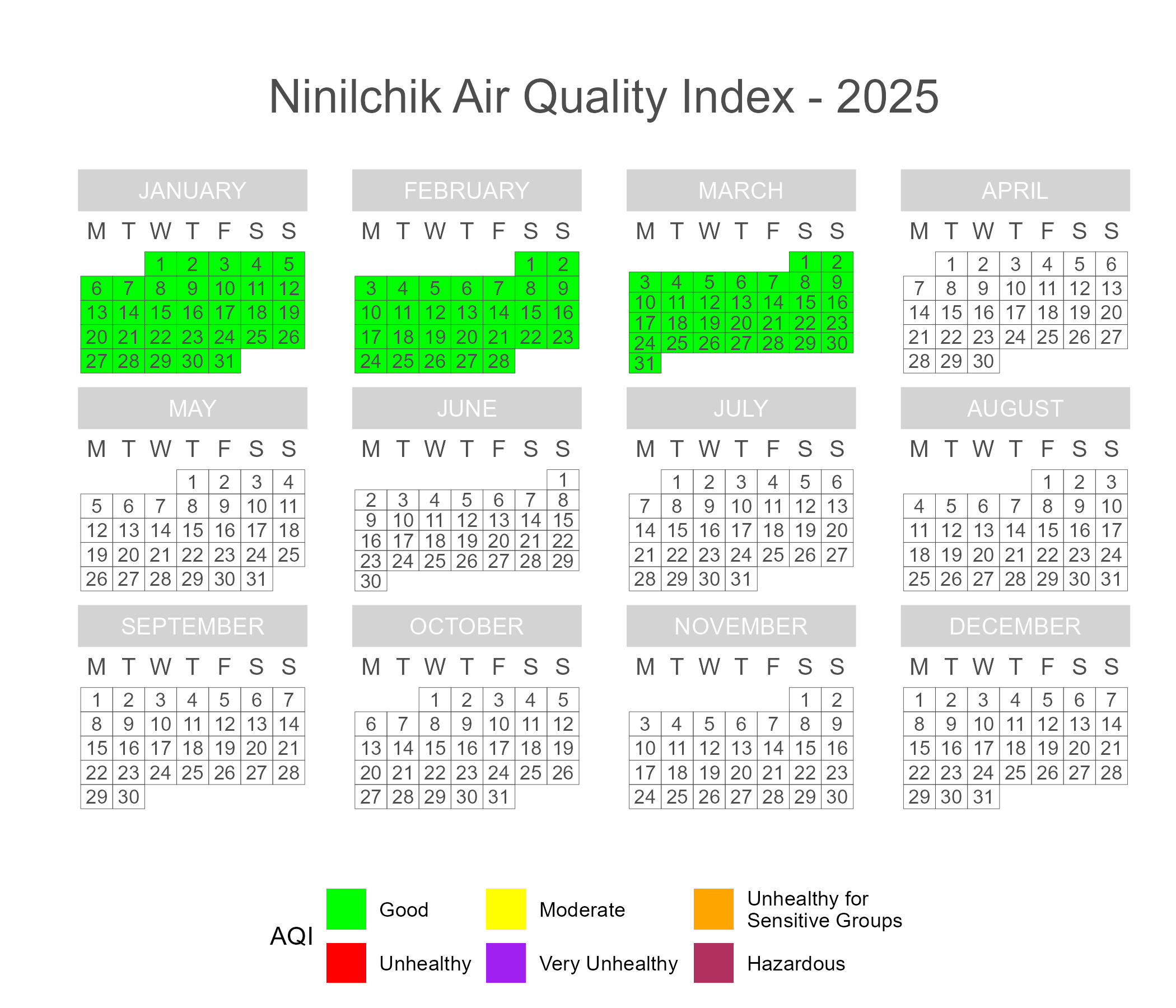
Figure 55 and Figure 56 depict calendar plots for the community of Ninilchik during the reporting period. The Ninilchik pod measured ‘Good’ (AQI) air quality and experienced no major outages or significant disruptions to data collection for the entire duration of the reporting period.
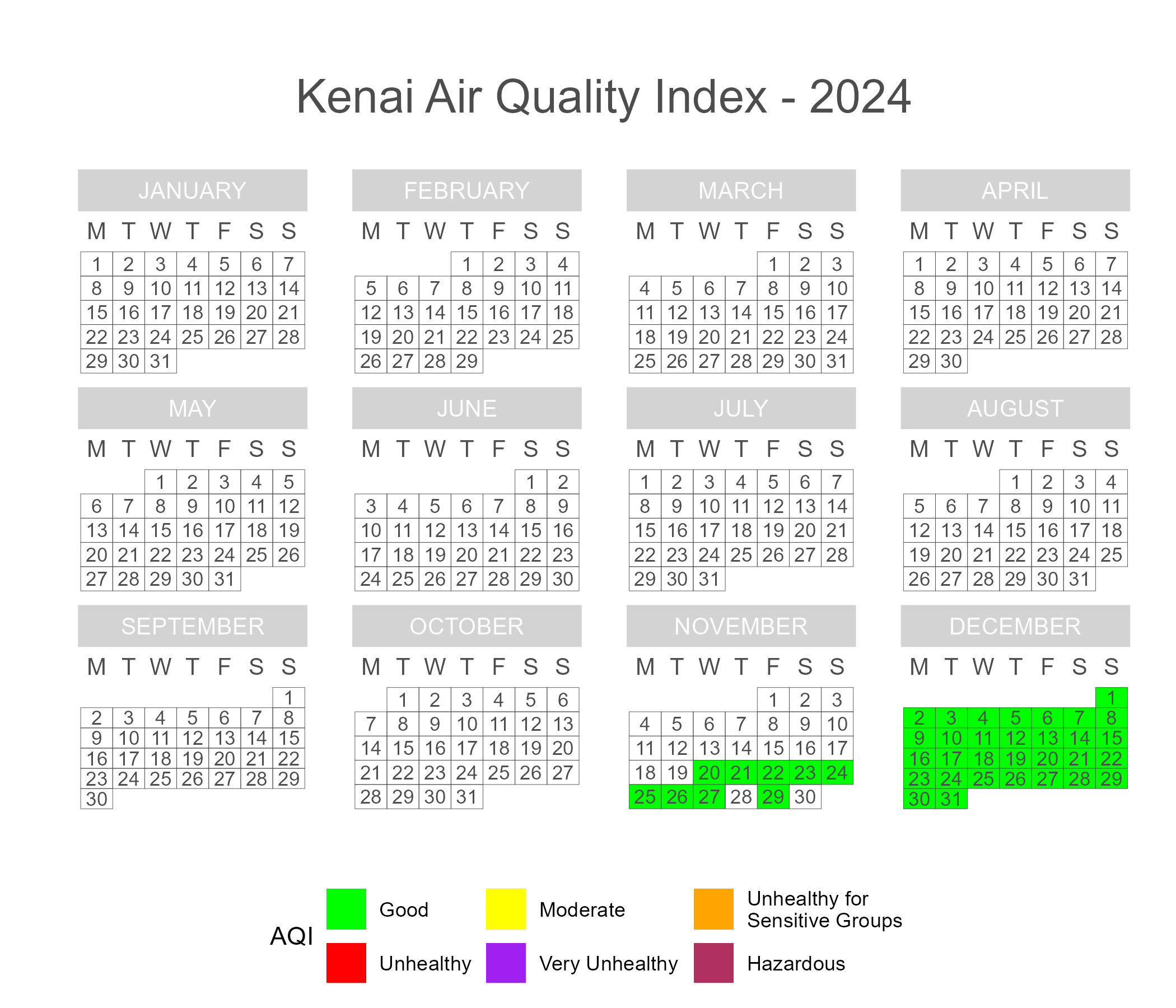
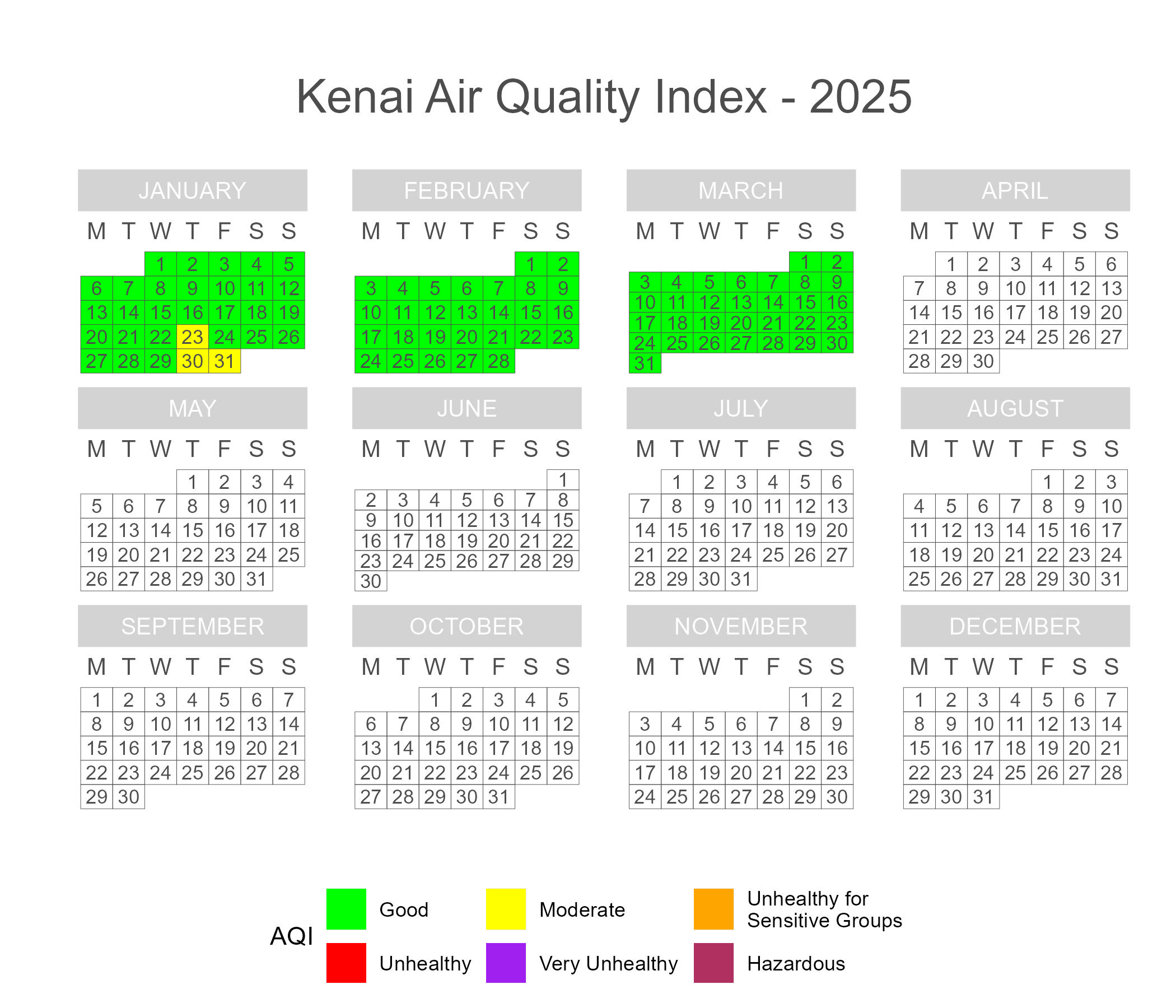
Figure 57 and Figure 58 depict calendar plots for the community of Kenai during the reporting period. The pod was installed November 19th and began calculating daily averages on the 20th. For almost the entirety of the 2024-2025 wintertime reporting period, Kenai enjoyed air quality in the ‘Good’ AQI range, except for a few days in January with ‘Moderate’ (AQI) air quality. The increase in PM2.5 levels observed on January 30th and 31st occurred during a cold spell. PM2.5 spikes occurred throughout the day on the 30th, leading to a large spike early on the morning of the 31st that skewed the daily average into the ‘Moderate’ AQI range. These spikes could potentially be attributed to an increase in home heating use during the cold spell.
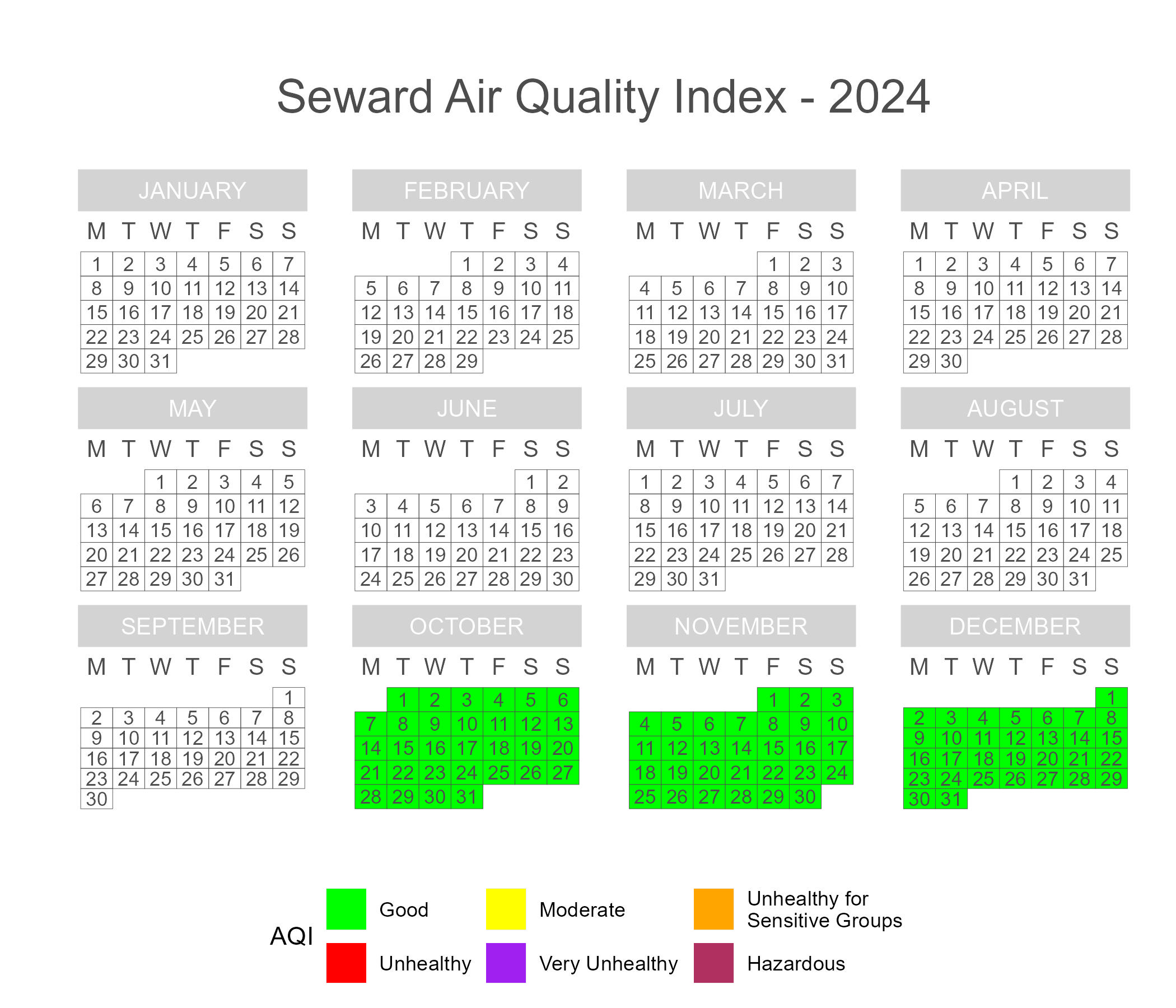
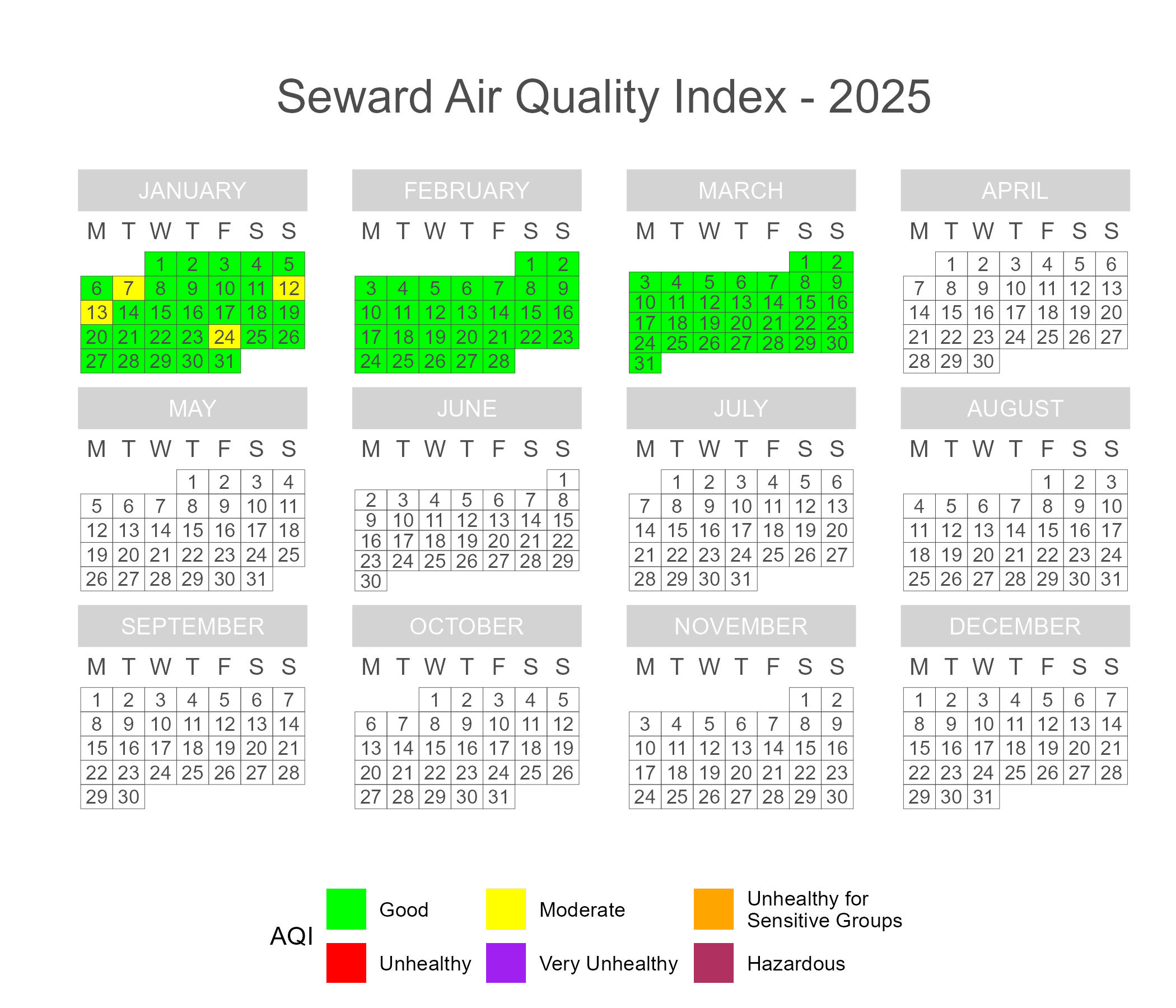
Figure 59 and Figure 60 depict calendar plots for the community of Seward during the reporting period. Seward enjoyed ‘Good’ (AQI) air quality for almost the entirety of the reporting period, except for several ‘Moderate’ AQI days in January. Each ‘Moderate’ AQI day appears to have been affected by a nighttime surge in hourly PM2.5 levels that gradually returned to baseline.
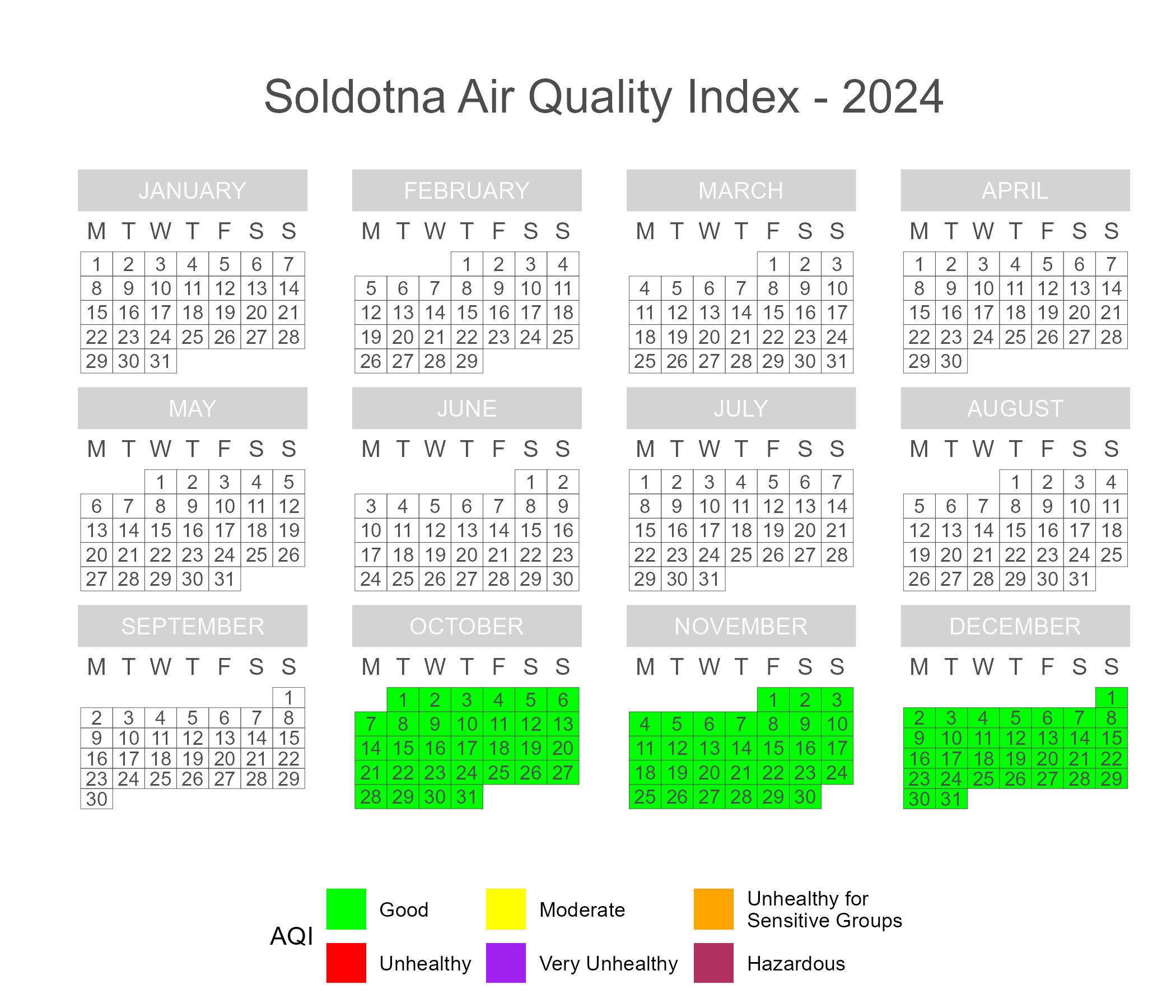
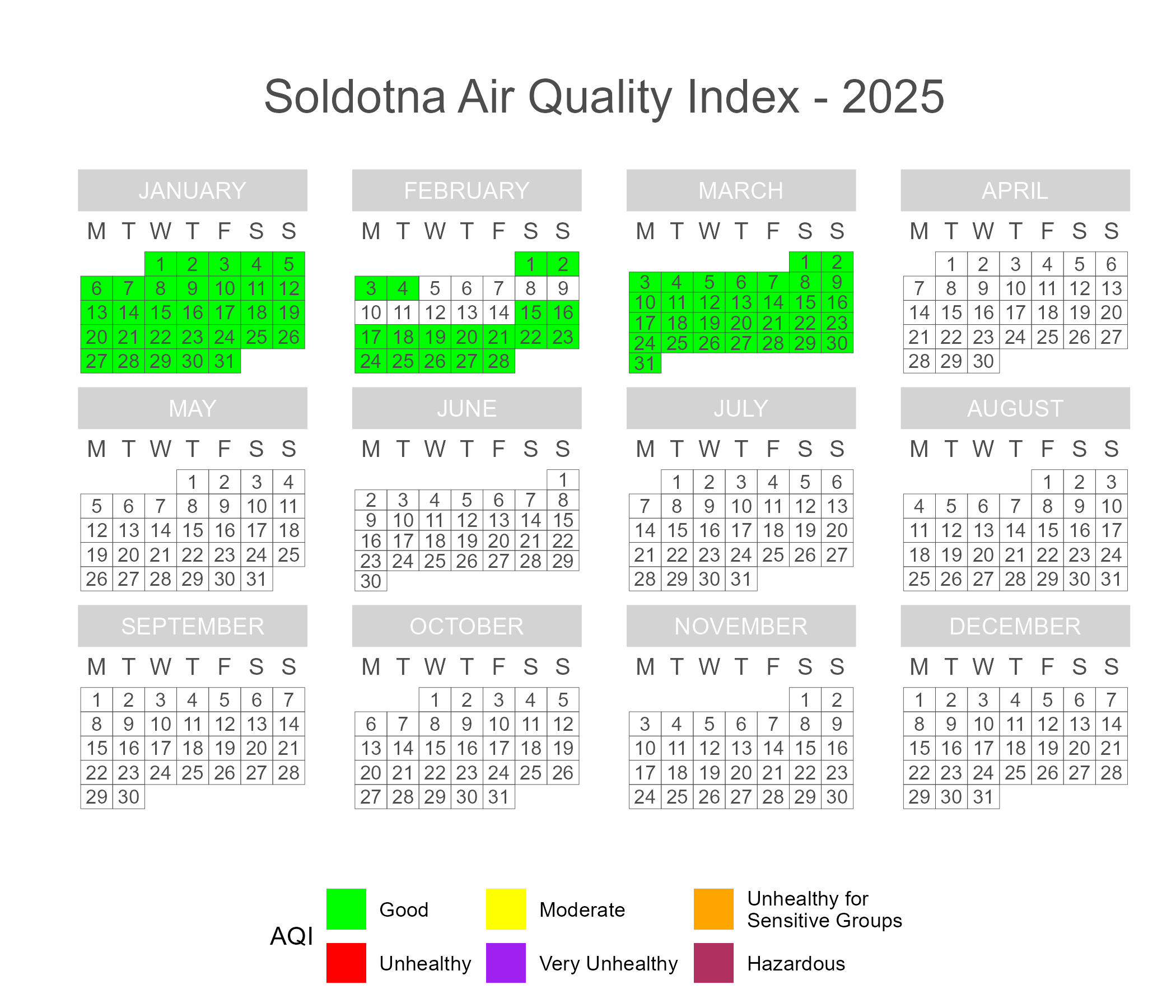
Figure 61 and Figure 62 depict calendar plots for the community of Soldotna during the reporting period. For the most part, Soldotna enjoyed ‘Good’ (AQI) air quality throughout the entirety of the reporting period. There was a 10-day outage in mid-February, caused by technical issues with the PM2.5 and PM10 sensors. Gaseous sensors remained online and operational during the PM sensor outage. Due to the PM sensor technical issues precluding data collection, daily averages for February 5th through the 14th could not be calculated.
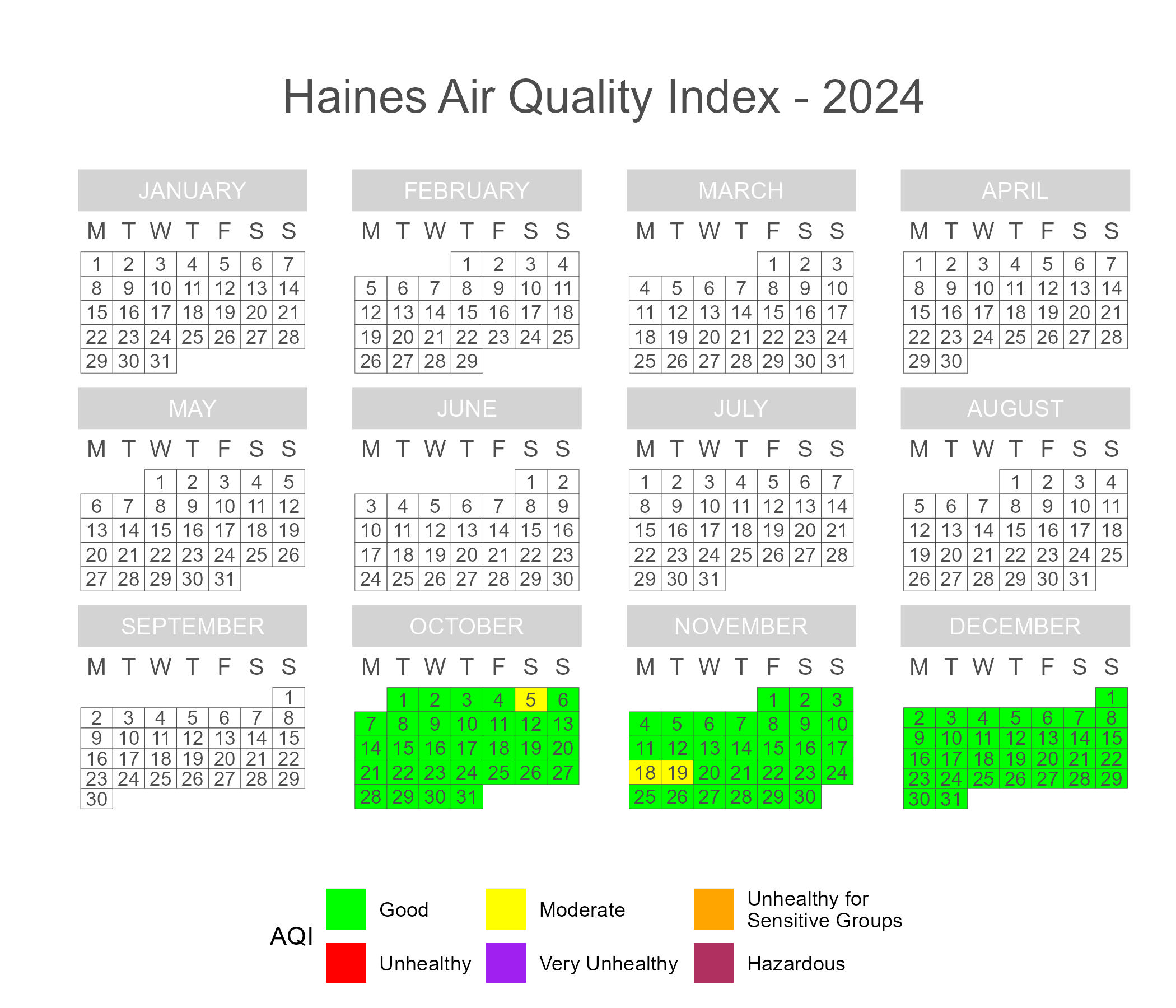
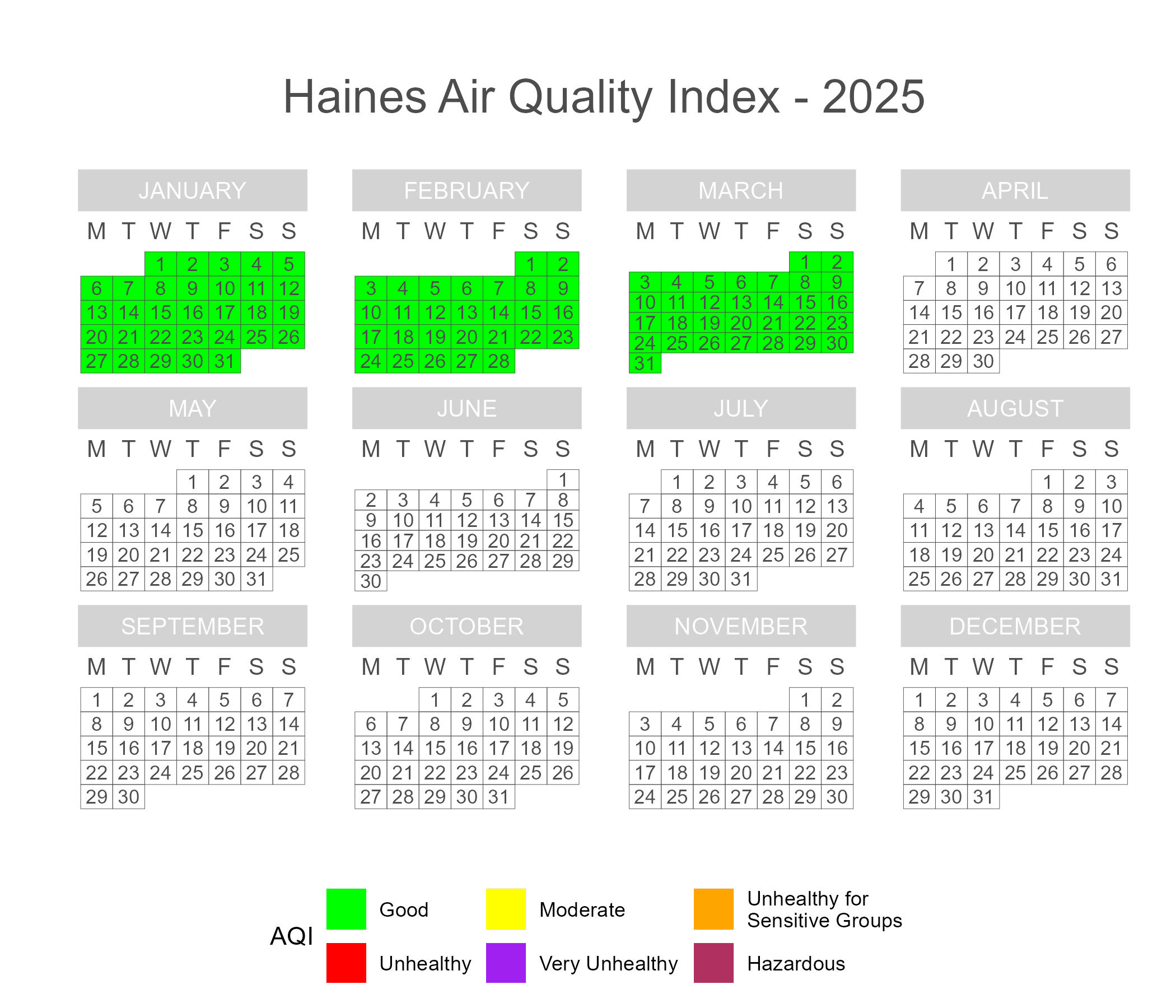
Figure 63 and Figure 64 depict calendar plots for the community of Haines during the reporting period. For most of the reporting period, Haines had ‘Good’ (AQI) air quality. Several days near the beginning of the reporting period had air quality in the ‘Moderate’ AQI range. In the last four hours of October 5th, there was a simultaneous surge in CO, PM2.5 and PM10 levels caused by a large building fire in downtown Haines. In mid-November, Haines experienced a prolonged bout of wind-blown dust. This raised PM2.5 and PM10 levels across multiple days, with November 18th and 19th reaching the ‘Moderate’ AQI range.
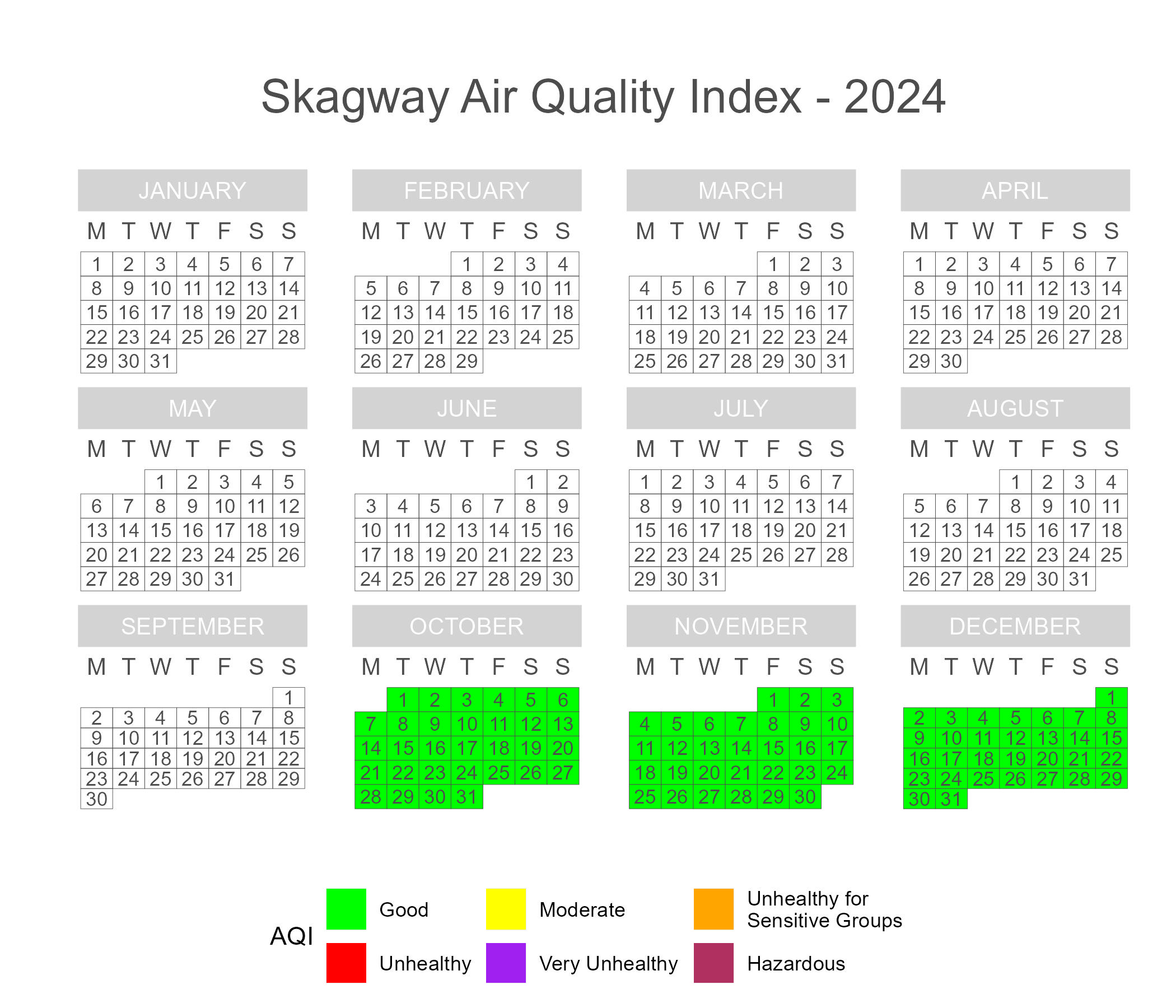
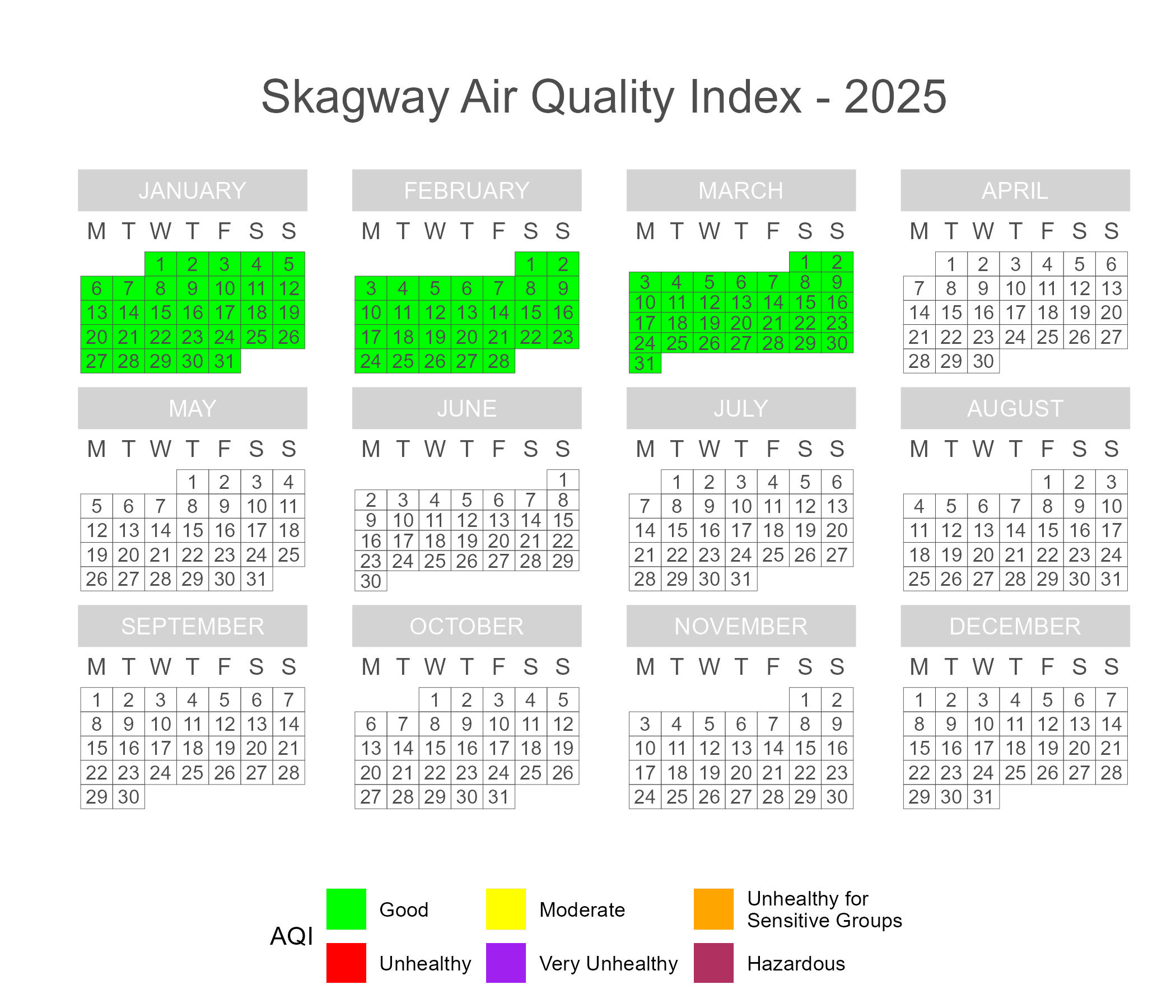
Figure 65 and Figure 66 depict calendar plots for the community of Skagway during the reporting period. Skagway is a very busy tourist destination in the summer but sees little activity in the winter. The Skagway pod measured air quality in the ‘Good’ AQI range for the entire duration of the reporting period.
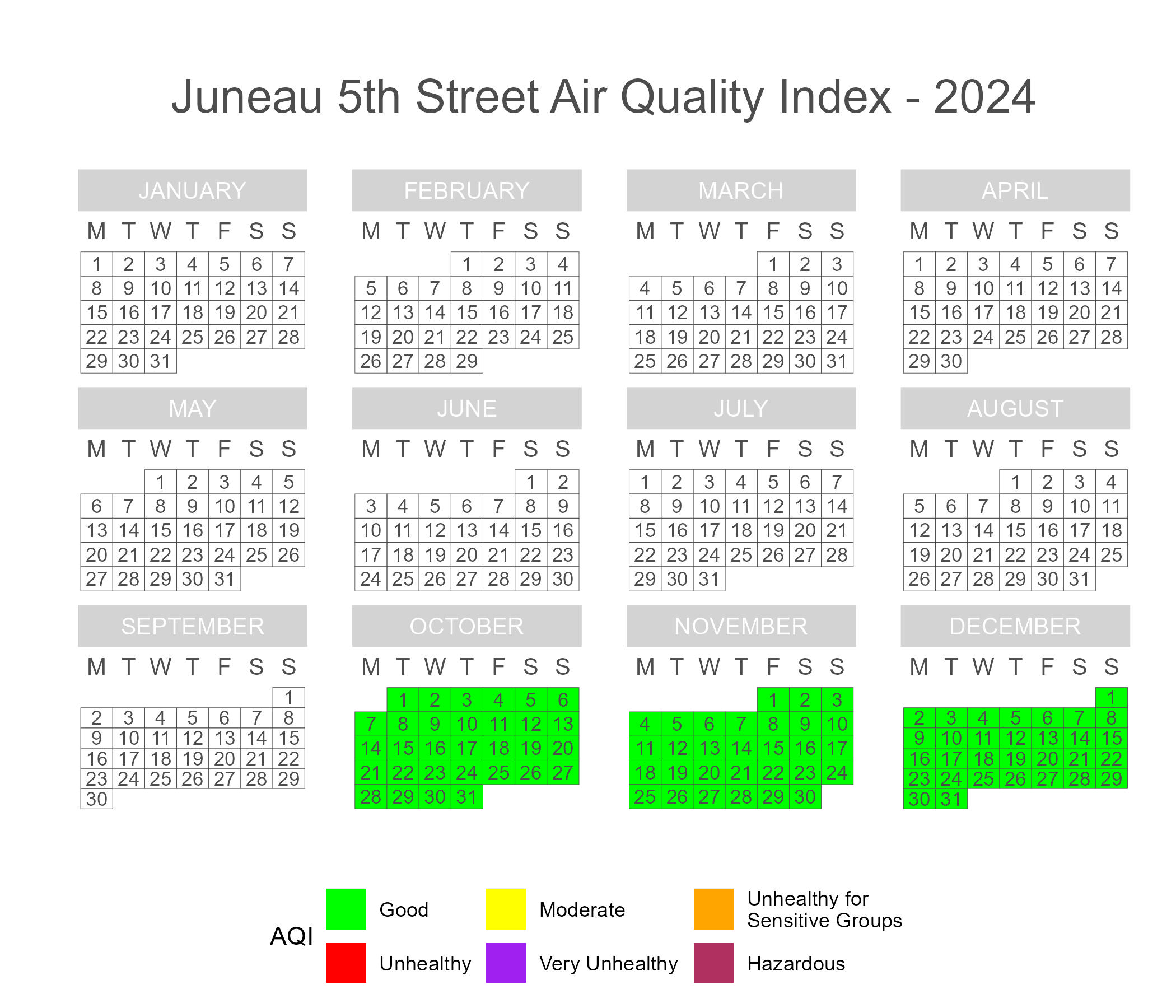
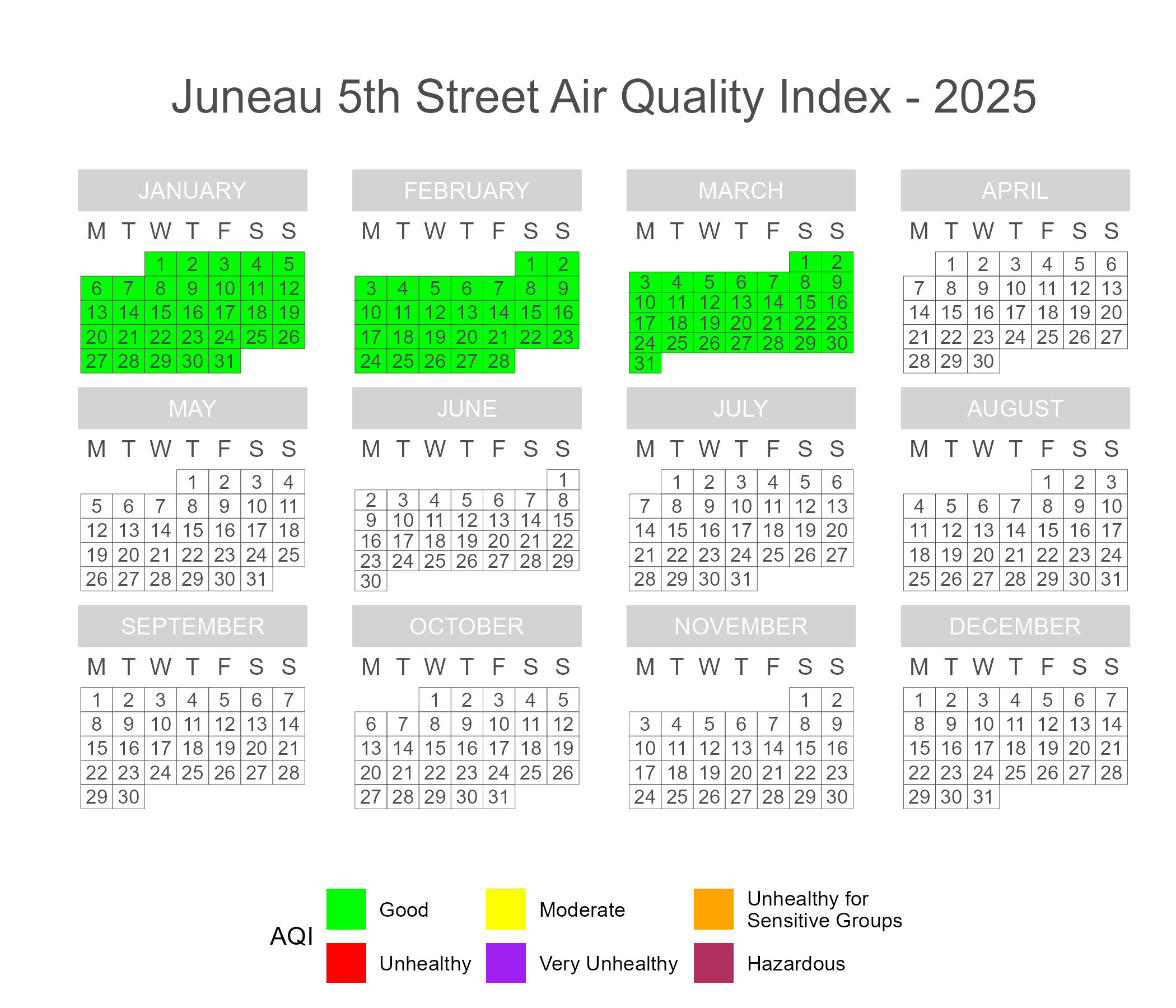
Figure 67 and Figure 68 depict calendar plots for the 5th Street site pod in Juneau during the reporting period. The pod in Juneau at 5th Street measured air quality in the ‘Good’ AQI range for the entire duration of the reporting period.
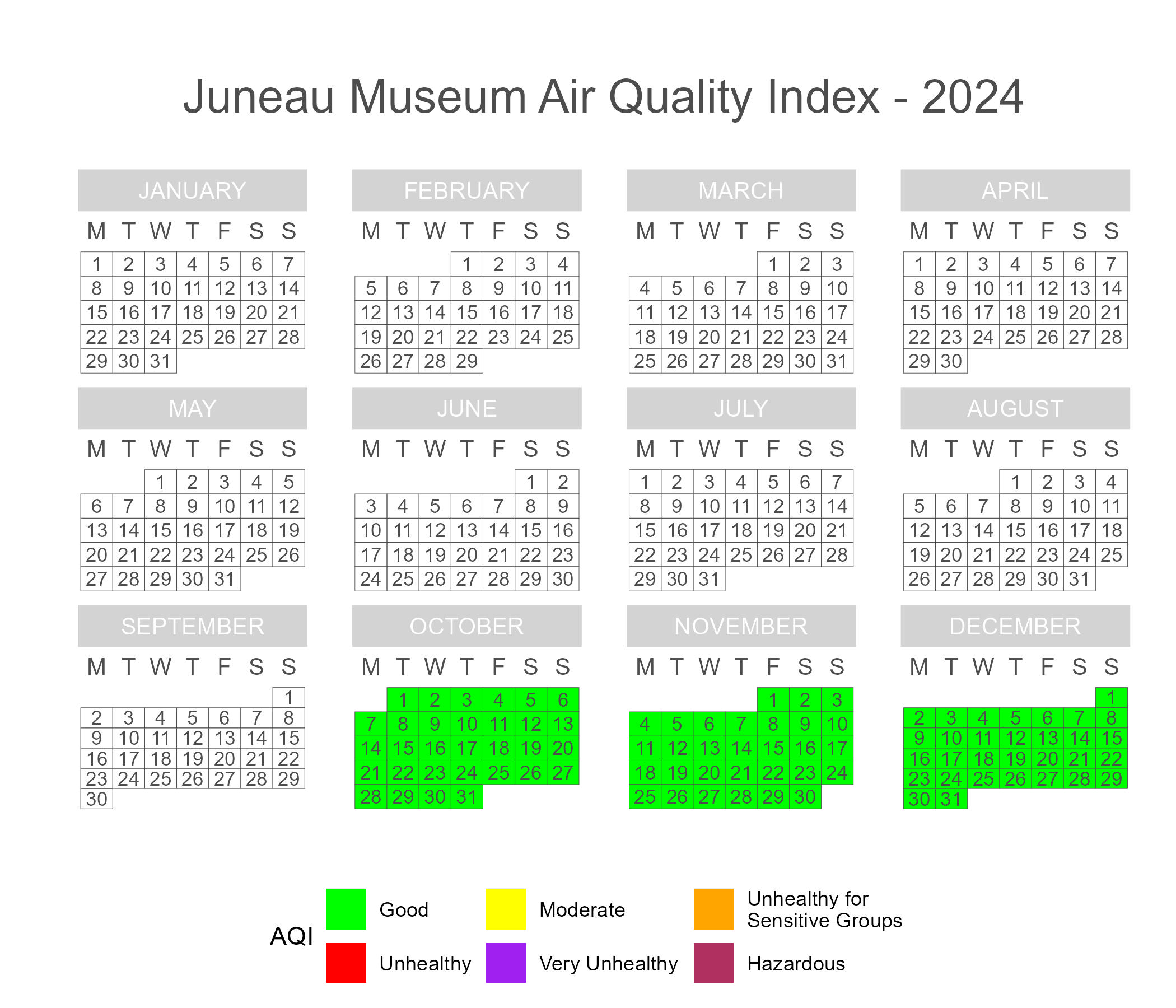
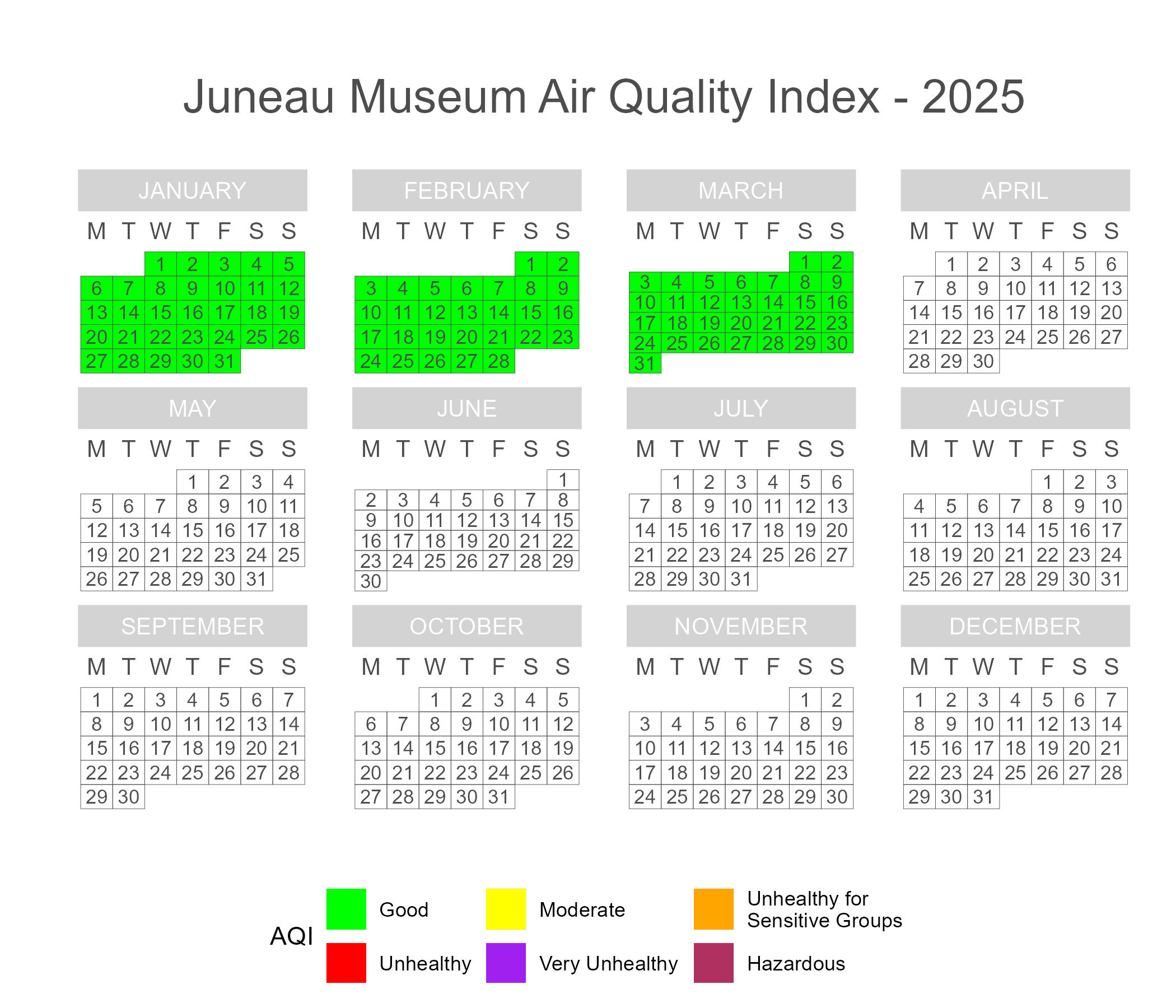
Figure 69 and Figure 70 depict calendar plots for the State Museum site pod in Juneau during the reporting period. The pod in Juneau at the State Museum measured air quality in the ‘Good’ AQI range for the entire duration of the reporting period.
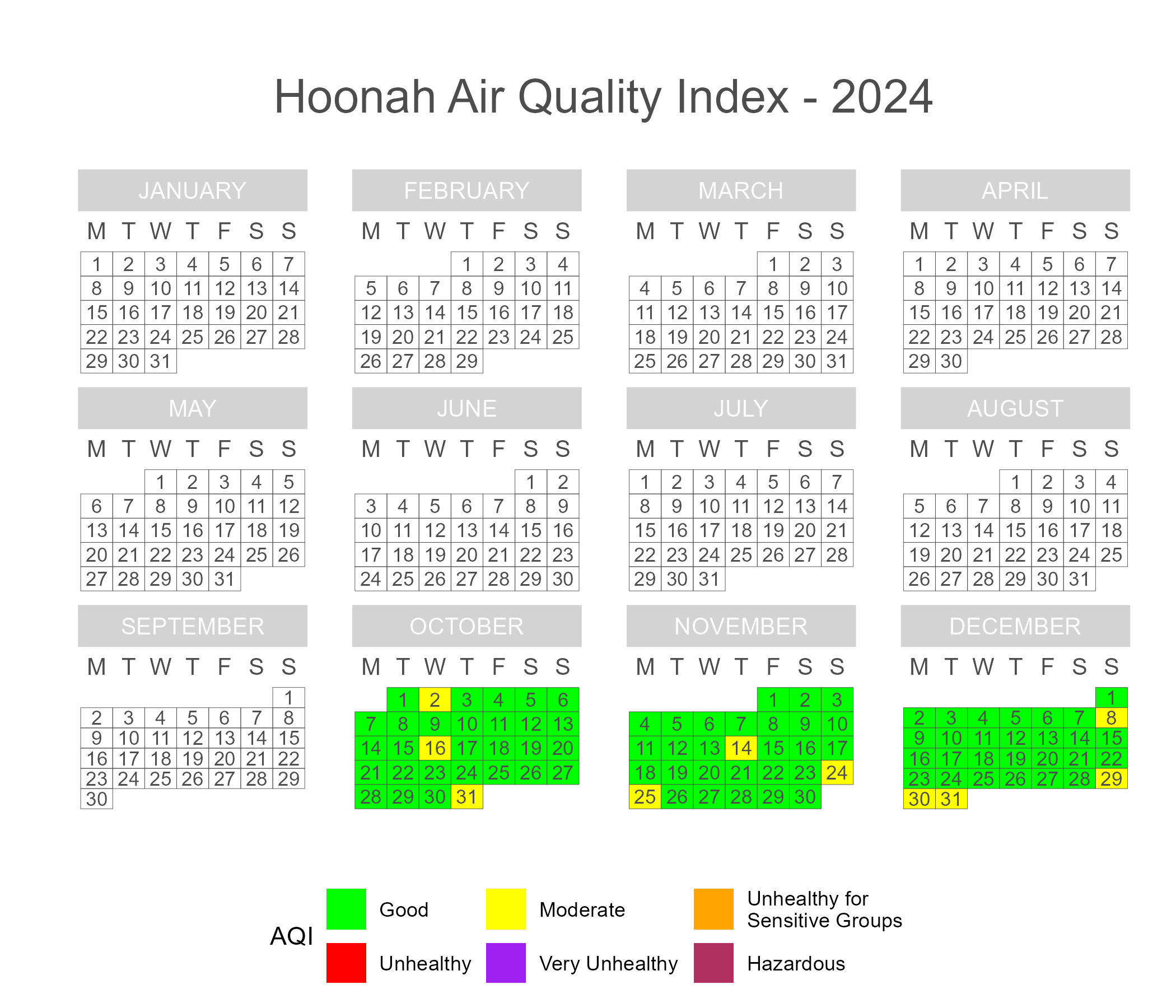
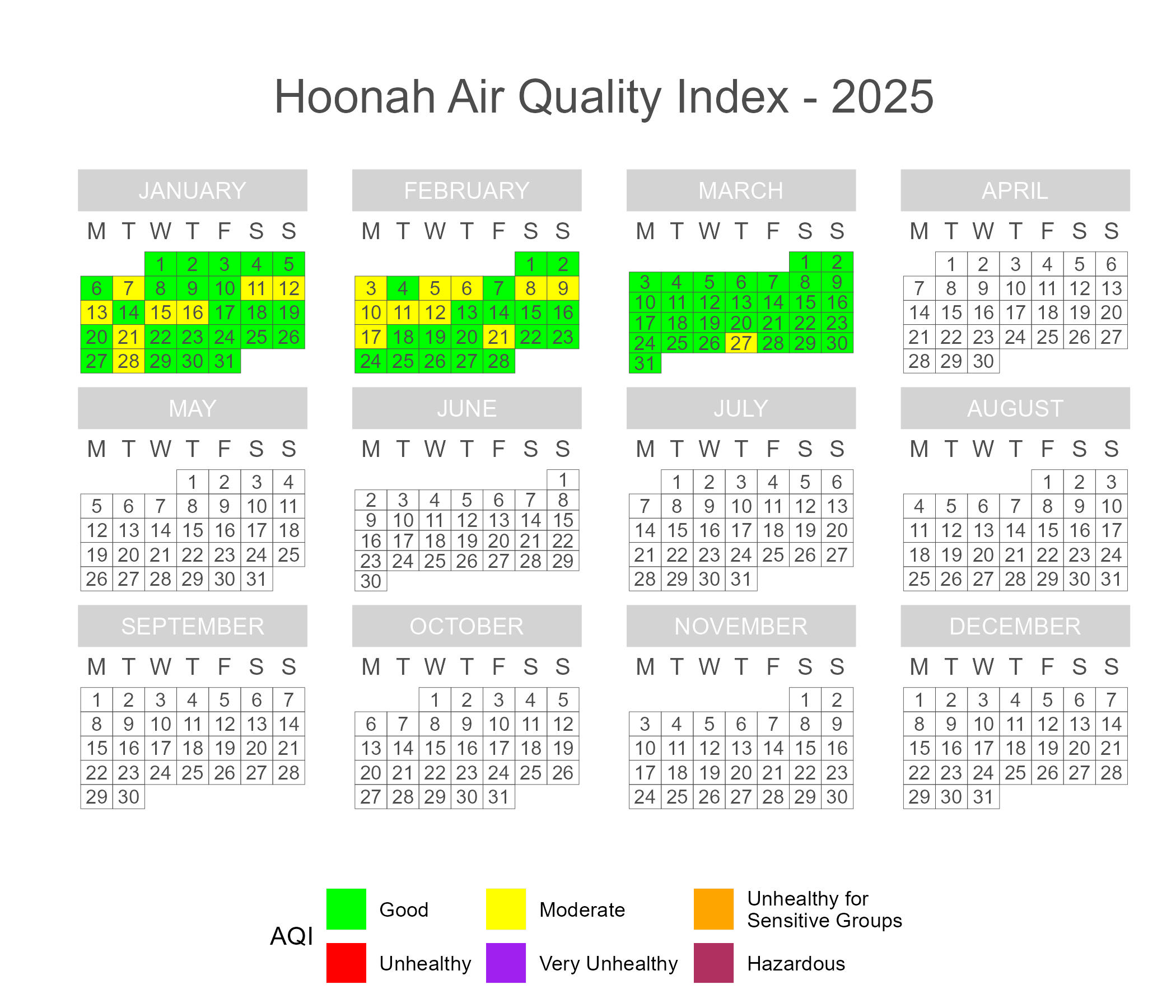
Figure 71 and Figure 72 depict calendar plots for the community of Hoonah during the reporting period. Most days enjoyed air quality in the ‘Good’ AQI range, although air quality frequently entered the ‘Moderate’ AQI range. A community contact reported that on days with little to no wind, they frequently observe smoke, fog, and exhaust fumes lingering in the area. The frequency of ‘Moderate’ AQI days may be partially a consequence of the Hoonah sensor being installed near the chimneys and heating exhaust ports of nearby homes; when home heating activities increase, Hoonah typically sees a rise in PM2.5 levels.
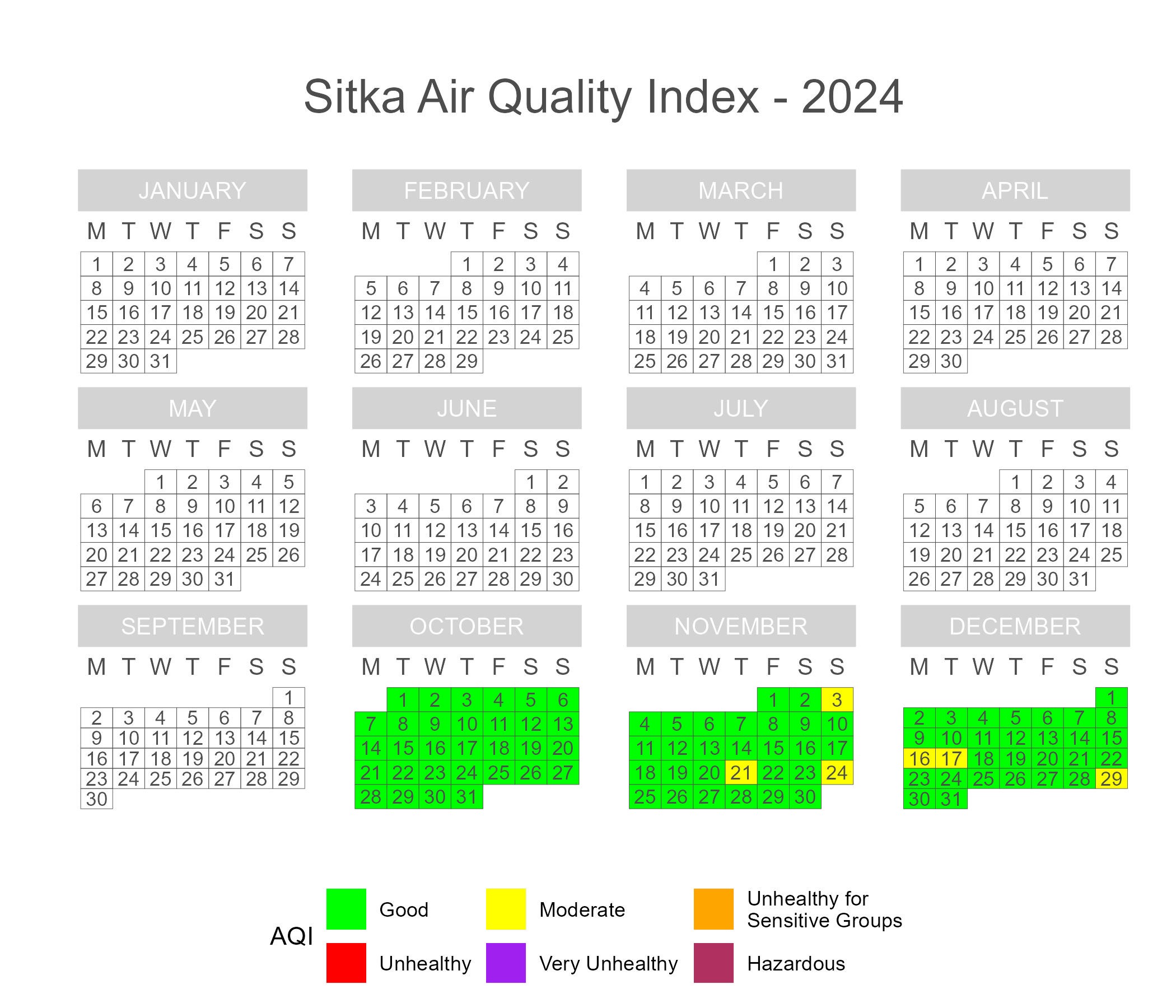
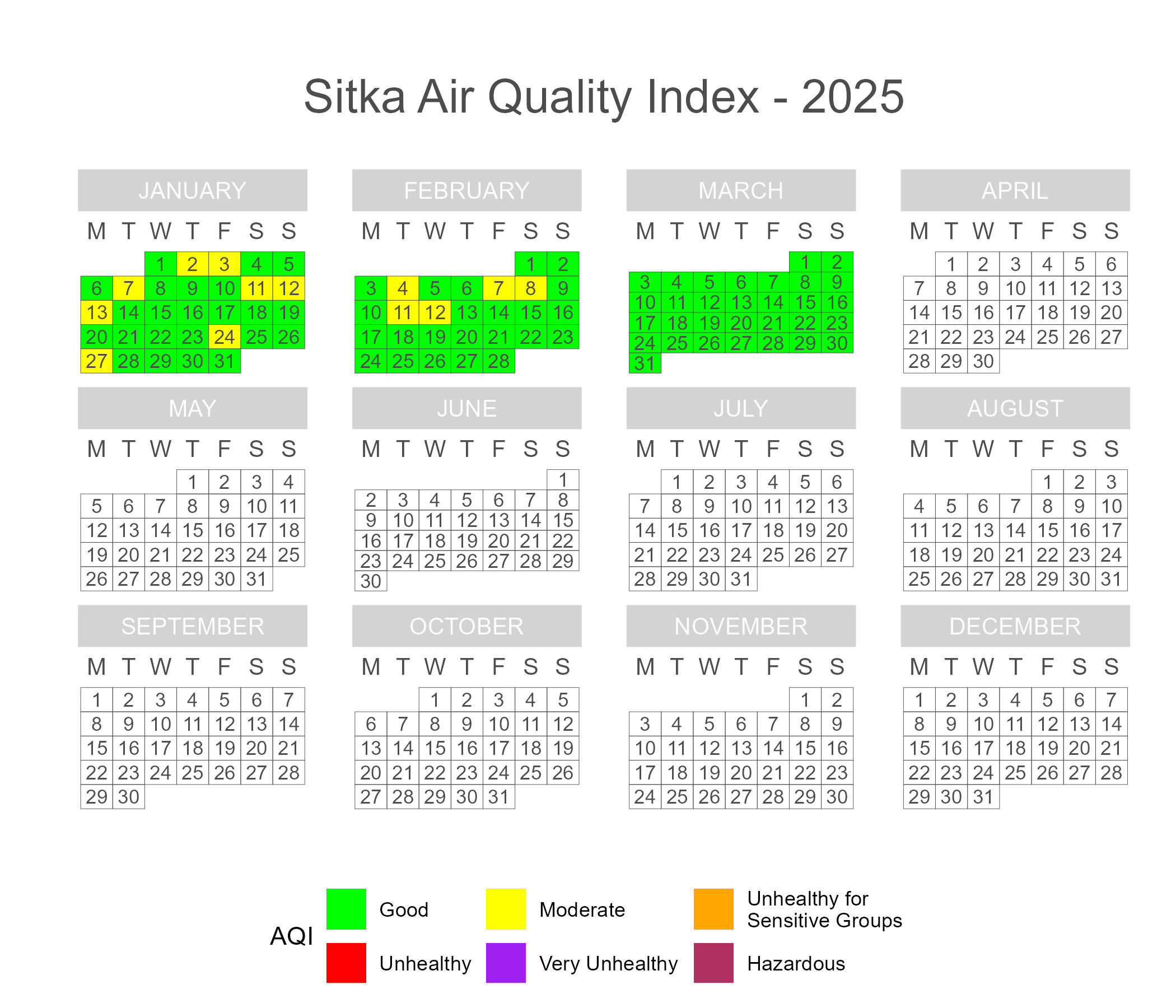
Figure 73 and Figure 74 depict calendar plots for the community of Sitka during the reporting period. For most of the reporting period, Sitka had ‘Good’ (AQI) air quality, with the occasional day in the ‘Moderate’ AQI range. The first two weeks of February had below-freezing temperatures and an increase in home heating use, leading to increased PM2.5 levels and ‘Moderate’ (AQI) air quality.
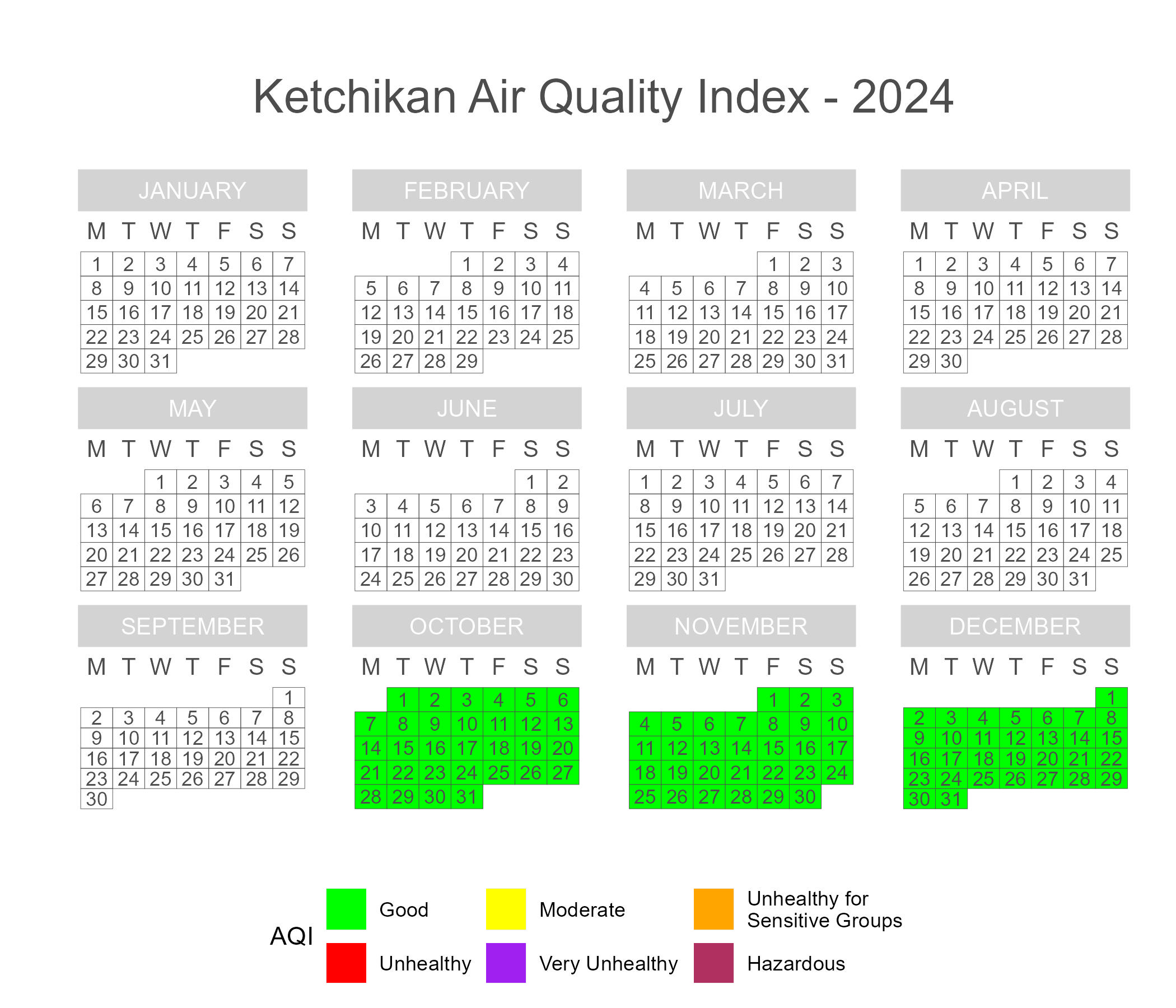
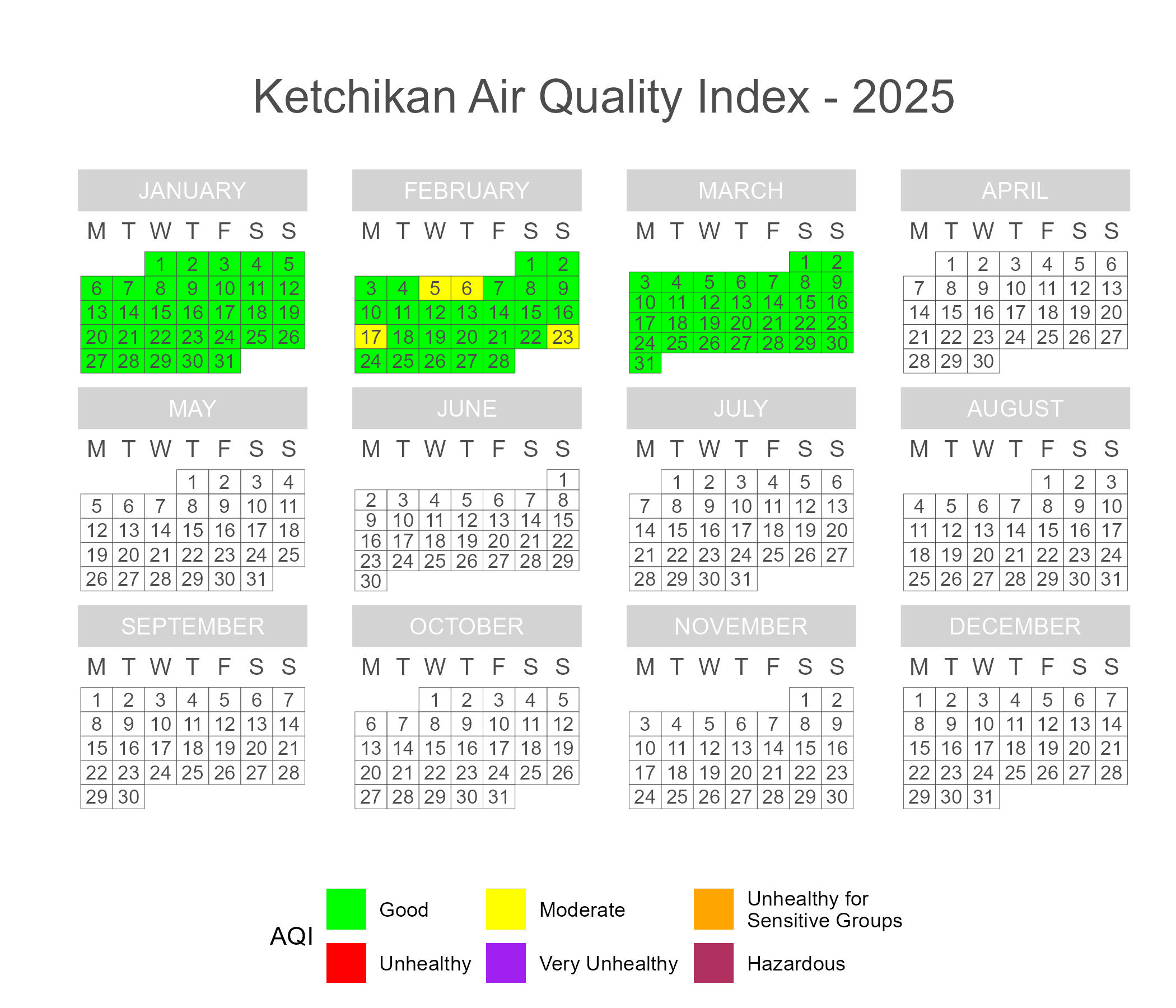
Figure 75 and Figure 76 depict calendar plots for the community of Ketchikan during the reporting period. For most of the reporting period, Ketchikan had ‘Good’ (AQI) air quality with the exception of several days in February. The first half of the month saw consistent below-freezing temperatures and increased PM2.5 levels likely caused by an increase in home heating use. Near the end of the month, Ketchikan enjoyed warmer temperatures and lower PM2.5 levels. February 23rd saw a very brief PM2.5 spike around 9 PM which pushed the daily average into the ‘Moderate’ AQI range, despite PM2.5 levels staying below 7 µg/m3 for most of the day.
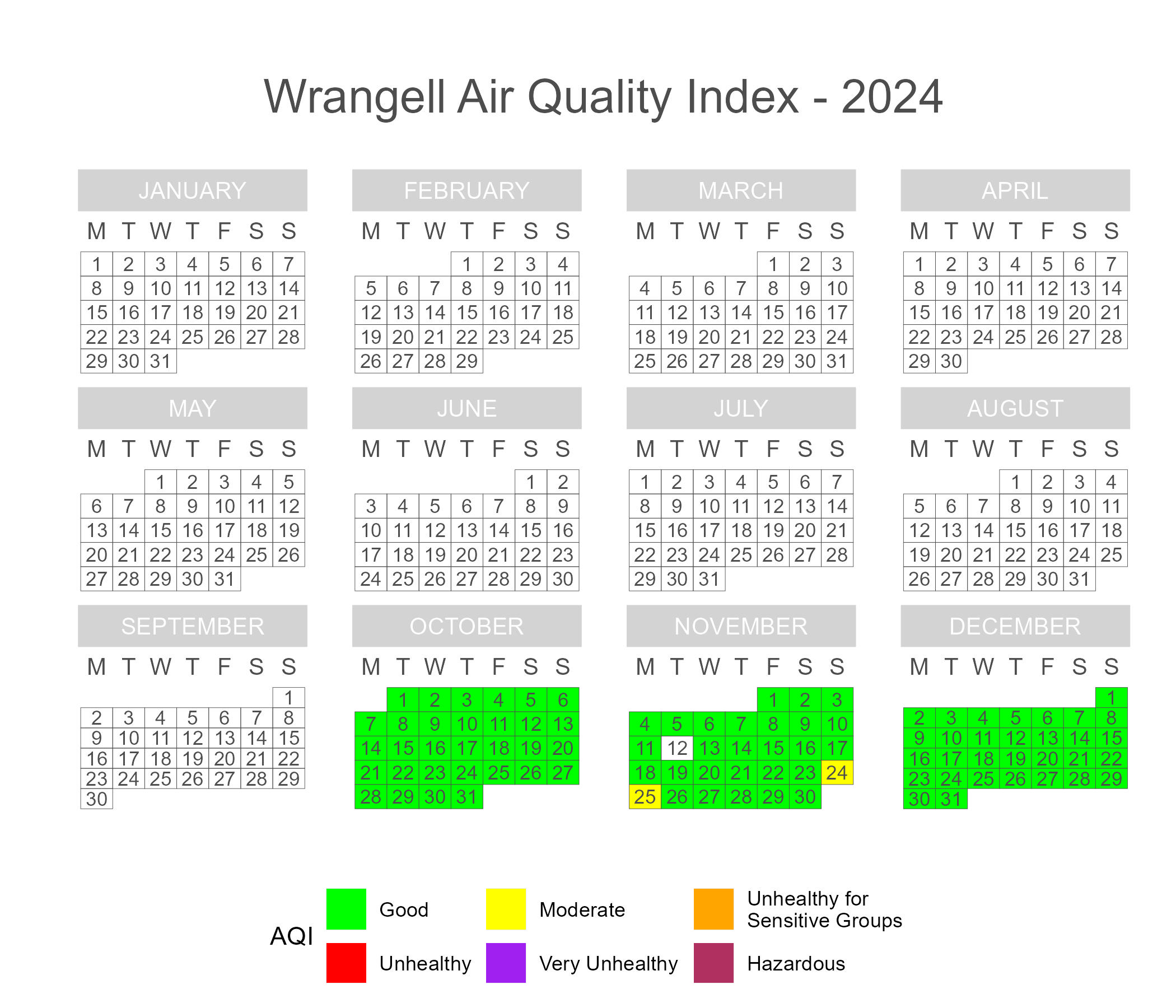
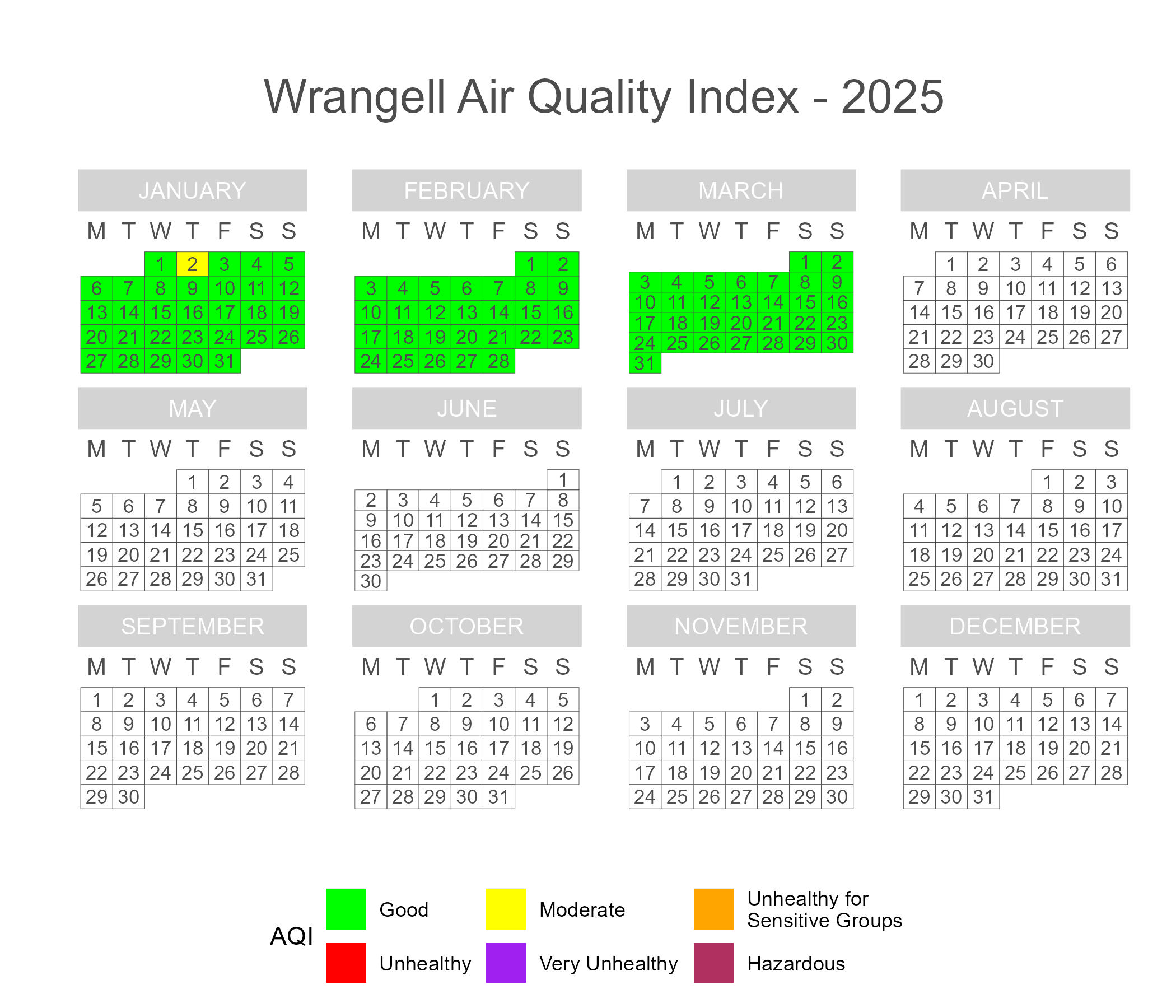
Figure 77 and Figure 78 depict calendar plots for the community of Wrangell during the reporting period. For most of the reporting period, Wrangell had ‘Good’ (AQI) air quality. Wrangell experienced a cold spell near the end of November which was linked with spikes in both PM2.5 and PM10. The increase in PM could potentially be attributed to an increase in home heating use.
On November 12th, the pod experienced technical issues with the PM2.5 and PM10 sensors which prevented the calculation of a daily average. Gaseous sensors remained online and operational during the PM sensor outage.
7 Future Plans
By the end of the reporting period, DEC has deployed a majority of its QuantAQ ModulairTM sensors in communities throughout Alaska. DEC will continue to monitor the pod data feeds to identify erroneous data and hardware issues and will continue working on data analysis and providing meaningful insights and outreach material to participating communities and the public. DEC has continued to track pod performance with the goal of developing a robust, multi-year data set that will enable the observation of seasonal trends and season-associated degradation in performance and data quality. To address network limitations that prevent servicing communities that have limited cellular coverage, DEC is working on researching alternative sensor technology to expand the sensor network.
Community outreach remains an integral pillar of the low-cost air sensor network. DEC has continued to update its publicly accessible AQI website, host quarterly community engagement calls, and provide winter/summer data reports to interested communities. DEC hopes to gain feedback from participating communities and tribal entities in order to provide meaningful data products and analysis and improve community outreach. The next interim report will include data from communities participating in the network between April 1st, 2025 and September 30th, 2025.
Footnotes
-
https://www.epa.gov/pm-pollution/particulate-matter-pm-basics ↩︎
-
Nelson et al., Environmental Health Consults in Children Hospitalized with Respiratory Infections (April 2021)↩︎
-
DEC, Quality Assurance Project Plan, Community-Based Air Sensor Network (December 2023) quality-assurance-plans ↩︎
-
Low-cost sensors are not as reliable as regulatory sensors. To have fewer data gaps in the low-cost sensor network, it is vital to have replacement sensors on hand for when a deployed sensor needs to be swapped out of the field.↩︎
-
DEC, Alaska Community Air Sensor Network 1st Interim Report (December 2024) community-based-monitoring ↩︎

 Indicates an external site.
Indicates an external site.